 |
The Hissem-Montague Family  |
 |
The Hissem-Montague Family  |

These are the descendents of Jesse Hissam's youngest son, Abner, who, though born in West Virginia, moved to Iowa in 1865, at the age of 35. It is the line of my immediate family. Until the researches of the last few years, I never knew there were any other Hissems.
The somewhat disorganized, and spelling challenged, lineage below was taken from a photostat of my Grandmother Hissem's Family Bible that I only found after the death of my parents.
|
Lena Maye Six and Leo Worth Hissem July 28 1920. Children of Leo and Lena Hissem. Alice Pearl Hissem was born April 20, 1922 Greall Gene and Derall Dean Hissem were born Dec 7th 1924. All in Van Buren Co. Iowa Herbert Lozelle Hissem born Oct 4 1929. Arthur Walker Hissem born 1866 Jan 24 Van Buren Co. Son of Abner and Caroline Hissem. Tillie Haney Hissem born Oct 23, 1868. Died Jan 8, 1927, daughter of Francis and Shirly Ann Haney. Leo Worth Hissem born Dec 21, 1891 Davis Co. Gladys Opal Hissem Boekhoff born Oct.21, 1902, Davis Co. Marriedt Leslie Boekhoff Dec 26, 1923. |
Abner's grandfather, David Heysham, originally from Northampton county, in northeastern Pennsylvania, brought his family, including Abner's father, Jesse, out to Westmoreland county, just east of Pittsburgh, in about 1807. Then, just after the 1810 census, they journeyed down the Ohio river to Tyler county, Virginia.
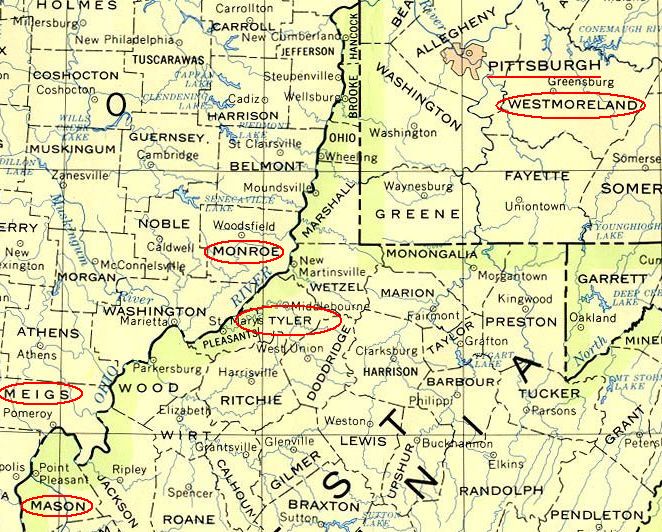
My Second-Great-Grandfather. Abner Hissam, the youngest son of Jesse Hissam and Christine Welker, was born on 8 January 1830 in Tyler county, Virginia; now West Virginia. I have yet to find an official record of Abner's birth; no baptismal record and certainly no birth certificate. His parentage is based on the death certificate of his sister, Eleanor Hissem Lee [extracted below], for which Abner was the informant, so it was what he believed or had been told.
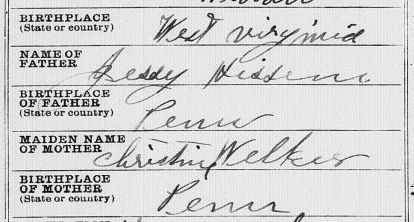
"Hissem, Abner . . . born in Tyler Co., W. Va., Jan. 8, 1830 . . . " - from "The History of Van Buren County, Iowa"I haven't been able to find Abner's father, Jesse Hissem, in the 1830 census. In later censuses for Abner, his father, Jesse, was shown to be of Pennsylvania, of English ancestry, while his mother was of Pennsylvania, and of German ancestry. This first wife of Jesse's died sometime between 1830, when Abner was born, and 1833 when Jesse remarried. Jesse's known wives, his second and third, were Elizabeth Flemming and Elizabeth Reynolds, who look to be of English ancestry.
I do have a record that shows Jesse living in Tyler county, on Big Buffalo Run, in 1833.
Joseph McCoy deeded to "Jesse Hissam 1833 156 A. on Big Buffalo Run." - from the 1833 Deed Book #5, page 16Buffalo Run is a tributary of Middle Island Creek. It begins in the hills just south of Sisterville and flows south, joining the creek a few miles before is loops southeast towards Middlebourne in the map below. There is also a Little Buffalo Run (though no Big) which begins east of Long Reach and flows southeast joining the creek a few miles below where Buffalo Run does, near the town of Little.
Tyler County, West Virginia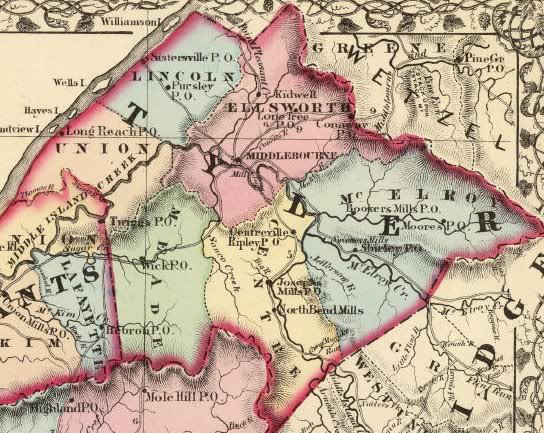
This county, pictured to the right, is located in the northwest of the state with the Ohio River forming its western boundary. Except for the river valley, the county's terrain is hilly and broken. Charles Wells was the first English settler in the area, building a cabin near the present site of Sistersville in 1776. The town, founded in 1815, was named after Charles' two daughters, Sarah and Deliah. A ferry across the Ohio, built in 1818, ensured the town's early success. In 1820, the first census of the county showed a population of 2,314. The economy depended almost entirely on agriculture until the 1890s when a great oil and gas boom developed. This boom lasted for a little over a decade after which the population began to decline. |
In the 1840 census of Tyler county [no township specified], Virginia, Abner's father, Jessee [sic] Hissem, had three sons; 1 born between 1810 and 1820, Levi, and 2 born between 1825 and 1830, Thomas and Abner. The surname can be read as either Hissam or Hissem. They were living next to John G. Morgan, whose daughter married Jesse's eldest son, Levi.
In the 1850 census of District 61, Tyler county, Virginia as Abner Hissam, a 20 year old farmer, born in Virginia. He was still living at home with his parents, and his sister Eleanor. District 61, unfortunately, covers the entire county.
"19 937 908 Hissam Jesse 55 M Farmer 2,000 PennsylvaniaEleanor and Abner had a separate "dwelling-house," but were listed as being of the same family. I suspect that Jesse had built a new house on his farm and his children occuped the old home, a kind of transition to adulthood.
20 937 908 Hissam Elizabeth 53 F Virginia
21 938 908 Hissam Eleanor 23 F Virginia
22 938 908 Hissam Abner 20 M Farmer Virginia" - from Tyler County, VA 1850 Federal Census
Legend: Line number, House number, Family number, Last name, First name, Age, Sex, Occupation, Property Value, Birthplace

In the fall of 1850, that is just after the census above was taken, Abner, still a bachelor, moved to Meigs county, Ohio. This is down, and across, the Ohio river from Tyler county. Abner's father, Jesse, also moved to Meigs county. Abner's brother, Thomas, settled just across the river, in Mason county, Virginia. I don't know when these latter moves occurred, my only evidence is the 1860 census, but it was probably at the same time Abner moved.
"Hissem, Abner . . . fall of 1850, moved to Meigs Co., Ohio . . ." - from "The History of Van Buren County, Iowa"
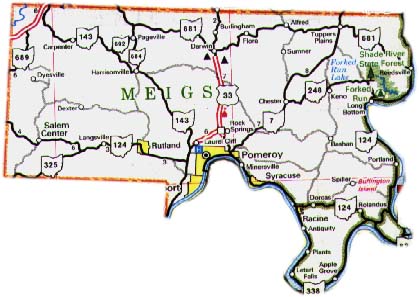
Two years after moving to Meigs county Abner Hissam married Serena Sayre, of Meigs county, the daughter of Robert and Martha Sayre, on 26 February 1852.

"Abner Hissum [sic] to Serena Sayre: The State of Ohio, Meigs County - This is to certify that on the twenty sixth day of February 1852, I joined in marriage Abner Hissum & Serena Sayre, by virtue of a license for that purpose (signed) Isaac Reynolds M. of the G. [Minister of the Gospel] A true copy" - from "Ohio Marriages" at familysearch.orgSerena was born on 6 October 1823 [she was seven years Abner's senior], in Ohio, the daughter of Robert and Martha (Jones) Sayre [sometimes Sayer] - from the "Sayre Family" by Theodore Melvin Banta.
"2739. Serena Sayre was born 6 October 1823. She was with Harrison and Hannah Parr when the 1850 census was taken [Hannah was a Sayre, probably Serena's sister]. The census taker spelled her name "Cyrene." She married (by Isaac Reynolds, MG) in Meigs County, Ohio, 6 February 1852 Abner Hissum (Mar. Vol. 1, p. 459). This name has been spelled with many variants, i.e., Hissam, Hissim, Hissem, and Hissom. Abner Hissem (Hissum) was born in Tyler County, (West) Virginia 8 January 1830. After their marriage, they lived in Letart Township, Apple Grove post office. Serena (Sayre) Hissem died 9 April 1861. Abner married 2nd, in Meigs County, Ohio, 27 April 1862 Caroline Walker. They moved to Van Buren County, Iowa in 1865. Theodore Banta in his SAYRE FAMILY reported "no children." Children of Abner and Serena (Sayre) Hissem:Serena's father, Robert Sayre, was born on 29 January 1788 and married Martha Jones in 1812. He was a farmer in Letart township, Meigs county, Ohio, where he died on 4 August 1829. The following is also from Ralph Sayre, a modern day descendant.
1. Thomas Jefferson Hissem, b. about 1853 Ohio. May have died about 1861.
2. Serena Jane Hissem married Lloyd Alonzo Nicklin.
Child of second marriage:
3. Arthur W. Hissem, b. 1866 in Van Buren County, Iowa. Married twice. d. 1936. Buried in Troy Cemetery, Davis County, Iowa." - from the "Sayre Family: Another 100 Years" by Ralph Sayre
"Robert Sayre, son of John and Susannah Sayre, was born 29 January 1788 in Monongalia County, Virginia. It seemed probable that Susannah Sayre would have named her first son for her father. Robert Sayre married 12 March 1812 (Gallia County, Ohio, Marriages) Martha Jones who was born 26 September 1794 to Seth and Sarah (Pitts) Jones. Robert was a farmer in Meigs County, Ohio, where he died. Meigs County, Ohio, Probate Records, Files 212 and 932 indicate 2 August 1827 as his death date. His will was probated 24 September 1827. Martha was listed in the 1840 Meigs County census with a male and four other females in the household. Martha died 16 June 1843. Burial was in Letart Falls Cemetery, Meigs, Ohio."
Banta uses the Hissom spelling for Abner and indicates that the couple left no children, but per the above they had a surviving daughter, though I differ as to her real given name. See the Heysham-Sayre Family page for another, earlier connection with the same Sayre family. After their marriage the couple lived in Letart Township, Apple Grove post office, in the southeast corner of the state. This was where Serena's father resided. Abner's father, Jesse, lived just up the river in Lebanon township.
| The Sayre Family of Ohio
This part of the family descends from the same Thomas Sayre who was a founder and one of the first settlers of Southampton, Long Island. Francis Bowes Sayre, who founded the Heysham-Sayre line, also descends from Thomas. |
In the 1860 census of Apple Grove, Letart township, Meigs county, Ohio as Abner Hissam, a 30 year old farmer, born in Virginia. Living with him were his wife, Serena, 37, and Thomas, 7, both born in Ohio. Serena's parents were near-neighbors. Abner had real property worth $2,500 and personal property worth $200. At this time Abner's father, Jesse, had also moved to Meigs county, living east of Abner, just beyond Great Bend, in the map below.
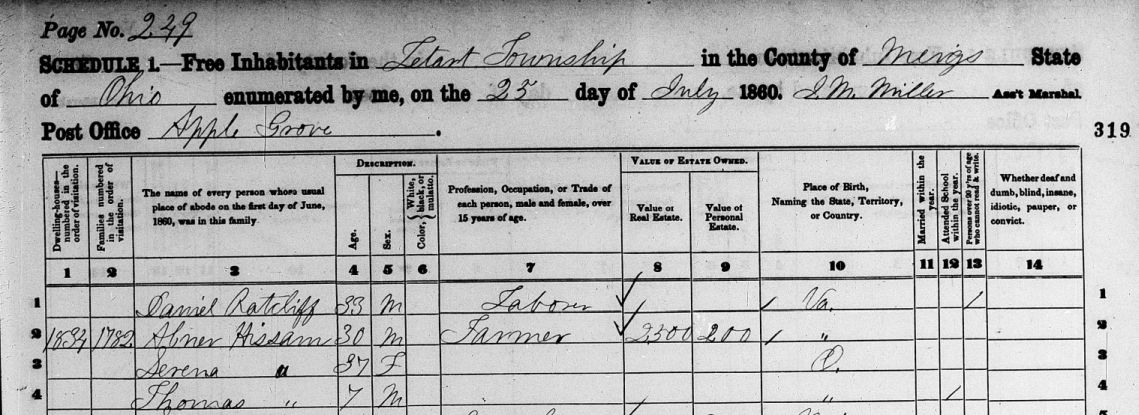
The couple had a second child, a daughter, in January 1861. Then, on 9 April 1861, Abner's wife, Serena, died of unknown causes.
"Hissem, Abner . . . He married Serene Sayre Feb. 29, 1852, a native of Ohio; [she] died April 9, 1861; had two children--Serene J., still living;" - from "The History of Van Buren County, Iowa"This may have been during the birth of their daughter, Martha J. [who later took the name Serena], who was born in 1861. Abner's son, Thomas, also died about this time. They appear to have both been buried in the McKay cemetery, Great Bend, Meigs county, Ohio.
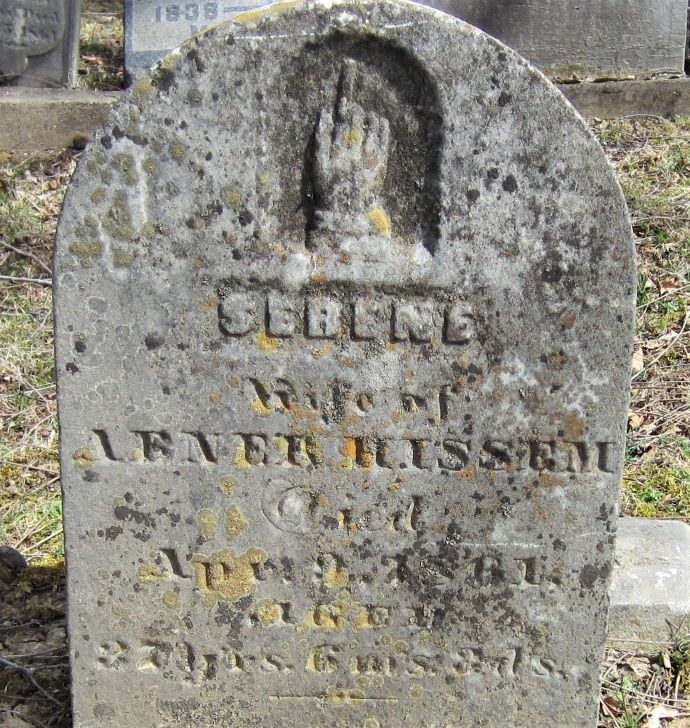
Abner married Caroline Walker just a year later, on 24 April 1862 . . . he had a young daughter that needed a mother.
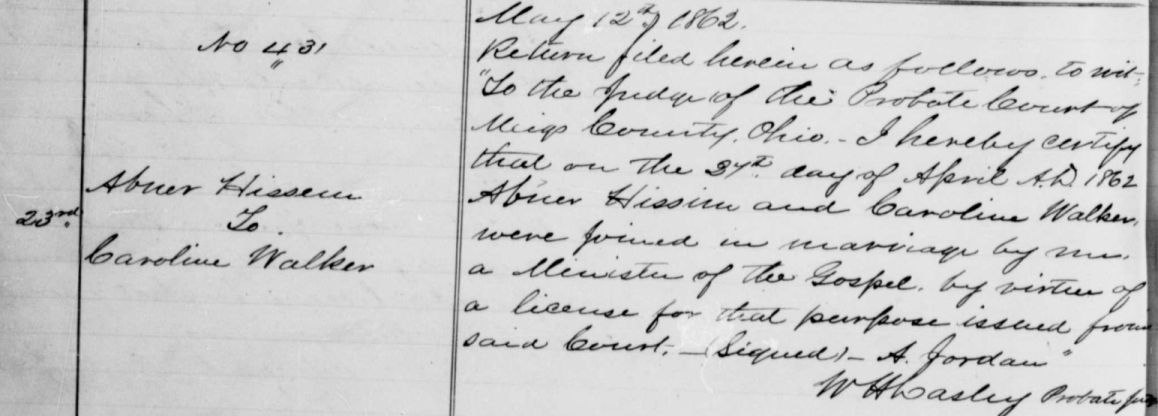
Caroline was born on 29 June 1832 in Meigs county, Ohio. In the 1850 census of Chester township, Meigs county, Ohio as Caroline Walker, 17, living at home with her parents, Obadiah and Cassandra, and siblings Melissa, Vincent, and Obadiah Jr. In the 1860 census of Lebanon township, Meigs county, Ohio as Caroline Walker, a 28 year old school teacher, living with her brother, Vincent, and his young wife. Also living in the house were her older sister, Melissa, and brother, Obadiah Jr. By the way, read the "Anne of Green Gables" series of novels for an explanation of how young women, recent graduates, served as school teachers before marrying.
"Hissem, Abner . . . he married Caroline Walker April 27, 1862; she was born in Meigs Co., Ohio, June 29, 1832; have one child--Arthur W." - from "The History of Van Buren County, Iowa"Another document states,
"Caroline Walker was married to Abner Hissim, of Tanner's Run, Ohio, but later they removed to Iowa." - from "The Pioneer History of Meigs County" by Stillman Carter Larkin
| The Walker Family |
Tanner's Run is a river (creek?) that empties into the Ohio river. The creek is northeast of Letart township. A web post by a canoe enthusiast, James DiNardo, states,
"Tanners Run now enters the Ohio at mile 228 amid what has to be the most spectacular farmland scenery I've seen on the river yet. Particularly striking is that this scenery is actually visible amid the rolling hills! Usually the land is so flat and the shoreline trees are so dense that I can't make anything out. Such was not the case here! As for Tanners Run, it went back about 500 yards and it was incredibly pleasant too - especially after I passed under a somewhat ominous looking culvert for Route 338."




The one great event of the Civil War for Meigs county, and the only significant engagement fought in Ohio, was the Battle of Buffington Island, on 19 July 1863. Union forces had been chasing Confederate General John Hunt Morgan. He had been raiding through Indiana and into Ohio, hoping to divert forces from the Union advance into Tennessee. After a series of running skirmishes across the width of southern Ohio, Union forces caught up with Morgan at Portland, Ohio, northeast of Tanner's Run. Morgan sought to cross the Ohio river at this point, but was stopped by three Federal gunboats. Confederate forces were surronded by Union cavalry resulting in a Confederate rout. Morgan escaped with 700 men, but was forced to surrender seven days later after the Battle of Salineville. The raid had been of little military value, but spread terror among the population of southern and eastern Ohio.
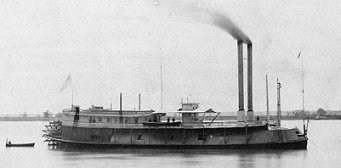 One of the interesting sights Abner would have been able to see from his farmstead during the war would have been the Federal gunboats patrolling the Ohio river. At right is one of those ships, the ST. CLAIR.
One of the interesting sights Abner would have been able to see from his farmstead during the war would have been the Federal gunboats patrolling the Ohio river. At right is one of those ships, the ST. CLAIR.
Abner owned and operated a sawmill in 1863 and through 1864, probably on Tanner's Run.
"Hissem, Abner . . . he owned and operated a sawmill in Meigs Co., Ohio." - from "The History of Van Buren County, Iowa"Below is a reproduction of an 1863 painting of a rustic sawmill.

In the spring of 1865 Abner followed his older brother, Thomas, and moved his family to Van Buren county, Iowa, where they settled near the community of Doud's Station, on the Des Moines river.
"Hissem, Abner, farmer, Sec. 5; P.O. Doud's Station; . . . spring of 1865, to Van Buren Co., and settled on his present farm; . . . Mr. Hissem has 240 acres of land, valued at $8,000." - from "The History of Van Buren County, Iowa" 1887Note that the Civil War ended in the spring of 1865, in May. In 1865 Abner Hissum, 35, and Thomas Hissum, 37, of Chequest township, Van Buren county, Iowa were noted in the "Abstract of the number of persons subject to Military duty in Van Buren County Iowa for the year 1865."
Abner's sister Eleanor also appears to have come along to Iowa, making a real caravan with the Nicklins, as well as Caroline's siblings, Vincent & Melissa Walker. I think the Gorrells may also have come along, though I haven't been able to prove this. I believe their surname was the source of my uncle Garrell Hissem's given name [grandma was always a poor speller]. I have recently noted a Reverend Isaac H. Gorrell family coming into Jefferson county, Iowa [where the young Lena May Six Hissem lived] from Illinois. Perhaps there's a connection with the Six family. The Sixes lived in Locust Grove in Jefferson county, which is just 15 miles north of Douds/Leando. Later they seemed to have lived in Selma, Davis county, just upriver from Douds/Leando.

Abner and Caroline settled on a farm in Chequest township, on the western edge of Van Buren county, with a mailing address at the Doud's Station post office. Douds is on the Des Moines river, in the northwest of the county. A son, Arthur, was born early in 1866.
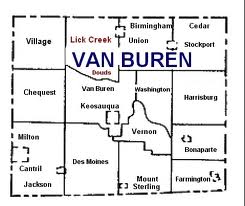
Below are the plat maps for Village and Chequest townships. The town of Leando was shown at this time as Portland.

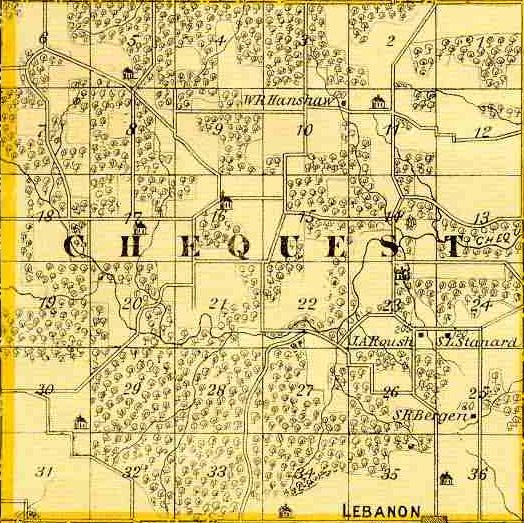
The families of Thomas and Abner Hissem settled just southwest of Leando, across the river from Douds Station, and had mailing addresses at the Doud's Station Post Office. There is a Hissem-Haney cemetery in Section 5, Chequest township, southwest of Leando, on 167th road, between Acorn and Bethel Rock, which approximates the location of Abner's farm. However, while there is one Haney buried there [see below], none of the identified burials are for Hissems. Tombstones cost money, so this isn't really surprising.
On the map above, Abner's farm was west of the building shown in Section 5, on both sides of the diagonal road. The farm of his brother, Thomas, was at the southeast end of the diagonal road, just where it turns south.
Note that in the plains states, which included Iowa, the government surveyed a six mile square as a "township" which was then broken into 36 one-mile squares, called "sections." The sections were numbered 1 to 36, starting at the northeast corner. Section 5 would have been on the top row near the northwest corner. A new farmer applied to homestead a quarter section, or a 1/2 mile by 1/2 mile square of 160 acres. An additional 80 acres, an eighth of a section, was added if the farmer promised to plant 80 acres in trees, or refrain from cutting that amount of woodland. The approximately 100 farmers who comprised a township elected a board to determine policy on schools, roads, bridges, etc.
| Doud's Station & Leando
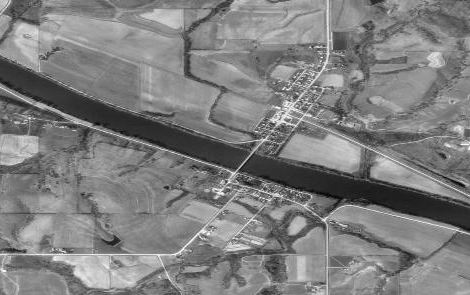 |
In the 1870 census for Chequest township, Van Buren county, Iowa as Abner Hissom [it doesn't look like an 'a'], a 40 year old farmer, of West Virginia. He had 240 acres of land, valued at $4,800 and personal property valued at $1,163. Living with him were his wife, Caroline, 38, of Ohio, and children, Martha J., 9, who was attending school, and Arthur W. 4. Martha was born in Ohio and Arthur in Iowa. A George W. Harrington, 21, also lived with them. I assume he was a hired hand. Vincent Walker, Caroline's brother, was his next neighbor. The James H. Cresswell family was listed just previous to Abner. Arthur's first wife was a Jessie Cresswell.

| Historical Timeline: The Post-Civil War Era
The southern states suffered through "reconstruction" while America came of age as an industrial and military power. With the western frontier finally settled the nation turned outward and became involved in foreign affairs. - 1867 Alaska was purchased from Russia.- 1869 the Transcontinental railroad wascompleted. In 1898 America waged war with Spain. The Philippine islands, Guam and Puerto Rico were annexed. Hawaii also later annexed. |
In the 1875 plat for Chesquest township we find A. Hissom with a 200 acre farm in sections 5 & 8, below. I believe the J. Lee, just west of Abner's place, was John Lee, the husband of Abner's elder sister, Eleanor. I don't see the farm of Abner's brother, Thomas, which, in 1897, was in section 9, where Thomas Haney's is depicted. Just below Abner's farm see a 40 acre plot for V. Walker. This was Vincent Walker, the elder brother of Caroline Walker.
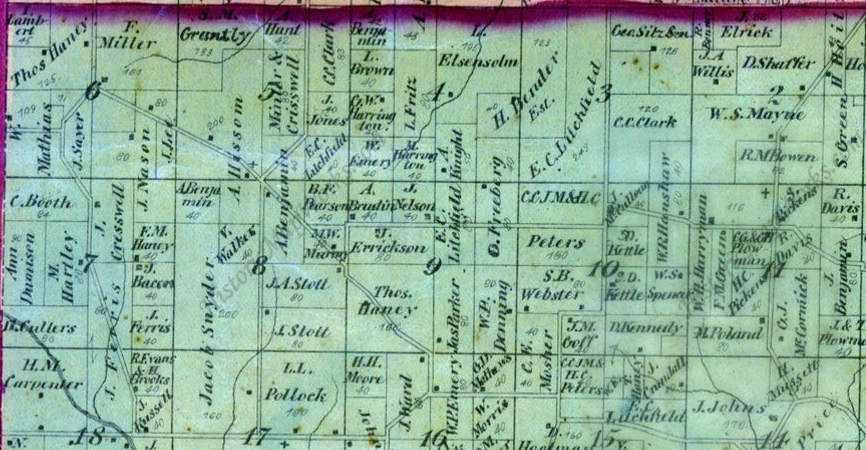
In 1877 Abner's daughter, Serena (Martha) J., married Lloyd Nicklin.
In the 1880 census of Chequest township as Abner Hissem [Hisseur at Ancestry.com], a 50 year old farmer, of West Virginia. Living with him were his wife, Caroline, 47, of Ohio, and son, Arthur W., 14, of Iowa, who worked on the farm. Abner's parents were both shown to be of Pennsylvania.

In the 1885 state census of Chequest township as Abner Hissem, 54, of West Virginia. Living with him were his wife, Caroline, 52, of Ohio, and his son, Arthur, 18, of Van Buren county. Township 69, Range 11, Section 5, 8W1/4 8W1/4.
In the 1895 state census of Chequest township as Abner Hissem, 65, of West Virginia. Living with him was his wife, Caroline [Croline in Ancestry.com], 62, of Ohio. Arthur had moved out by this time. Interestingly, neither Abner nor Caroline had religious beliefs.
In a plat map of Chequest township dated 1897 Abner Hissem is shown with two properties in Sections 5 & 8, one of 80 acres south of the diagonal road, and one of 200 acres north of it. The Free Methodist Church was just east of his property. Thomas Hissem and his son, J.T., had their farms at the far end of the diagonal road, where it turned south. The school on Abner's farm was probably the "Hissem school" my father used to refer to. Just west of Abner's farm was that of Eleanor Lee, his widowed sister. Just south of Abner was the farm of his brother-in-law, Vincent Walker.
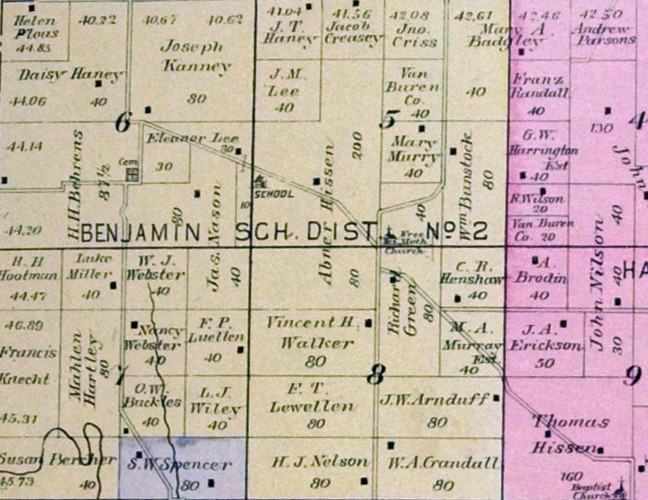
In the 1900 census of Chequest as Abner Hissem, a 70 year old [January 1830] farmer, of West Virginia. He owned his farm and house free of mortgage. Living with him was his wife, Caroline, 67 [June 1832]. They had been married 39 years and had one child together [Arthur]. Abner could read and write, as could his wife. Also living with him was his sister-in-law, Emmaline Church, 74 [November 1825]. Emmaline was Caroline's older sister. She had married William Church, of Rutland, Ohio. When he died, in Ohio, she moved to Iowa. She had no children. Abner's parents were both shown to be of Pennsylvania. Abner seems to have been rather fluid in his understanding of his parents' origins.

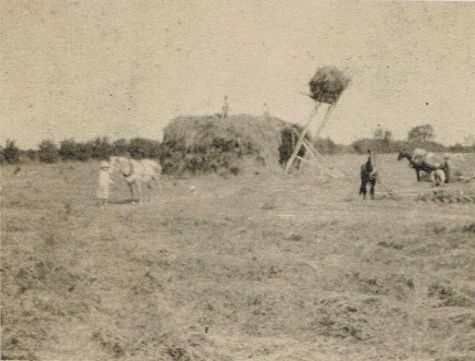 At left is the Hissem farm at haying time, year unknown.
At left is the Hissem farm at haying time, year unknown.
"Mr. Hawbaker delivered and set out a fine large orchard of selected fruit trees for Abner Hissem this week." - from the "Ottumwa Semi-Weekly Courier" of 17 April 1902
In the 1905 state census of Chequest township, Van Buren county as Abner and Caroline Hissem, of Douds-Leando, Chequest township, Van Buren county, Iowa. Caroline's sister, Emeline Walker Church, was living with them. The Plowmans and Nicklins were on the same page. Abner was of West Virginia, his father of Pennsylvania, and his mother was born in Germany. The value of his house and farm was $13,000. He had lived in Iowa for 40 years.
"Leando, Jan. 7. [1910] - Abner Hissem , a retired farmer living in Leando, was the recipient of a threatening letter demanding that $35 be put in a certain place, in default of which he was to suffer dire vengence.The letter stated that "If you do not comply with this demand I will burn you out of house and home for I am desperate, for I have no clothes, food or fuel, while you have plenty. I have nothing against you, but you have plenty and I am desperate.
Mr. Hissem is a man of independent means. He lived for many years on a farm in the southern part of Chequest township. A few years ago he sold his farm and bought a residence in Leando where he has since resided." - from the Ottumwa Tri-Weekly of 9 January 1910
In the 1910 census Of Village township, Van Buren county, Iowa as Abner Hissem, 80 years old, of Virginia [it was Virginia when he was born], and living on his "own income." Living with him was his wife, Caroline, 77. Abner's father was shown as born in Virginia [sic] and his mother in Germany. Caroline was of Ohio, her father of Vermont and her mother of New Jersey. She was the mother of one child, still living [Arthur]. Abner and Caroline had been married for 47 years. Both could read and write.

Caroline died on 15 August 1912 in Leando, Iowa, 9 years before her husband.
In the 1915 state census of Chequest township, Van Buren county, Iowa as Abner Hissem, 85, a retired farmer, and widower, of Virginia. He had lived in Iowa for 50 years. He had six years of education. His father was from Pennsylvania and his mother was from Germany. Weldon G. Hissem, his brother's grandson, signed the form.
The plat map of Chequest township for 1918, below, shows that Abner's son, A. W. Hissem [Arthur], now had the 80 acre farm south of the diagonal road, in Sections 5 & 8. The 200 acre farm Abner had owned north of the road was now owned by Dudley Cyrus and Chester Vaughn Nicklin, Abner's grandsons. Note that Abner was living with D.C. in 1920. A church and a school were also included in Section 5; the school on the north end of AW's farm and the church just east of it. J.T. Hissem and George Hissem, AW's cousins, had their farms at the far end of the diagonal road, where it turns south.

In the 1920 Census for Chequest Township as Abner Hissem, a 90 year old widower living on his "own income," of West Virginia. The census said that his father was born in England and his mother in Germany [was this meant to be nationality vice place of birth?]. Abner was living in the household of Dudley C. Nicklin, his grandson, the offspring of Martha (Serena) Hissem and Lloyd Nicklin. Dudley had a farm in Section 5 of Chequest township, just north of Arthur Hissem's place. Just next to the Nicklins lived Thomas E. Hissem [Earle Thomas Hissem], the son of Jessie Hissem, and his wife Leta.

According to the Work Projects Administration (WPA) Grave registration survey of the 1930's, Abner died on 20 May 1921, at the age of 91, and was buried in the Leando cemetery, next to Caroline. Records of the Campbell Kremer Funeral Home indicate that he died in Selma, Iowa, but confirm his birth and death dates. I have found no tombstone photographs.
I just received an email from Rich Lowe who runs the county genealogical site for Van Buren county. He attached a listing of the burials in Leando [thanks Rich!]. For Abner and Caroline they are,
Section B Row 22 going south
HISSEM
Abner 8 Jan. 1830-20 May 1921
Caroline 29 June 1832-15 Aus. 1912 his wife [Walker]
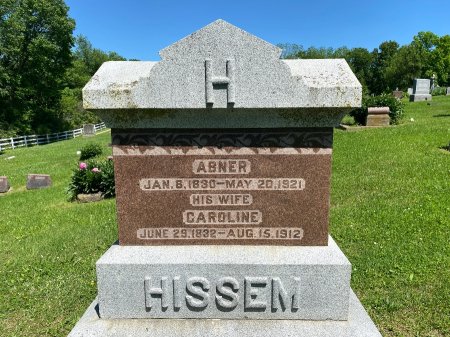

Other Hissems buried in the Leando cemetery are George Abner Hissem and Jesse Thomas Hissem, sons of Abner's brother, Thomas, and Weldon George Hissem, the son of Jesse Thomas. Their wives were also buried there. Also buried there was Caroline Walker Hissem's sister, Emmaline L. Walker Church, and brother, Vincent Amander Walker.
Below is Abner's certificate of death. The information on it was provided by his son-in-law, D.C. Nicklin, with whom he had been living. This may account for the fact that Abner's parents were not identified, Dudley probably didn't know, though his place of birth in Tyler county, West Virginia was shown. Note that Abner died of "senile debility," a doctor's way, I suppose, of saying of old age. The document does confirm that Abner was buried in the Leando cemetery, the very next day after his death! As the song "Pore Jud is Daid" in the musical "Oklahoma" states,
"It's a shame that he won't keep
But it's summer and we're running out of ice."
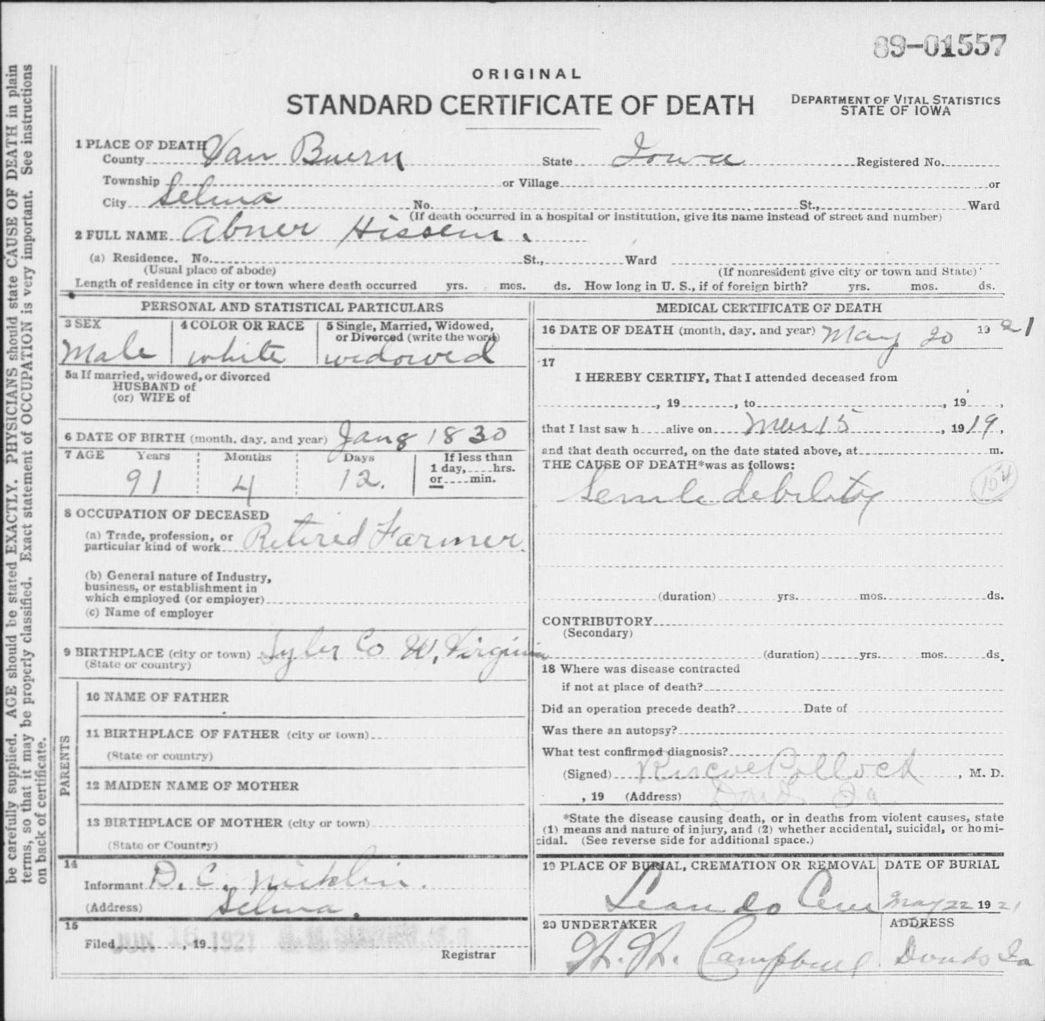
His children with Serena were,
(24) Thomas Jefferson Hissem (1853)
(24) Martha (Serena) Jane Hissem (1861)
His children with Caroline were,
(24) Arthur Walker Hissem (1866)
A son of Abner Hissem and Serena Sayre, he was born in about 1853 in Ohio. In the 1860 census of Apple Grove post office, Letart township, Meigs county, Ohio as Thomas Hissem, 7, of Ohio, living with his parents. He died on 15 September 1863 - from FindAGrave.com. There is no record of the cause of death.
(24) Martha (Serena) Jane Hissem (1861)A daughter of Abner Hissem and Serena Sayre, she was born on 3 January 1861, in Meigs county, Ohio. In the 1870 census for Douds Station post office, Chequest township, Van Buren county, Iowa as Martha J. Hissam [Hissom in Ancestry.com], 9, born in Ohio.
I think she assumed her mother's name of Serena in honor of the woman she never knew. Other researchers claim there was a daughter, Serena, born in 1852, but I've been unable to find anything official about her prior to her marriage. There was no daughter of that name in the 1860 or 1870 census. When the name Serena does show up, in the 1880 census with her husband, she was only 19 years old. Note that she was referred to as Jennie Hisson in a tax report for one of her sons and as Jennie Hissem Nicklin in the obituary of her son, Dudley C. Nicklin.
From the Van Buren county marriage records: Serrena Hissem married Lloyd Alonzo Nicklin on 5 October 1877 in Van Buren county, Iowa.
| The Nicklins
(22) Samuel Nicklin (c1800) Samuel Nicklin married Martha Thomas on 9 April 1822 in Tyler county, West Virginia. Both were of Pennsylvania per the recollections of their grandson, Israel Warrington Nicklin. (23) William V. Nicklin (1830)(22) Samuel Nicklin William V. Nicklin, the son of Samuel and Martha Thomas Nicklin was born in Tyler County, West Virginia on 16 July 1830. He married Elizabeth Smith in 1853. William V. Nicklin served as a Private in Company C, of the 6th West Virginia infantry during the Civil War and received a pension for his service. He died on 28 February 1919, at the age of 88, and was buried in the Iowaville cemetery in Selma, Van Buren county, Iowa. Elizabeth died in 1911. The following was found on Ancestry.com and informs our understanding of how the Hissem family made their way from West Virginia to Iowa. The surname was sometimes written as Nickland. (24) Lloyd Alonzo Nicklin (1856) (22) Samuel Nicklin (23) William V. Nicklin (1830) Lloyd A. Nicklin, the son of William V. Nicklin and Elizabeth Smith, was born on 16 February 1856. He married Serena Jane Hissem. Lloyd died on 14 September 1935. |
Lloyd was born on 16 February 1856 in West Virginia. He was the son of William V. Nicklin and Elizabeth Smith, who were neighbors of the Hissam's. In the 1850 census of District 61, Tyler county, West Virgina as William Nickllin, 19. He was living with his father, Samuel, 51. In the 1860 census of Tyler county as William Nicklin, a 30 year old farmer. Living with him was his wife, Elizabeth, 28, and a son, Lloyd, 5. I have the following from another researcher on Familysearch.org, Rebecca Rasmussen Smith.
"Lloyd Alonzo Nicklin, son of William V. and Elizabeth Nicklin, was born in Tyler county, West Virginia, Feb. 16, 1956(1856), and died triumphant in the faith, at his home in Selma, Iowa, Sept. 14, 1935.
At ten years of age he removed with his parents to Van Buren county, Iowa, and has been a continual resident of the county, except for a few years in Eldon and Ottumwa.
In October, 1877, he was married to Miss Sarena Jane Hissem. Four children were born to them: Dudley and Vaughn of Selma, Mrs. May Dyer, who died in 1930, and Ada Berle who died in infancy. Mrs. Nicklin departed this life Feb. 15, 1899, and he later married Miss Fannie Moffet. To them were born a daughter, Mrs. Ethel Miller, and a son, Carroll, both of Selma. He was converted in early manhood and has since been a member of the Free Methodist church. His strong Christian character, his steadfast faith manifest by his works, have been a light, a strength and a benediction to all whom his life has touched.
He is survived by his wife, four children, nine grandchildren, and four brothers, Thomas I. of Ottumwa, David of Eldon, Warrington of Selma, and Eli of Emporia, Kans.
His loss will be keenly felt by the family, the relatives, the church and the community. Funeral services were conducted at the White Elm church Monday, Sept. 16, in charge of Rev. Mrs. Charles Peterson of Oskaloosa, assisted by Rev. Bruce Myers, H.N. Dickson, S.L. Gilkson and Wm. Heger. Burial was in the Troy cemetery."
The William Nicklin family moved west to Iowa just as Abner had done. In the 1870 census of Salt Creek, Davis county, Iowa as William Nicklin. Living with him was his wife, Elizabeth, and son, Loyd, 14. Davis is the next county west from Van Buren.
In the 1880 census of Chequest township, Van Buren county as Lloyd Nicklin, a 24 year old farmer. He was living in the home of Oloff Friborg, a 63 year old farmer. Living with Lloyd were his wife, Serena J., 19, and a son, Dudly C., 6/12.
L.A. Nicklin had a farm in Section 19 of Village township, just north of his father-in-law, Abner - from the 1897 Plat Book of Van Buren county.
Serena died on 15 February 1899. Lloyd Nicklin lived as a widower in Village townhsip, Van Buren county for many years, but by 1920 he had married a Fanny M.
In 1910, however, his eldest son, Dudley C. Nicklin, had moved into Chequest township and set up his own home with his wife, Blanche.
In the 1920 Census for Chequest Township as Dudley C. Nicklin, 40. Living with him were his wife, Blanche D., 36, and his grandfather, Abner Hissem [Hasen in Ancestry.com], 90.
In 1934 the Iowa General Assembley passed a law creating an Old Age Assistance Commission to oversee the care of the State's needy aged; assistance was to be provided to indigent applicants over the age of 65. A tax of $1 a head, the first year, and $2 a head annually thereafter was collected from all persons over the age of 21 to fund this aid. The names of those to be taxed included:
Taxpayer: Nicklin, Dudley Cyrus. Birthplace: Van Buren Co. Birthdate: 1879 Dec 23. Father: Nicklin, Lloyd. Mother: Hissem, C Jane. Residence: KeoC Jane? Could that be for Cerena vice Serena?
Lloyd died on 14 September 1935. He and Serena were buried in the Troy cemetery, Davis county, Iowa.

Serena and Lloyd's children were,
(25) Dudley Cyrus Nicklin (1879), born 23 December 1879 in Van Buren county, Iowa; married Blanche D. Carroll, the daughter of Alice Dire and John M. Carroll; died in 1964 and buried in Troy, Davis county, Iowa; he inherited the 200 acre farm Abner Hissem had owned north of the road.
(25) Chester Vaughn Nicklin (1882); born 18 July 1882 in Ottumwa, Wapello county, Iowa; married Nora Alice David; died on 25 March 1974 and buried in Douds
"Rites Held For Vaughn Nicklin(25) May Fern Nicklin (1888), she married Morton Worth Dyer; died in 1930
Vaughn Nicklin was born July 18, 1882 in Ottumwa and passed away March 25, 1974. He was the son of Lloyed and Serena Nicklin. In 1905 he married Nora Alice Davis; she preceded him in death February 2, 1972. They lived and farmed around Selma and Douds until retirement at which time they moved to Eldon. He is survived by two daughters, Helen Patrick of St. Clair Shores, Michigan and Freda Welles of Honolulu, Hawaii; one brother, Carroll Nicklin of Montana and one sister, Ethel Miller of Selma; two grandchildren, Noreene Duggan and Richard Patrick of Detriot, Michigan; and three great-grandchildren. Mr. Nicklin was buried at Mt. Moriah Cemetery." - from "Slutts Book", Keosauqua Public Library, Keosauqua, Iowa
My Great-Grandfather. Arthur Walker Hissem, the only child of Abner Hissem and Caroline Walker, was born on 24 January 1866 in Van Buren county, Iowa. His last name was spelled Hissim in the LDS library. In the 1870 census for Chequest township, Van Buren county, Iowa as Arthur W. Hissam [Hissons in Ancestry.com], 4, born in Iowa. In the 1880 census of Chequest township as Arthur W. Hissem [Hisseur at Ancestry.com], 14, who "worked on the farm." See both censuses above. Below is an advertisement for farm implements available in 1885 that give a feel for what 'working on the farm' might have been like.
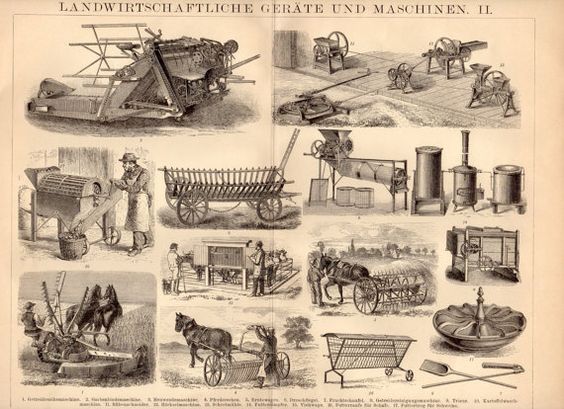
In the 1885 state census of Chequest as Arthur Hissem, 18, still living with his parents.
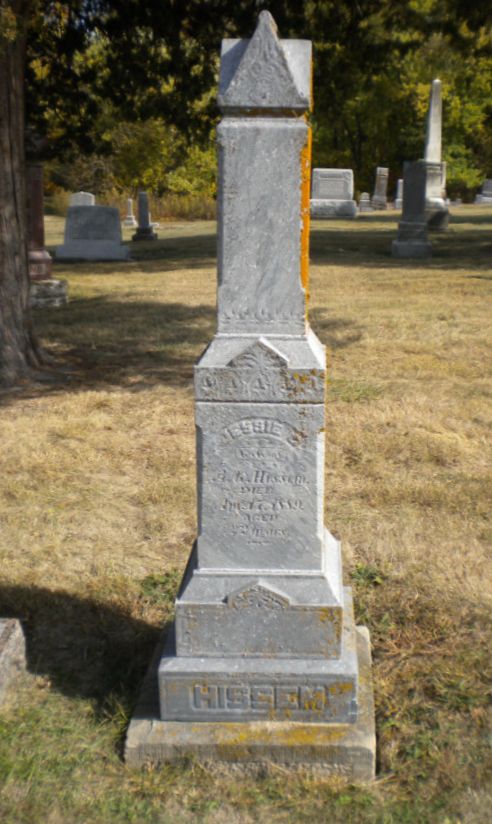
According to a source on the genealogy of the Sayre Family (Banta), Arthur was married twice, and the 1910 census agrees, but until now I hadn't been able to find any confirmation. I've now found a reference to the marriage of Arthur Hissom, aged 22, the son of Abner Hissom and Caroline Walker, and Jessie Cresswell [Crisswell], 21, the daughter of William Cresswell and Mary A. Martins, on 20 October 1888 in Van Buren county, Iowa - from "Iowa, County Marriages, 1838-1934." Jessie was born in about 1867. I don't see her in any other records.
In the 1875 plat there was a farm near that of Abner Hissam's owned by Minter & Crisswell, in the same section, and another by a J. Cresswell, in the adjoining section 7. In the 1880 census the latter appears to be J.H. Criswell. I think this was John Creswell, a son of Matthew O. Creswell, born circa 1848. He had a brother, Willis, born circa 1853.
Jessie died just six months after her marriage. In the Troy cemetery, Davis county, Iowa, just east of Chequest township, there is a tombstone, pictured to the right, for a
"Jessie C.,Jessie and Arthur had no children.
wife of
A.W. Hissem
Died Apr. 17 1889
Aged 23 years"
Two years later Arthur W. Hissen [Hissun], 25, married Tillie Haney, 22, on 8 April 1891 in Van Buren county, Iowa - from "Iowa Marriages, 1809-1992." Tillie Elizabeth Haney, the daughter of Francis Marion Haney and Sarah Ann "Sally" Lanman, was born on 23 October 1868 in Chequest township, Van Buren county, Iowa. The Haney's owned a farm in close proximity to the Hissem farm in Iowa. Tillie's father, Francis Marion, and brothers, James T. [shown as I.T. on the map], William E. and Zadok Haney, had farms in Section 6 of Chequest township, just northwest of Arthur's place.
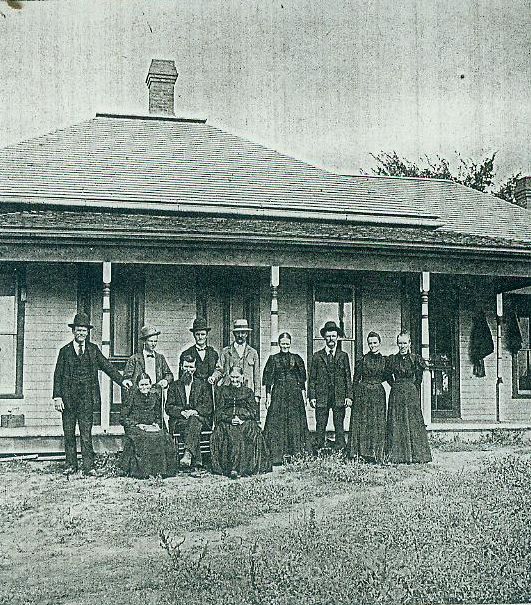
| The Haney Family |
| The Hissem/Haney Cemetary
|
Arthur Hissem owned a farm in Section 12, Union township, Davis county, Iowa - from the 1891 Plat Book. This was just across the border with Chequest township, and almost due west, from where his father, Abner, still lived and farmed. When my father talked about my grandfather, Leo, the son of Arthur, he often talked about two large farms that he owned. He may have been referring to the farms of Abner and Arthur, that he inherited.
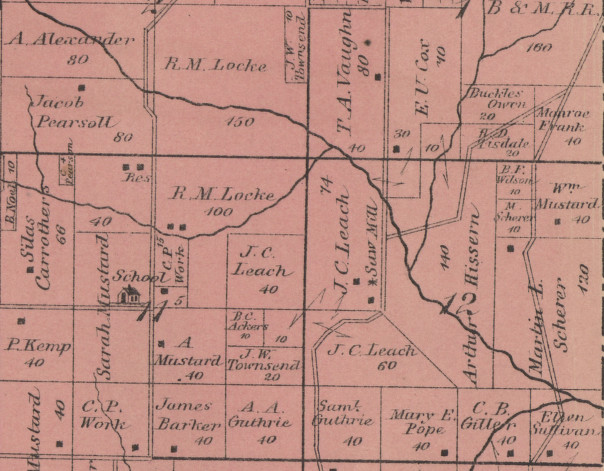
In the 1895 state census of Troy, Union township, Davis county as Arthur Hissem [Hissner in Ancestry.com], 28. Living with him were his wife, Tillie, 26, and his son, Leo, 3. Union township is just west of Chequest township. Troy is the near town, just south of Arthur's farm. The Troy cemetery contains the tombstones of Arrila Hissem, Nellie M. Hissem, and Thomas Hissem.
In the 1900 census of Union township, Davis county, Iowa as Arthur [Arilner in familysearch.org] W. Hissem, a 34 year old farmer. Living with him were his wife, Tille E., 30 [October 1869], and son, Leo, 8 [December 1891]. Arthur and Tillie had been married for 9 years.

In 1902 Arthur was referred to as "of Oak Hill," - from the "Ottumwa Semi-Weekly Courier" of 25 December 1902. Oak Hill, in Van Buren county, refers to,
Bloomfield. "Arthur Hissem, of Union township, transacted business Tuesday in this place." - from the Ottumwa Daily Courier of 11 February 1903.
In the 1905 state census of Union township, Troy post office, Davis county, Iowa as A. W. Hissem, a 39 year old farmer. Living with him were his wife, Mrs. A. W. Hissem, and children, Leo W. and Gladys.
In the 1910 census of Union township as Arthur W. Hissem, a 44 year old farmer. Living with him were his wife, Tillie E., 41, and children, Leo W., an 18 year old farm laborer, and Gladdis O., 7. This was Arthur's second marriage, but Tillie's first. They had been married for 19 years.

In a plat map of Union township in 1912 Arthur Hissem's farm of 140 acres is shown in Section 12. This is north of Troy, on the far east border of the township. In a plat map of 1918, A.W. Hissem is shown with 80 acres in Section 5 & 8 of Chequest township, directly to the east, his father's old place. My father said his father, Arthur's son Leo, had two large farms. Did he mean these two?
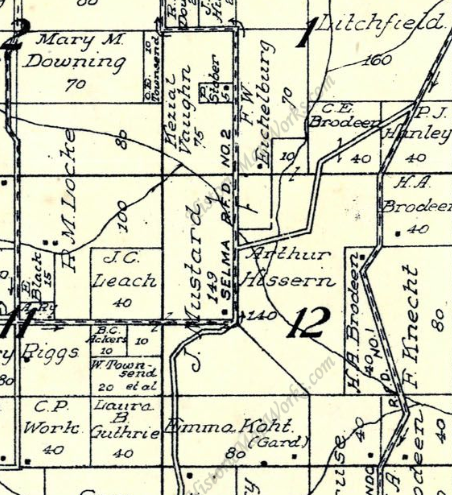
In January 1914 Arthur retired from farming, according to both his obituary and death certificate. He moved to Leando, Iowa where his father's farm was located. Note the plat of 1918, below, where his name, was well as those his aunt's family of the Nicklins, take the place of Abner Hissem. I think this means that Arthur had inherited ownership of this portion, but did not farm it. He probably leased it to someone else to farm, perhaps the Nicklins. This was also the case I presume for his Davis county property since I know from my father that this was still in the family circa 1948.
In the 1915 state census of Douds Leando, Village township, Van Buren county as Arthur Hissem, 49, of Iowa. Apparently Arthur had moved back to the family farm of his father. By 1915 Arthur's mother had died and his father, Abner, now listed himself as retired. Arthur also was retired. Was his son Leo, 23, now running the farm? Arthur's house and farm were valued at $1200. He had 7 years of schooling. This reminds me of the scene in the movie "I Remember Mama" where the mother, Irene Dunne, excitedly realizes that her son can actually go to "High," as in high school. This was an accomplishment that most people, certainly for those that were poor or rural, could not hope for. Also listed was Tillie Hissem, 46. She also had 7 years of schooling. Her father was from Iowa and her mother was from Indiana.
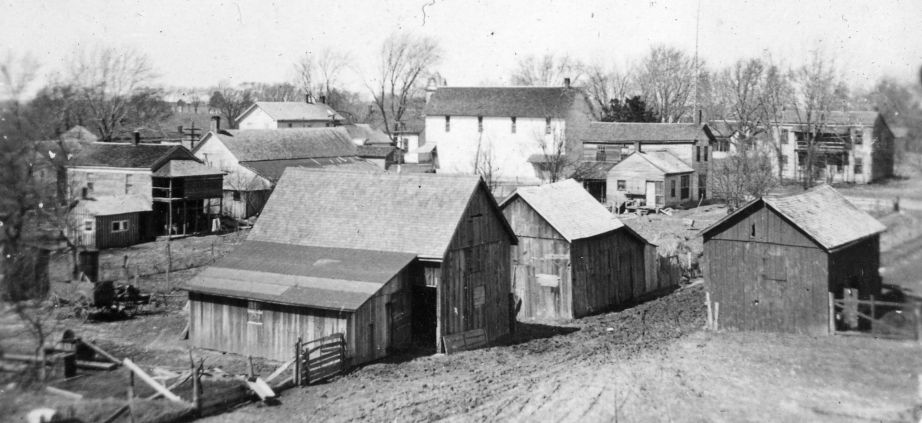

In the 1920 census of Village township, Van Buren county as Arthur [Arther in Ancestry.com] Hissem, a 53 year old without occupation. Had he been so successful as a farmer that he retired to live on his rents? Living with him were his wife, Tillie, 51, and children, Leo, 28, and Gladys, 17.

In the 1925 state census of Village township, Van Buren county as Arthur Hissem, 59. He and Tillie, 56, were living "next door" to their son-in-law, Leslie Boekhoff, 22, and their daughter, Gladys, 22. Arthur had 5 [sic] years of schooling and Tillie 7.
Tillie died on 11 January 1927 in Iowa.
In the 1930 census of Chequest township, Van Buren county, Iowa as Arthur W. Hissem, a 64 year old widower. He was living with his daughter Gladys and her husband, Leslie J. Boekleff. His father was from West Virginia and his mother from Ohio.

In 1934 the Iowa General Assembley passed a law creating an Old Age Assistance Commission to oversee the care of the State's needy aged; assistance was to be provided to indigent applicants over the age of 65. A tax of $1 a head, the first year, and $2 a head annually thereafter was collected from all persons over the age of 21 to fund this aid. The names of those to be taxed included:
Taxpayer: Hissem, Arthur W. Birthplace: Van Buren Co. Birthdate: 1863 Jan 24. Father: Hissem, Abner. Mother: Walker, Sarah. Residence: CheqSarah? I though his mother's name was Caroline Walker?
Arthur Walker Hissem, 70, the son of Abner Hissem of Virginia and Caroline Walker of Ohio, widowed of Tillie Elizabeth Hissem, died of nephritis and heart disease on 17 June 1936 in Village township, Van Buren county, Iowa. This was the home of his daughter, Mrs. Gladys Boekhoff. He had lived with her for only 2 months and 7 days, indicating that he moved there to die. He had been born on 24 January 1866 in Selma, Iowa. He was a retired farmer who, interestingly, had not worked at farming since January 1914. He was buried in Troy on 19 June 1936. Glady Boekhoff was the informant for the death certificate. His doctor was Roscoe Pollack of Douds, the same as for his father, above.
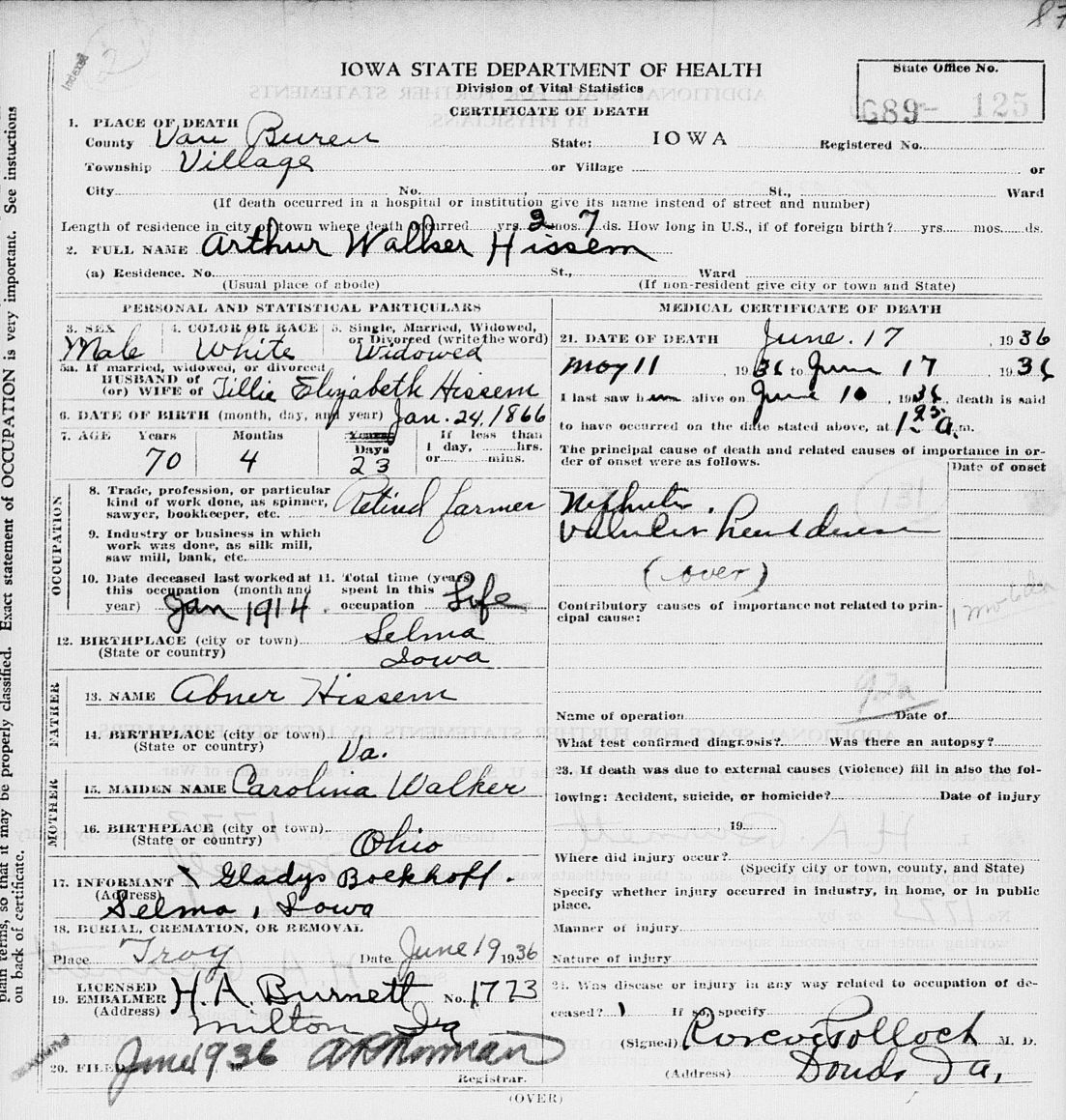
My father remembers the "death watch" maintained by the family around the old man's bed; Dad was 12 years old at the time. He mentioned the "death rattle" as his grandfather finally expired.
Arthur's obituary.
"Arthur W. HissemArthur was buried in the Troy Cemetery, Troy, Union township, Davis county, Iowa, next to his wife, Tillie. Also buried in the Troy cemetery were Arthur's uncle Thomas and Aunt Arvilla Hissem, and their son Jessie.He married Jessie Criswell in 1887 who died a short time later. April 8, 1891 he was united in marriage with Tillie Elizabeth Haney. They were the parents of two children, Leo W., who now resides in Milton, and Gladys Boekhoff of Selma.
In the year 1891 he moved to Davis County where he lived until 1914 when he returned to Van Buren County, living at Leando.
He is survived by his son, Leo W. and daughter, Gladys; five grandchildren and numerous other relatives.
Funeral services were held at the M.E. church in Troy Friday afternoon in charge of the Rev. Charles Fix of Pulaski. Interment was in the Troy cemetery." - from the Van Buren Co. Genealogical Society Obituary Book D, Page 35, Keosauqua Public Library, Keosauqua, IA
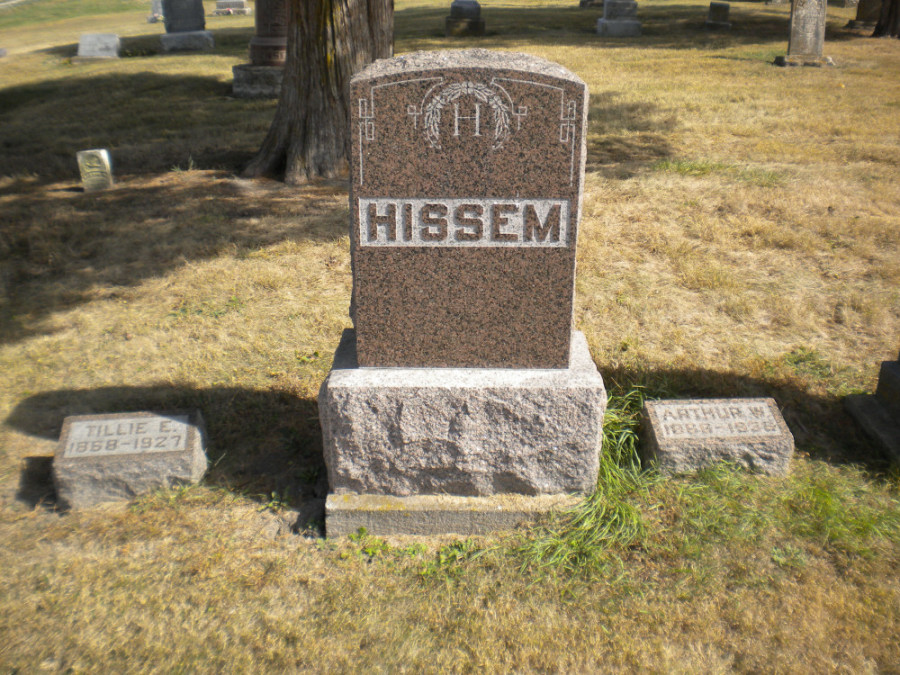
Their children were,
(25) Leo Worth Hissem (1891)
(25) Gladys Opal Hissem (1902)
| Historical Timeline: The New Century
The Progressive Politics of the 19th century reached their goals in improving life for the common man. Restrictions on child labor, anti-monopoly legislation, food and drug safety, and pro-union policies acted to humanize and control capitalism. The allure of radical reforms, such as socialism and communism, which racked Europe are significantly reduced. - 1903 First successful flight by the Wright Brothers at Kitty Hawk, North Carolina.- 1907 Theodore Roosevelt sent 16 Navy battleships, the "Great White Fleet," around the world announcing American power. The ships were painted white to show their non-belligerence. - 1908 Ford developed the first Model T. |
My Grandfather. A yet unnamed child, the son of Arthur Hissam, 25, and Tillie Haney, 23, was born on 21 December 1891 in Union townnship, Davis county, Iowa. In the 1895 state census of Troy and Union townships, Davis county as Leo Hissem [Hissner in Ancestry.com], 3. In the 1900 census of Union township, Davis county, Iowa as Leo Hissem, 8 [December 1891]. In the 1905 state census of Troy township, Davis county, Iowa as Leo W. Hissem. In the 1910 census of Union township, Davis county as Leo W. Hissem, an 18 year old farm laborer, still living with his parents.
Leo was involved in a tragic accident.
"SAD ACCIDENT NEAR TROY
Young Man Fatally Injured By Falling Tree.
LADY KILLED BY FALL
Mrs. Simpkins of Near Stockport Falls Down Flight of Stairs-Funeral Yesterday.
Paul Work, son of C.P. Work and nephew of Attorney Work of Ottumwa, was almost instantly killed about 3 1/2 miles north of Troy, Davis county, Saturday, while chopping in the timber.
Leo Hissem was felling trees and Paul Work and his father were splitting the wood. A tree cut down by Hissem fell in a different direction, on account of the high wind, from what was expected, coming down with terrible force upon the young man, breaking his neck, his jaw, and his leg in several places and also crushing his skull. He lived only a few minutes after the accident. His father was also struck and knocked down, but was not seriously injured.
Paul was 18 years of age and was esteemed by all who knew him. He leaves a father, mother and two sisters, Mrs. Mary Townsend of Milton and Mrs. Blanche Brewer of Stiles, Ia. C.P. Work, the father, is a brother of Attorney W.A. Work of Ottumwa and also had a brother at Birmingham, where he visited last week.
The funeral was held at the Troy Presbyterian church Sunday at 2 p.m., it being conducted by Rev. Jas. Wilson and attended by a large concourse of sympathizing friends." - from the Van Buren Co. Genealogical Society Obituary Book D, Page 73, Keosauqua Public Library, Keosauqua, IA
In January 1914 Leo's father, Arthur W. Hissem, retired from farming and moved to Leando, Van Buren county, Iowa. I suspect he rented out the farm. Leo was, as you'll see next, a farm laborer on another man's farm.
In the 1915 state census of Douds Leando, Village township, Van Buren county as Leo Hissem, a 23 year old farm laborer. He had 7 years of schooling.
The United States declared war on the Central Powers on 6 April 1917. Two months later, Leo W. Hissem, a natural born citizen aged 25, registered for the draft on 5 June 1917. Leo's cousin George Weldon Hissem registered the same day. The Ottumwa Semi-Weekly Courier of 5 June 1917 reported that,
"Leo Hissem went to Des Moines Tuesday."I guess this was why. He had been born on 21 December 1891 at R.R. #1, Troy, [Davis county] Iowa. This was were his father's farm was located. Leo was a farmer working for Wm. Wagner, of Ankeny, Iowa. Since Ankeny is north of Des Moines, I'm assuming Mr. Wagner was an absentee landlord. Leo was living in Douds Leando, Iowa, where his father, Arthur, had retired to circa 1915. Leo was described as single, of medium height and build, with blue eyes and brown hair.
Leo Hissem enlisted in the Army on 20 September 1917 in Keosauqua, aged 25. According to his later request for a war service bonus, below, he was drafted. His cousin, George Weldon, enlisted on the same day. It would be interesting to ascertain the thinking process that went into these young men deciding to enlist together.
On 20 September Leo began service with the Headquarters Company of the 339th Field Artillery Regiment of the 88th Division then being organized at Camp Dodge in Iowa. Captain Donald B. Gilchrist was commanding the Company. Camp Dodge was the training camp for the 88th Division of the National Army. The Division included three artillery regiments, including the 339th. In a later document, below, Leo remembered being assigned to the 336th Field Artillery, but that was a unit of the 87th Division at Camp Pike in Arkansas.
Considering American readiness at this early point in the war, I expect that Leo never saw a real cannon while attached the the 339th. They would have played with log-like replicas, stepping through the drill and wondering what France would be like..
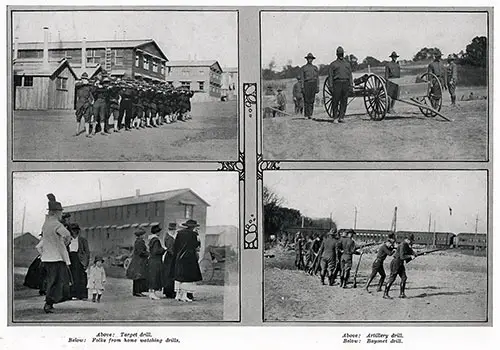
| The National Army
The Selective Service Act of 1917 established the broad outlines of the Army's structure. There were to be three increments:
Much of the identity of these three segments eventually would be lost as recruits and draftees alike were absorbed in all units, so that in mid-1918 the War Department would change the designation of all land forces to one "United States Army." |
The 88th Division suffered heavily from transfers to the Regular Army. In October and November 1917 men were transferred to the 34th and 87th Divisions. On 22 October 1917 Leo was transferred to the 163rd Depot Brigade of the 88th Division.
"Transferred . . . Privates . . . Hissem, Leo W. 9/20/17 [date of enlistment] Par. 1 SO [standing order] 59 Hdq 88 Div 10/22/17 [date of orders]. Trans to Depot Brig. SO 42 Hdq 88" - from "Initial Muster Roll of Headquarters Company of the 339th Field Artillery" dated 1 Septembeer 1917 to 31st October 1917A depot brigade was a unit designed to train, receive or transfer men between military formations. A later muster indicates that Leo had been sent to Company C, 7th Battalion of the 163rd Depot Brigade. This was in preparation for a move we'll talk about below.
"Camp Dodge is located in Johnston, [Polk county] Iowa, which is near the capital of Iowa where the Iowa National Guard resides. Throughout the US military history, bases have opened and closed depending on the need. Like most of the military bases still open in the US, Camp Dodge was opened at time of World War I in 1917. It was built as a training facility for the National Guard, which is the oldest military organization in the US. Camp Dodge is apart of that history as it was a training facility for the expanding US Army in World War I." - from fortwiki.com
| Historical Timeline: The 1910's
World War I marked the end of the Progressive Era of politics in America. - 1910 Boy Scouts of America were founded.- 1914 the assassination of Archduke Francis Ferdinand, heir to the throne of the Austro-Hungarian Empire, set off World War I in Europe. - 1917 Germany's policy of unrestricted submarine warfare forced America's entry into World War I on the side of the Allies. - 1918 Germany surrendered, ending World War I. - 1919 the Red Scare gripped America. |
Private Leo W. Hissem would fight in France in the 42nd "Rainbow" Division. My Dad remembers him mentioning Douglas MacArthur, their Chief of Staff when he was still a promising Colonel, but he more often referred to General 'Black Jack' Pershing, the commanding officer of the American Expeditionary Force. By the way, the nickname 'Black Jack' came from a period when a young Pershing was placed in charge of a 'negro' battalion. Dad also mentioned that he knew his Father had fought in the battles of the Argonne Forest.
However, Leo did not go straight to the 42nd. On 22 October 1917 he was transferred from the 88th Division at Camp Dodge to the 34th Division at Camp Cody, in Deming, New Mexico. The 34th was a newly organized Division.
"Hissem, Leo Sept. 20/17 Trans Oct. 22/17 to 34th Div. per par 1 SO 59 Hq. 88th Div. Oct 22/17" - from Initial Muster Roll of Co. C of the 7th Battalion, 163rd Depot Brigade, 1st Sept. 1917 to 31st Oct. 1917Leo's cousin, George Weldon Hissem, was also initially assigned to the 339th Field Artillery of the 88th Division at Camp Dodge, but was transferred to the Quartermaster Corps, still at Camp Dodge, 12 days before Leo got his transfer to Camp Cody. George never went overseas.
Deming, New Mexico is on wind-swept desert just north of the Mexican border. Leo would have arrived at Camp Cody, via train, from Camp Dodge, along with about 500 other inductees. Below is from a letter an Iowan wrote home about the trip to Camp Cody.
"Dear Folks at Home -Well I finely got down here, landing Thursday, and it is sure some ride, believe me but I stood the trip fine, and enjoyed it as there were 565 in the bunch, so a felow couldn't get lonesome. In our sleeping car there were 48 men, we got our meals on the train. They let us off once in a while for exercise, generally in the larger towns. We didn't get very much to eat coming, but I guess it is better for one when on a long trip. Our feed consisted of corned beef, canned tomatoes, coffee and bread and got this three times a day. When we stopped in towns we were not allowed to go in the stores to buy anything to eat, so there were negro porters on the train that we bought food from. Of course we had to pay more for it, a pie costing 30 cents, but two or three of us went together on them so it didn't cost so much. We surely did get tired of the same thing over and over again. One of the boys that I chummed with had fruit and fried chicken along and he shared with me. He is a fine fellow and we are still together but can't tell how long it will be. We are liable to be transferred any day, so can't send you any permanent address until we hear.
Well this is some place. Of course we haven't seen much of it yet. It is altogether different from Camp Dodge. We are all in tents, nine men in a tent, and it seems as though that is all we can see. But don't think we are going to freeze. Oh no. The climate here is as warm as summer time up home, but the nights are cool. The climate is fine but the country is a little wild. Sage brush and cactus is about all that can be found here, and its pretty lonesome at times but guess we can stand it. We are two miles from Deming and it is said that there are no white people there. They are all Mexicans. I wish I could have taken some pictures on the way down. We saw about 1,000 acres of land I wouldn't take as a gift. It is very hilly and dry and it beats all the poor people living there. I don't believe they have enough money to get away from there, or I am sure they would.
If you take the map you can trace our trip. We took the Wabash to Kansas City, then the Santa Fe to Deming. Tell pa we got to see the country around Amorilla. We got off there and went down town. It is a nice place and they raise good crops but farming would be better if the ground had more moisture. We also saw the oil wells in Kansas. From Elderato to Augusta was great. There were thousands of them and one would think that gas and oil would be as cheap as water but it is as high as at home. We are 1500 miles from home. The boys that have been here for several months are awfully brown and expect that is the way we will look. The Mexicans look like the Tama Indians but are some smaller. There is no end to sand here. I don't wonder that Iowa land is so high. There is so much waste land here.
Well folks I'd like to write more of the country if I could. I must tell you that our time is one hour and fifteen minutes faster than down here. I had to set my watch back. Well folks I am fine and dandy. The water here is good and the meals are better than at Camp Dodge. Don't worry as Chuck is alright. With loving thoughts to all."
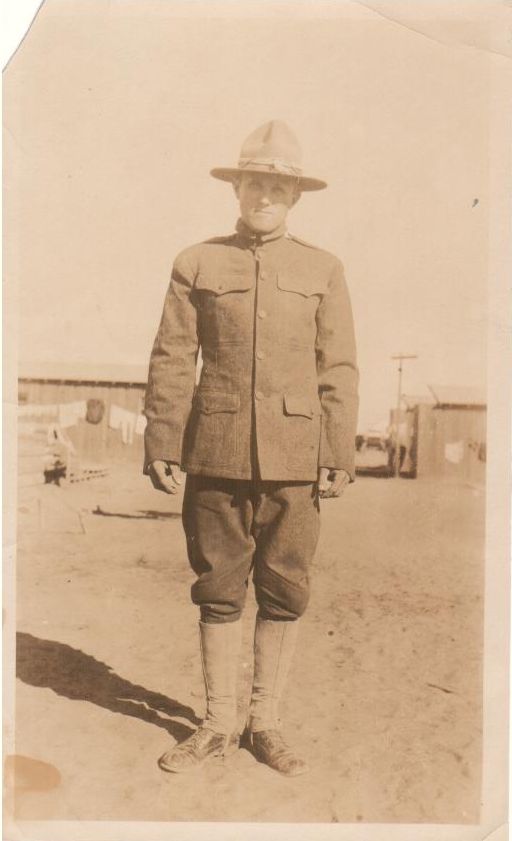 After arriving Leo would have been marched to his new quarters, a tent he would share with seven other men for the rest of the training period. Luckily, while the days were hot, the nights were cool. There he joined the newly formed 34th Division, which, like the 42nd, was made up of many Guard units. While the 133rd Infantry Regiment contained all the Iowa Guard units, a few men from Camp Dodge, Iowa got assigned to the 135th regiment.
After arriving Leo would have been marched to his new quarters, a tent he would share with seven other men for the rest of the training period. Luckily, while the days were hot, the nights were cool. There he joined the newly formed 34th Division, which, like the 42nd, was made up of many Guard units. While the 133rd Infantry Regiment contained all the Iowa Guard units, a few men from Camp Dodge, Iowa got assigned to the 135th regiment.
On 17 November 1917 Private Leo W. Hissem was assigned to Company C of the 135th Infantry, Captain DeWayne O. Stegner commanding. Captain Stegner was commissioned 15 May 1916, and so, a 'Regular Army' man.
"Assigned to 34th Div par 1 SO #59 Hq 88th Div Oct 22/17 Assgd to Regt Nov 10/17 per VOCG [verbal orders of the commanding general]. Assgd to Co [company] Nov 10/17 per par 1 RSO [regimental special orders] #227. Jd.s.d." - from "Muster Roll of Company "C" of the 135th Infantry Regiment" dated 31 October 1917 to 31 December 1917More muster reports from Company C at Camp Cody:
"Privates . . . Hissem, Leo W. NA [?] Sept 20/17 [enlisted] 6.70 [?] 1422981 [serial number]" - from "Muster Roll of Company "C" of the 135th Infantry Regiment" dated 31 December 1917 to 28 February 1918
"Privates . . . Hissem, Leo W. NA Sep 20/17 (1422981)" - from "Muster Roll of Company "C" of the 135th Infantry Regiment" dated 28 February 1918 to 30 April 1918
Leo had an allotment of $5.00 a month, presumably sent home to his parents.
"Alot $5.00 per Mo. 9 Mo. and $4.75 for 10th Mo. from Oct. 1st, 1917, to July 31st, 1918, 2nd Lib. Loan $50.00"The Second Liberty Loan, a bill passed by Congress on 24 September 1917, was a method for people to "invest" in the war through an interest-bearing loan to the government. $50 was the lowest denomination of coupon or bond. The loan was to be repaid after 1927.
The photograph of Leo, to the right, appears to have been taken at Camp Cody. Note the stark surrondings.
The men that Leo shared a tent with were his nascent 'squad' or section. He would serve with them, it was planned, throughout the war. In Europe things were different. The organization of American Expeditionary Force rifle companies differed greatly from that of state-side rifle companies. Doing away with "everyman a rifleman" and adopting an organization similar to what the British and French were fielding when the U.S. entered the war, the biggest changes came at the platoon level where new specialized weapons were introduced, including automatic rifles and rifle grenade launchers.
Infantry organization: 4 rifle squads to a platoon, 4 rifle platoons to a company, 4 rifle companies to a battalion, 3 infantry battalions to a regiment, 2 infantry regiments to a brigade, and 2 infantry brigades to a division. Other units, i.e. machine guns, artillery, headquarters, etc., were added at all levels.
| Camp Cody
Construction of Camp Cody, named after Buffalo Bill Cody, started in June 1917, on the site of the former Camp Deming, which had been opened after the Pancho Villa raid on Columbus, New Mexico. National Guard units from the Dakotas, Minnesota, and Iowa came here to train and form the 34th division. According to a letter written by one of the men, officers and men both lived in tents. Behind these were wooden mess houses. The shower houses and latrines were also of wood, but not a bit of paint on anything, just bare boards. After all the training, the 34th never made it into combat as a division. They arrived in France in October, 1918, and were sent back to the US to be disbanded in December, 1918. See Camp Cody and Michael Kromeke's WW1 History of Camp Cody (lots of photographs at the latter) and Life at Camp Cody (more photographs). 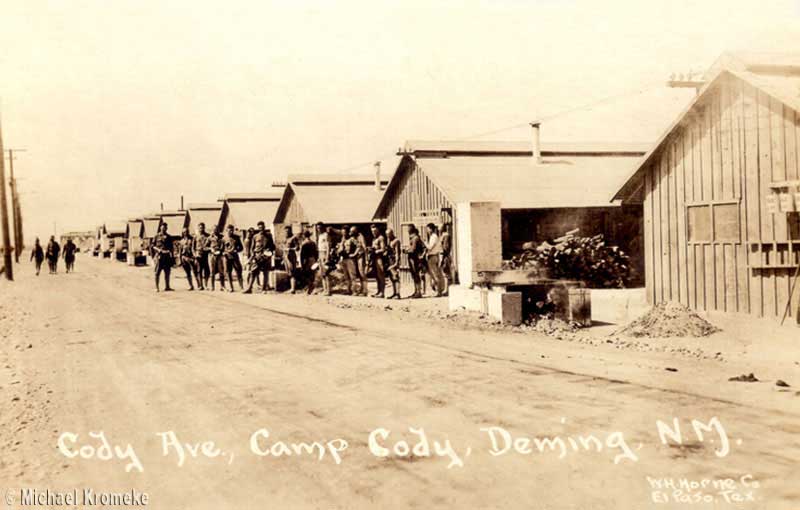 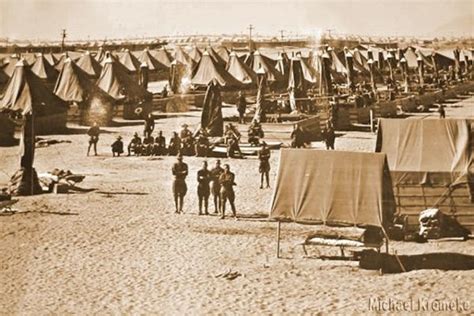
The 34th Division The division was established as the 34th Division of the National Guard in August 1917, consisting of units from Iowa, Minnesota, Nebraska, North Dakota, and South Dakota. On 25 August 1917 it was placed under the command of Maj. Gen. Augustus P. Blocksom. The 67th Brigade comprised the 133rd Infantry Regiment [which included the Iowa contingent] and the 134th Infantry Regiment. The 68th Brigade comprised the 135th Infantry Regiment and the 136th Infantry Regiment. Training went well at Camp Cody and the officers and men waited anxiously throughout the long fall and winter of 1917-18 for orders to ship for France. Their anticipation turned to anger and frustration, however, when word was received that spring that the 34th had been chosen to become a replacement division. Companies, batteries and regiments, which had developed esprit de corps and cohesion, were broken up, and within two months nearly all personnel were reassigned to other commands in France. The 34th Division, after receiving new draftees to fill its ranks, finally left Camp Cody on 26 August and arrived in France in October 1918. However, it was too late for the division to be sent to the front. |
| Germany's Last Offensives of the War
By the winter of 1917-1918 the German people were sick of war. Strikes erupted at a number of large factories in December and in January almost half a million worked engaged in a stop-work in Berlin's metals industry. General Ludendorf, who was then running the war, responded by demanding solidarity on the home front and planning a major offensive to knock the French out of the war before American troops could make their presence felt. The Russians were finally out of the war and 100,000's of German troops were on their way France. Plan Michael, as it was known, began on 21 March 1918 with an all-out attack on the British line. Ludendorf hoped to create a split between the British and French positions through which the Germans armies could pour. A gap did develop. Anxious to improve coordination with the French in order to contain the situation, the British agreed to make General Foch the supreme command of all forces in France. The United States troops were already beginning to arrive in significant numbers and their commander, General Pershing, volunteered Americans to fill the gap. The French were pleased, especially France's premier, Clemenceau, and General Foch. Britain's press was ecstatic, while the British commander-in-chief in France, Douglas Haig, dismissed the Americans, claiming they were a lot of untrained rabble and would be of little help. |
With the March attack, suddenly a front that had not moved more then 10 miles since 1914 had a forty mile wide tear in it, and the Germans pouring through. The Allies panicked. General Petain issued orders for French troops to prepare to seperate from the British army to cover the approaches to Paris. General Haig, commander of the British army, began making plans to cover the approaches to the Channel ports to prepare making plans for a last stand or embarkation to England. Under mounting pressure, General Pershing agreed to rush more American troops to France, 130,000 in May and 150,000 in June, using British transport. - taken from "Pershing" by James Lacey
| Germany's Last Offensives of the War, continued
Plan Michael was complete by 5 April. The Germans had taken almost 90,000 British prisoners and had inflicted 164,000 casualties on the British and 70,000 casualties on the French. The Germans had captured an enormous amount of men and material, and at points, they had pushed the Allies back as far as forty miles. However, the Germans had suffered enormous casualties as well and their momentum was spent. Much of the blame goes to Ludendorf who had neglected the use of tanks and had not reinforced the break-through effectively when it occurred. The Germans struck again on 9 April at another point on the line and pushed the Allies back again. And yet again suffered as many casualties as his foes. The French, British and German armies were all plagued with low morale, it was only a question of who broke first. Ludendorf, still believing the American's were not yet ready to fight, began his next offensive, Plan Hagen, on 27 May. Once again the German's made gains and by the end of the month lead elements were within 39 miles of Paris when the offensive petered out. The Germans had made three bloody assaults, exhausted themselves, and been left with an extended front making them more vulnerable than they had been in the beginning. The American army, trained, rested and ready to fight, entered the war in force on 9 June, attacking the tip of the last German assault at Belleau Wood. The French followed with a counter-offensive that sent the Germans into retreat. The front stabilized again, but German morale was now even lower. General Ludendorff planned another offensive to commence on 12 July. It would be his last. See Fischer's excellent book, "Germany's War Aims in World War I" to understand just how confident the Germans were, even this late, in their eventual victory. Their draconion plans for captured French and Belgium territory mirrored the excesses of the Brest-Litovsk treaty with the Russians. |
Training at Camp Cody had been going well and,
"the officers and men waited anxiously throughout the long fall and winter of 1917-18 for orders to ship for France. Their anticipation turned to anger and frustration, however, when word was received that spring that the 34th had been chosen to become a replacement division. Companies, batteries and regiments, which had developed esprit de corps and cohesion, were broken up, and within two months nearly all personnel were reassigned to other commands in France." - from History - The 34th Red Bull Infantry DivisionThe 34th Division was one unit selected to provide the soldiers to support the new surge and Leo was selected to transfer in June 1918. While the officers and noncoms remained at Camp Cody to train a new cadre of recruits, most of the privates were rushed across the Atlantic and into the ranks of regiments at the front.
On 5 June 1918 Leo was transferred to Camp Merritt, New Jersey. He would have traveled by train, probably arriving by 11 June. Another replacement group out of Camp Cody left on 15 June and arrived at Merritt 6 days later, on the 21st. Leo's last muster with the 135th regiment, read
"Transferred to Camp Merritt, N.J. June 5/18 per AGO [Adjutant General's Office] Telegram May 19/18 and SO 156 par 3 Hq 34th Div June 5/18." - from "Muster Roll of Company "C" of the 135th Infantry Regiment" dated 30 April to 30 June 1918The closest train station to Camp Merritt was Cresskill, New Jersey. See below for troops arriving at Cresskill on 25 July 1918, just a month after Leo. See Jessie J. Bryan at Camp Merritt for more.
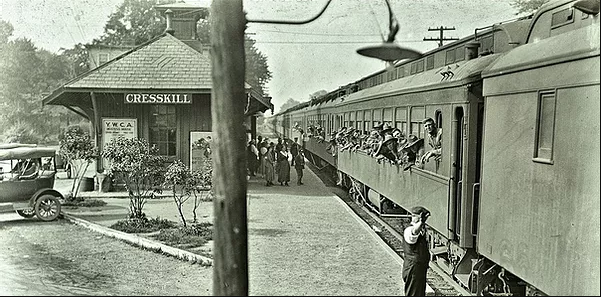
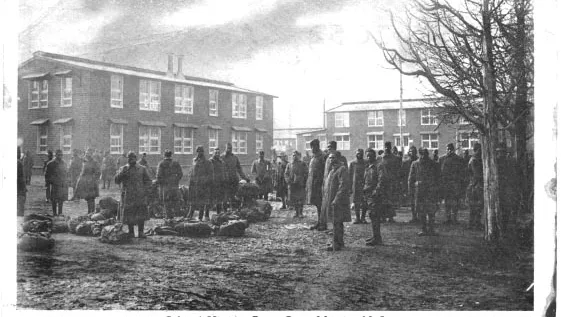
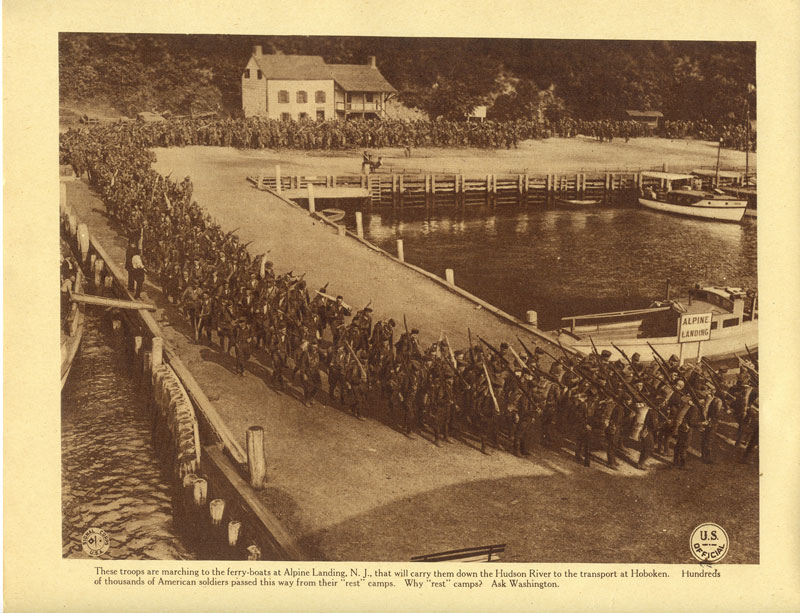
After a short layover in Camp Merritt, a week based on other June Replacements I've seen, Leo and the other men would be marched south for an hour to board ferryboats at Old Closter Dock, Alpine Landing, see the photgraph to the right, that took them to the pier to board troop transports for Europe. Contingents would leave the camp for the landing at half hour intervals to board the ferries for the two hour trip to the embarkation piers where several transports might be loading simultaneously.
During World War I, Bush Terminal was used as a United States Navy base as the United States Army's New York Port of Embarkation. The Terminal is now a Park in Brooklyn. This is on the north western side of Brooklyn, between 44th and 50th streets. The U.S. Navy first commandeered the piers and warehouses of the Bush Terminal Company on 31 December 1917. The United States Navy tied its rail lines into those of the Bush Terminal in 1918. Ultimately piers of the terminal became part of the United States Army's New York Port of Embarkation which at the war's end included eight piers in Brooklyn. The federal government quietly returned Bush Terminal to private ownership after the war.
Leo would board the ship S.S. MENTOR at Bush terminal No. 4, in Brooklyn, on 27 June 1918 for the voyage to France, though, per its manifest, the ship seems to have had a destination of England. Ships going straight to France said so on the manifest. I suspect the ship did stop in England, probably in Liverpool. The troops then disembarked to be sent to a port in southern England by train, where they picked up another ship to a French port; Le Havre, Cherbourg, or St. Nazaire. This may have been a tactic to limit exposure to German submarines.

The MENTOR's passenger list included 4 companies of the June Automatic Replacement Draft from Camp Cody (Nos. 4, 10, 11, & 13), each with a 2nd Lieutenant in charge, comprising a total of 1000 men, including:

"Co. I0 [10th Training Company], Camp Cody June Automatic Replacement, Infantry I [Company I?] - 683 - R Draft [Replacement Draft]
. . .
Hissem, Leo W. I42298I Pvt. Inf. Arthur W. Hissem Father Douds-Leando, Iowa" - from US Army WWI Transport Service Passenger Lists
The only S.S. MENTOR I've been able to find for this period is a British cargo ship of the Blue Funnel Line of Alfred Holt & Company, based in Liverpool. It was built in 1914 and rated at 7,383 tons. The ship's name is from Greek mythology; many of the Blue Funnel Line had such names, i.e. Achilles, Laertes, Polyphemus. Mentor was the son of Alcimus in Greek mythology, who appeared in the Homeric epic The Odyssey. In old age, he was a close friend of Odysseus, who placed Mentor in responsibility of his son Telemachus, while the hero was away fighting at the Trojan War.

The MENTOR was, during this portion of the war, considered to be part of the U.S. Army Transport Service (USATS).
Another ship with a June Replacement Draft onboard, the S.S. NESTOR, also sailed on 28 June, but from Hoboken, New Jersey. It was presumably another Blue Funnel line ship; Nestor was a character in Homer's Iliad. NESTOR was part of a convoy attacked by a German U-boat on 8 July; no ships were sunk. That would have been in the eastern Atlantic, near the end of their voyage to England. Note that as the convoy system made successful attacks more difficult, the Germans began to concentrate on attacking shipping in Britain's coastal waters, as convoyed vessels dispersed to their individual ports (however, on 2 June 1918 the U-151 sank six American ships off the coast of New Jersey, so the troops would have reason to be nervous all the way across). Would two convoys have sailed the same day, crossing separately, or was MENTOR with this group? The NESTOR landed in Liverpool, England on 10 July. The soldiers left the ship and spent the night at Camp Knotty Ash, now Springfield Park, Liverpool. The next morning, they traveled by train to Camp Woodley at Romsey. On 14 July they traveled to Southampton, embarked on a boat and crossed the Channel at night, landing in Le Havre on the 15th. From Le Have they were sent to St. Aignan, the replacement depot, where they would be assigned to combat regiments.
The NESTOR arrived in Liverpool on 10 July, however, some ships had a longer voyage,
"in June I found myself at Camp Merrit. Here I was given a company of the June Replacement Draft and finally landed them at St. Aignan, having spent a solid month on the transport." - from the letter of a US Army officerHowever, I'll assume that Leo followed a similar path to NESTOR's company and arrived in Le Havre on 15 July.
Another ship sailing from the area on 28 June 1918 was the JUSTICA, leaving from New York. They also had a consignment of the Camp Cody June Automatic Replacement draft. She was sunk off Ireland on a return voyage to New York on 20 July 1918.
Once arrived in France the replacements were assigned as required. Infantry made up 60% of such replacements. So, Leo would not have known what unit he was going to until the final moment.
Leo was as a 'casual,' in Army terms, a soldier temporaily separated from his unit, as in one just released from hospital or in transit to a new unit. A causul company was, then, an organization of those in 'limbo.'
In France Leo was probably sent to the 1st Depot Division at St. Aignan-Noyers, Loir-et-Cher, France where he would be assigned to a particular unit. Known to thousands of doughboys as 'Saint Agony,' St. Aignan was a training cadre whose duties were to receive, train, equip, and forward replacements to front line units. It was located in the middle of France, about 150 miles south of Paris. Troops going home also went through the depot, so it was like the RePo depots of WW2.
| Repo Depot
Or repple-depple. GI slang for a Replacement Depot, a holding area for in-coming and out-going troops. At least one GI claimed it was just one step above the stockade as a place to be. For those on their way home, they would be billeted here while they awaited transport. They would check a bulletin board daily to see if they were on the list to ship out. |
However, with the need to get more troops to the front as quickly as possible, the stop at St. Aignan was probably a short one; his new regiment could provide any further training required. He could have been with them by the third week in July, depending on how much administration he had to get through. I've found another soldier enroute to Leo's new unit who also sailed on the S.S. MENTOR, Private Fred Kirchenbauer, from Clear Lake Minnesota. Perhaps they road the same train north. Kirchenbauer was killed in action on 30 July 1918; things could happen very quickly in war.
Private 1st Class Leo W. Hissem was assigned to Company I, commanded by Captain Henry Harnum Graves - per "Ohio in the Rainbow, Official Story of the 166th Infantry, 42nd Division" by Raymond Minshall Cheseldine. The Company was part of Battalion 3 (the troops would call it BAT3), of the 166th Regiment, Colonel Benson W. Hough commanding, of the 83rd Brigade, Brigadier General Michael J. Lenihan commanding, of the 42nd Division, Major General Charles T. Menoher commanding. Initially the 42nd was part of V Corps, but in the last month of the war was redesignated as part of I Corps.
I had assumed during earlier researches that Leo would be in the 168th Regiment since that was the old 3rd Regiment of Iowa National Guard infantry. However, by the time Leo enlisted the National Guard regiments had already been brought into Federal service.
| The Rainbow Division & Douglas MacArthur in World War I
The 42nd "Rainbow" Division had a war strength of 27,000 men. It was comprised of four Infantry Regiments, the 165th (formerly New York's 69th), the 166th (formerly Ohio's 4th), the 167th (formerly Alabama's 4th), and the 168th (formerly Iowa's 3rd), organized in two Brigades, the 83rd and 84th. The 83rd was comprised of the 165th and 166th Infantry Regiments and the 150th Machine Gun Battalion. The 84th was comprised of the 167th and 168th Regiments and the 151st Machine Gun Battalion.
As the war progressed Douglas MacArthur, originally the Chief-of-Staff for the Division, was promoted to commander of the 84th Brigade. See 42nd (Rainbow) Division History for an excellent account of this unit's history, including battle maps. |
| History of the 166th Regiment
The 166th infantry regiment of the 42nd division had been the 4th regiment of the Ohio National Guard infantry. The regiment was called into federal service on 15 July 1917 due to the United States entry into World War I. It was drafted into federal service on 5 August. It was reorganized as the 166th Infantry Regiment on 20 August and assigned to the 42nd Infantry Division's 83rd Infantry Brigade. It was under the commmand of Colonel Benson W. Hough and Lieutenant Colonel George Florence. It originally assembled at Camp Perry on Lake Erie where the Regiment was raised to a strength equivalent to a French Infantry Regiment of 3,600. The 1st Battalion, under the command of Major Rell G. Allen, was comprised of Companies A-D. The 2nd Battalion, under the command of Major Louis D. Houser, was comprised of Companies E-H. The 3rd Battalion, under the command of Major Frank D. Henderson, was comprised of Companies I-M. Company I was under the command of Captain Robert Haubrich and 1st Lieutenant Price W. Beebe. Early in September the Regiment organized to leave Camp Perry for Camp Mills, Long Island. The 166th was assigned an area at Camp Mills to the right of the main entrance, just across the road from New York's Fighting 69th. They were almost the last of the Rainbow Division to arrive. It was at this time that a Regimental newsletter, The Reveille, was first begun. It was continued through the war and the occupation of Germany. They only stayed a month at Camp Mills, for intensive training under French officers. However, a month doesn't seem like near long enough. They then transhipped for France. The 1st and 2nd Battalions went first, followed by the 3rd, and the Machine Gun and Supplies companies. While waiting for their transport, the latter units were engaged for duty as Military Police. The Regiment arrived on the Western Front in February 1918 and fought until the end of the war on 11 November. The regiment participated in the Meuse-Argonne Offensive and the Battle of Saint-Mihiel. The regiment returned stateside and was demobilized on 17 May 1919 at Camp Sherman, Ohio. "Hissen, Leo W" - from "All Ohio in the Rainbow: Offical Story of the 166th Infantry, 42nd Division in the World War" |
| The 42nd "Rainbow" Division
The Division assembled between 30 August and 13 September at Camp Albert L. Mills, pictured below, in Garden City, New York, which is on Long Island. The camp was established as temporary tent camp in September 1917 as a place to mobilize and train the 42nd Division. The 41st Division also trained there. The division paraded for Secretary of War Baker on 26 September 1917.
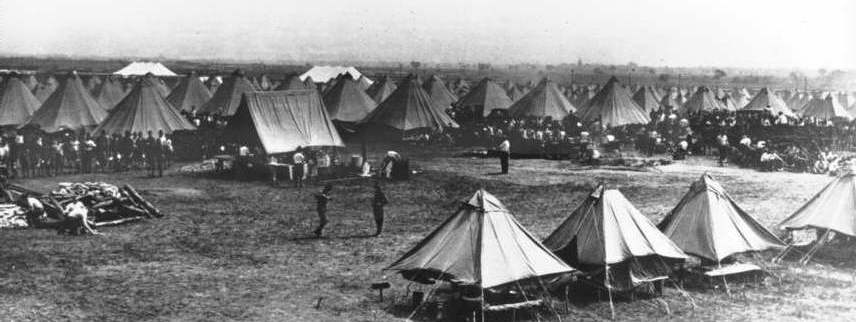 After training the Division departed from Hoboken, New Jersey for St. Nazaire, France. It started sailing in October and completed the Atlantic crossing in November 1917. |
| The 42nd "Rainbow" Division: the Champagne Defensive
Because of the lessening activity in the Baccarat Sector, the 42nd Division was withdrawn from the area in the third week of June. The division would never again return to trench warfare. On 21 June 1918 Supreme Commander Foch asked General Pershing to move the "Rainbow" Division to the Champagne-Marne to help the French in the coming battle to save Paris. The entire 42nd Division took part in that defense that stopped the German "Peace Offensive" on July 15, 1918. The area of Champagne where the front was located was bare and desolate. Except for the poppy fields in full-bloom when the division arrived, the area had almost no color. Plans were immediately formed to use the 42nd in a small offensive thrust against the Germans. However, those plans were never carried out. Instead, an attack large enough to bring an end to all hostilities was being planned. Intelligence reports gathered from German prisoners of war had confirmed French suspicions that the Germans were preparing for an all-out assault. On the night of 14 July the Germans were planning to strike the Allies, but the French and Americans attacked first. Thousands of French artillery guns began firing simultaneously. For four hours the barrage continued. The Germans retaliated and wave after wave of German infantry troops attacked the lines. Every attempt by the Germans to penetrate the lines was eventually repelled. The battle was a devastating loss for the Germans. |
The 42nd Division moved into the Champagne-Marne region in late June to help the French in the coming battle to save Paris. The entire 42nd Division took part in that defense that stopped the German offensive on 15 July 1918. Within the 166th regiment,
"Company I bore the brunt of the attack. This fact was undisputed. The description of the actual combat of the Morning of July 15, 1918, is perhaps best told in the words of Captain H. H. Grave, our belovied "Hell Roarin' Henry," born a German in Germany . . . later promoted and commanding Company I in the Champagne Defensive." - from "Ohio in the Rainbow"Oddly, the citation above does not relate any words of Captain Grave specific to Company I. Seeing the final culmination of the great German offensive and the over-extension of their lines, the Allies quickly prepared for a counter-offensive.
"By 5:00 A.M. July 19th, all the troops of the First Battalion [166th Regiment] were out of the trenches, and in, or enroute to Cuperly, the assembly point of the 166th Infantry." - from "Rainbow Memories; 1st Battalion, 166th Infantry" by Allison ReppyThe apparent discrepancy here is because Cuperly and St. Hilaire-au-Temple are adjacent villages. Elements of the 166th probably encamped around both. This region is near St. Menehould and just south of the German lines (see map of the Meuse-Argonne Offensive, below).
"On July 22nd the [166th] regiment entrained at St. Hilaire-au-Temple and headed for the field of open warfare north of Chateau Thierry . . ." - from "Ohio in the Rainbow"
If Leo arrived in France on 15 July, as we assume above, then he could have been at the RePo depot the next day, gone through a few days of admin there, and joined his unit between the 19th and 22nd.
BAT3 had been in the front line opposing the German assault in the last action and suffered badly and was, therefore, held in reserve in the rear of Viller-sur-Fere, north east of Chateau-Thierry.
"The Rainbow Division always wanted to go into battle as one unit with the infantry regiments and the artillery going in together. Its units had been building trust with each other and worked well together. But, this time the 42nd would be committed piecemeal over a period of several days. It caused a sense of unease throughout the division and was to lead to future controversies." - from The Battle of Croix Rouge FarmThe 167th and 168th regiments of the 84th brigade went into battle first on 25 July at the Croix Rouge farm. The following is the service record of another Iowa boy who left Camp Cody in June 1918 and became involved in the capture of the Croix Rouge Farm.
"Private Hawkins entered the service October 16, 1917, at Washington, Iowa. He became a member of Co. K, First Iowa Infantry and was transferred to Co. K, 133rd Infantry at Camp Cody, N. M. He went overseas with the June Replacement Draft, landing July 10, 1918. He was assigned to Co. E [BAT2], 166th Infantry, 42nd Division. He was killed in action at Chateau-Thierry July 27, 1918, by a high explosive shell."17 days from landing in France to his death! The following is from a letter written by a soldier in Company D [BAT1] of this regiment.
"Sept. 1, 1918The following is also relevant, if a bit chilling.
Dear Folks,
Will try to write you a few lines this afternoon. It is a beautiful day and ten months ago today we first saw France and we have certainly traveled over some of it since, but I am still on top and feeling fine. I haven't heard from you for a ling time or any of the rest of them. We have been pretty busy lately although we are back of the lines. The new men that comes in don't know anything and they drill them with us to learn them quicker. There isn't mutch (sic) to write about here. We are camped out in a field and can get passes to go over to a pretty good town at night. There are 87 men and one officer left with us that came from Marion. Some of them have been discharged, some transferred to other outfits, and some are in the hospital. I've never even had to talke a pill yet. Have you got that insurance policy yet and your money? You should get that regular every month because it comes out of my pay here. I believe I would like to live in France in peace times. It is a beautiful country. A man with a small income could live here like a prince but everything is out of sight now. Tell Mollie that I've wrote her about a dozen letters since I've been over here but she says she only got one. I've wrote to Cary and Edna too since I've heard from them. I'm going to send you my first service stripe after while. We will soon be wearing two of them. I'll send you that insurance card in this letter also a Reveille. It tell some news. Well I guess this is all foe this time hoping this finds you all in good health. I remain,
Your sonny,"
"Replacements [for the 166th] were received in several companies just before the outfit relieved the French on July 25th. H Co. [BAT2] got 67 of these men, who were fresh from the States. Others fared likewise. Most of these green men were left in the wheat fields [i.e. were killed in combat]. It is one of the most deplorable circumstances of the war. The same thing happened in the Champagne Sector. The night before the attack several hundred new men came to the regiment. None had ever been under fire before. Many knew very little about a rifle. They went into action on the Champagne, and later at the Ourcq, in the hottest engagements of the war. They didn't have a chance." - from "Ohio in the Rainbow, Official Story of the 166th Infantry, 42nd Division" by Raymond Minshall CheseldineWhile I'm sure Leo knew something about a rifle after his training at Camp Cody, he had not been under fire and his squad-mates would not know whether he could be trusted in a fire-fight. He wouldn't be considered a full member of the squad until he had had his baptism of blood.
On 27 July [the day Private Fred Kirchenbauer was killed] the 83rd Brigade joined the already engaged 84th. Regiments abreast, the full "Rainbow" Division attacked across the Ourcq River and opened the battles on the hills east of the river. After four days of hard fighting by both sides, the Germans began a massive retreat toward the Rhine River on 2 August. Casualties in this operation for the "Rainbow" were 184 officers and 5,469 men.
| The 42nd "Rainbow" Division: Chateau Thierry & Croix Rouge Farm
After the German defeat General Foch immediately put the victorious Allied Army on the offensive. Four days after winning in the Champagne, he ordered a Franco-American drive northeast from the town of Chateau-Thierry. For the first time in a long while the Allies went on the offensive. On 27 July, a day after the division's arrival in the Marne, the 42nd attacked and captured the Croix Rouge Farm in hand-to-hand combat. This position was vital for the crossing of the River Ourcq and an attack of the German strongholds on the other riverbank, known as the Tardenois. After repeated attacks the 42nd was able to cross the River Ourcq, but sustained heavy casualties in doing so. On the other side of the lines, the Germans had been ordered to hold the Tardenois Area at all costs. Unfortunately the Army Staff had assumed that the Germans were rapidly retreating with only a small rear guard left to cover their withdrawal. Instead the Germans were dug it behind protecting woods, stout stone walls and farm buildings where they had planted their heavy machine guns and mortars in a determined defense. On 29 July the 3rd Battalion of the 166th was brought forward and crossed the Ourcq river in support of the attack on the village of Sergy. By the 30th, out of a strength of 252 men on the 28th, they could muster just 158 effectives, having suffered 94 casualties. As a result, the division would receive another influx of replacements. 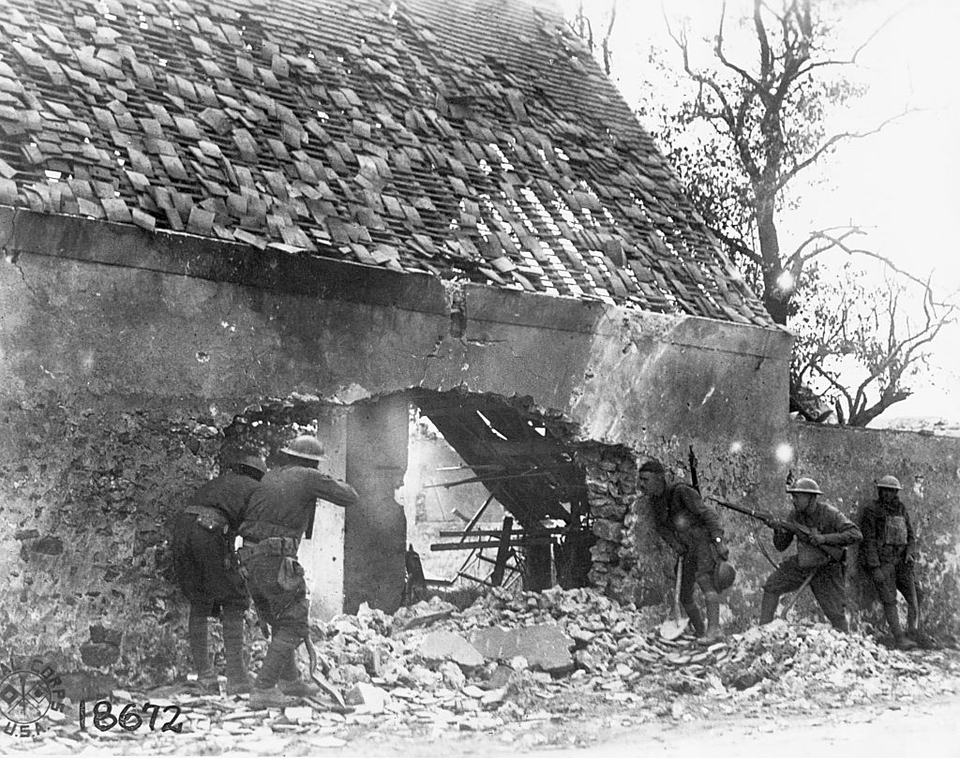 Soldiers of the 166th Regiment during urban combat in Villers-sur-Fere 30 July 1918 After a week of heavy fighting the 42nd moved forward in conjunction with the 32nd Division. This time the divisions met no resistance, the Germans had withdrawn during the night. In eight days of fighting the 42nd Infantry Division had recorded one of the greatest advances in the war. It had cost them dearly, however. The division sustained heavy losses, 184 officers and 5,469 enlisted men were killed or wounded. The Chief of Staff of the 42nd, Major Douglas MacArthur, had disagreed with this offensive and the cost paid for it. |
Leo was definitely with the regiment, and in Company I, by the end of July 1918.
"Hissen 1422981 Leo W Pvt" - from Statistical Report Co. I 166th Inf. July 31, 1918, signed H.H. Grave, Capt.I believe the Company was held in reserve from the following action.
"On 29 July the 3rd Battalion of the 166th was brought forward and crossed the Ourcq river in support of the attack on the village of Sergy. By the 30th, out of a strength of 252 men on the 28th, they could muster just 158 effectives, having suffered 94 casualties. As a result, the division would receive another influx of replacements."
The 42nd was put into reserve to recuperate during the month of August.
| Germany's Last Offensives
As the Allies pushed forward in August General Ludendorff realized his massive offensives had been a failure and finally began to see the war as a lost cause. The German army too knew this and no man wanted to be the last one to die in the defeat to come. |
The commander of Company I was Captain Henry H. "Hell Roarin'" Grave through the first phase of the Argonne offensive. He was supported by 1st Lieutenants Bush, Christian, Smith, and Lippitt, and 2nd Lieutenant Slutz.
"Hissen 1422981 Leo W. Pvt." - from Statisical List of Co I 166th Infantry of August 31, 1918
| The 42nd "Rainbow" Division: the Battle of Saint-Mihiel
The Battle of Saint-Mihiel was fought from 12-15 September 1918. It was the first large offensive launched mainly by the United States Army in World War I, and the attack caught the Germans in the process of retreating. After the fighting at the Croix Rouge farm, the 42nd was withdrawn from the front lines and sent back to the valleys of the Marne. The uniforms of the men were tattered and torn from months of heavy fighting. During the first days the men were able to bathe in the waters of the Marne. Replacement equipment and clothing were supplied. On 30 August 1918 the 42nd was ordered north. It had been rumored that a major operation was being planned for the St. Mihiel Salient. After its arrival, the division waited for its orders to attack. On 11 September the order was given. The 42nd, in support of the IVth Army Corps, attacked the German forces. The Corps' artillery met with little response from the Germans. American artillery began a four-hour bombardment. With artillery guns laying a perfect line of fire in No Man's Land, American infantry troops began to attack the Germans in wave after wave. After initial difficulties in the regions of St. Baussant and the Bois de la Sonnard, the 42nd was able to roll on to its first-day objective. On the morning of the 13th, the division reached its final goal in the city of St. Benoit. On 14 September the 42nd began digging fortifications around the St. Benoit. The 42nd occupied the area for the next two weeks until it was relieved by the 89th Division. 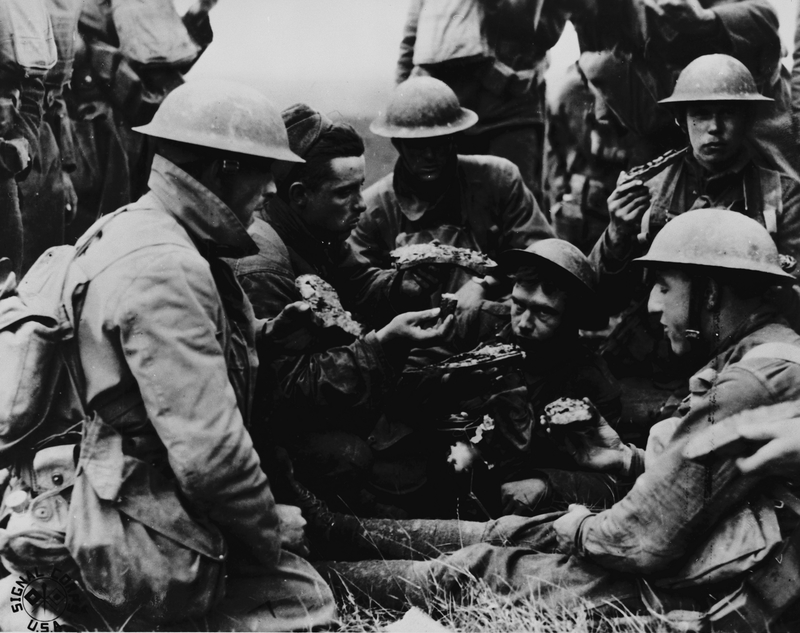 Members of the 166th Infantry eat captured German bread, jam, and pickles during World War I, 14 September 1918 |
Another letter from the soldier above,
"Sept. 23, 1918
Co. D. 166 Inf.
Dear Folks,
Will try to write you a few lines this morning. It is cloudy and has been trying to rain but we got a dandy little house with a stove in it so it is pretty comfortable here. We haven't been doing and thing for a week but eating and sleeping and cleaning up. I wouldn't care if they kept us here all winter. When you write, just the company and regiment on it. Don't put anything about the brigade or division like this, Co. D 166 Inf. American E. F. Be sure to write American in full because there is an Austrailian E.F. over here too I think. That is the reason I don't get lots of your letters. I get letters from the rest of them pretty regular now but we don't get to write for a month or six weeks sometimes when we are at the front. I guess that money will come out all right. Don't be afraid to spend it for yourselves. That is what money is for. Everybody seems to think that the war will end pretty soon. I hope so anyway. I'd like to have some fried chicken and mashed potatoes and cornbread. We gave the Germans quite a chase this last time, took a lot of prisoners too. I saw German prisoners go back to the prison camp without any guard and seemed tickled to death to go. We got lots of cannons too and alittle of everything else but they burnt up lots of stuff rather than let us get it. We freed some French civilians too that had been prisoners 4 years. Mostly women. They had little children by German fathers. I guess the Kaiser knows that Uncle Sam is in the war now allright. They haven't won anything from the Americans yet. Well I guess this is about all for this time.
Your son"
| The 42nd "Rainbow" Division: the Meuse-Argonne Offensive
The Argonne Offensive began on 26 September and lasted until the end of the war on 11 November 1918. From the first artillery barrage of September 25, three weeks of difficult fighting had exhausted numerous Army divisions for little gain. The Americans had launched a series of costly frontal assaults that finally broke through the main German defenses, the Krimhilde Stellung of the Hindenburg Line, between October 14–17, also known as the Battle of Montfaucon. During the battle Missouri and Kansas National Guard soldiers were the first U.S. troops who tried to break through the stronghold of the Hindenburg Line at Cote de Chatillon but they were repulsed due to poor leadership. Next, the elite U.S. 1st Infantry Division tried and failed after suffering catastrophic casualties. The 42nd 'Rainbow' Division had begun a movement on 1 October to the Meuse-Argonne front. After marching for two days, the 42nd arrived at the Bois de Montfaucon. From there the 42nd was ordered to take over the city of Exermont. For the next two weeks, the men were continually deluged with rain. After the failures of the previous attacks it was now the turn of the 42nd Division under Brigadier General Douglas MacArthur. They would attack with all four regiments of the 83rd and 84th brigades abreast. Maj. Gen. Charles Summerall, commander of the Army's V Corps, visited the 84th Brigade on 13 October, before the attack began. "Give me Chatillon or a list of 5,000 casualties," Summerall told MacArthur. The former Rainbow Division chief of staff replied that if they failed, the entire 84th Brigade would be on the casualty list, with his name at the top. The attack had to be made across open ground to formidable German defensive lines just three kilometers ahead. The Division was finally able to take Cote de Chatillon after exposing a gap in the German defenses that was discovered by MacArthur's soldiers. This victory was considered the decisive turning point of the whole Meuse–Argonne offensive. By the end of October, U.S. troops had advanced ten miles and cleared the Argonne Forest. On their left the French had advanced twenty miles, reaching the Aisne River. It was during the opening of this operation, on October 8, that Corporal, later Sergeant, Alvin York made his famous capture of 132 German prisoners near Cornay. For the next three and half months the 42nd Infantry Division became part of the Army of Occupation in the Rhine, remaining in Germany until the spring of 1919. Before it left the Rhine a commendation was delivered by the command of the Rainbow Division: "The arc of the Rainbow will, it is understood, shortly touch the shores of the United States. Before leaving, the Rainbow renders its deep reverence to those who so gallantly met their death under its flag. To those others who have either been with the division or are now with it, it accords its admiration for their splendid, devoted and most courageous services. It wishes them all the best of fortune, it hopes that each of them will find, at the end of the Rainbow, the storied pot of gold."At the conclusion of hostilities, the 42nd Division was credited with 164 days of actual combat, the third longest of any American division. They suffered a 30.6% casualty rate with 2,810 killed and 11,873 wounded. They captured 1317 German prisoners. The division counted in its leadership Douglas MacArthur, William J. "Wild Bill" Donovan, later known for his service as the head of the OSS in World War II and for founding the CIA, soldier-poet Joyce Kilmer, Father Francis P. Duffy, plus future secretaries of the Army and the Air Force and two who would become Army Chiefs of Staff. George S. Patton's tanks supported the Rainbow Division during the St. Mihiel operations, the first time the legendary Patton planned for the use of tanks on the battlefield. |
"Hissem 1422981 Leo W Pvt." - from Monthly Muster Report Company I 166th Regiment of September 30, 1918
From an account of the Meuse-Argonne battle by a member of the 42nd Division:
"Nobody wants to talk very much about the recent battle," New York National Guard Chaplain Father Francis Duffy wrote in his diary entry in October 1918. "It was a nightmare that one does not care to recall. Individual acts do not stand out in actions of this kind. It is a case of everybody going ahead and taking the punishment," Duffy recalled.See also Captain Russel Baker, Company D, 166th Regiment and Captain Theodore Bundy, 37-MM Platoon, 166th Regiment for detailed reports of the Argonne campaign by regimental participants taken for the Advanced Course at the Infantry School at Fort Benning, Georgia.p>
The punishment that Duffy's unit, the 165th Infantry Regiment -- formerly the 69th Infantry of the New York National Guard--took during the month of October 1918 was heavy indeed. The 165th started the month with 3,564 men and officers. On October 31 the unit reported 1,908 men and officers present for duty, according to the American Battle Monuments history of the division.
The 165th, part of the 42nd "Rainbow" Division made up of National Guard units from 26 state was smack in the middle of the Meuse-Argonne offensive. With 1.2 million Doughboys committed -- more than the 500,000 GIs who fought in the Battle of the Bulge or the 156,000 who landed in Normandy during World War II--the Meuse-Argonne is still the largest American battle in history. Twenty-seven divisions were involved in the fighting.
During the battle, which kicked off September 25 and continued until the end of the fighting on November 11, some 26,277 Americans were killed and 95,786 wounded; a casualty rate of 10 percent. The 42nd Division began the battle after their refit from the September St. Mihiel offensive with a nearly full complement of 26,794 Soldiers and officers. One month later the division reported a strength of 20,119 on October 31.
The Doughboys were fighting not only against formidable German defenses but also dealing with difficult terrain. In the Argonne Forest visibility could be limited to 20 feet. But for other Soldiers, like those in the 42nd Division, the fight would carry them through open fields of fire near the Meuse River where the enemy could easily spot them.
From the first artillery barrage of September 25, three weeks of difficult fighting had exhausted numerous Army divisions for little gain. In mid-October, the 42nd Division entered the battle, bringing fresh troops to the fight. The Rainbow Division attack would cross open ground to formidable German defensive lines just three kilometers ahead. "Our attack had to be made over open ground with the purpose of carrying by direct assault wired entrenchments," Duffy wrote of the terrain. "It was the warfare of 1916 and 1917 over again."
The objective was the German stronghold at Cote de Chatillon, part of the defensive line known as the Kreimhilde Stellung. The Rainbow would attack with all four regiments of the 83rd and 84th brigades abreast. Maj. Gen. Charles Summerall, commander of the Army's V Corps, visited the 84th Brigade, under the command of then-Brig. Gen. Douglas MacArthur, October 13 before the attack began. "Give me Chatillon or a list of 5,000 casualties," Summerall told MacArthur. The former Rainbow Division chief of staff replied that if they failed, the entire 84th Brigade would be on the casualty list, with his name at the top.
"Stokes mortar being fired by men of 165th Inf., 42nd (Rainbow) Div., who, after relieving the 1st on nights of Oct. 11-12, captured Hill 288, Hill 242, and Cote de Chatillon on the 15th. They were at the front again Nov. 5."
In two days of bloody fighting, MacArthur and his Alabama and Iowa Soldiers almost reached Summerall's casualty count, with MacArthur constantly at the front lines, ignoring the threat of shrapnel and bullets to set an example for his troops.
From the start, problems arose. A gap formed between the advances of the two brigades. The New York and Ohio Soldiers of the 83rd Brigade advanced farther, as MacArthur's regiments tackled defensive farms that drew in their manpower. This exposed the New York regimental flank to devastating German fire. The New York Soldiers of the 165th Infantry found themselves facing machine gun and mortar fire from two sides, trapping them short of their objective.
"The situation was a stalemate," Duffy noted in his 1919 Father Duffy's Story. "We had made an advance of three kilometers under desperate conditions, but in spite of our losses and sacrifices we had failed to take our final objective. Well, success is not always the reward of courage." Infantry regiments lost some two-thirds of their fighting strength in the initial 24 hours of fighting.
The 165th Infantry, for example, crossing open ground and facing flanking fire, had only 186 Soldiers remaining in its 1st Battalion, 480 in the 2nd Battalion, and 496 in the 3rd Battalion. Consolidating after the first day, MacArthur devised a plan for a night attack using only the bayonet to seize Cote de Chatillon. The belief was that enemy machine guns would not be able to locate Doughboys without the flash the of their rifle fire.
The Soldiers of the Alabama and Iowa regiments were spared the daring assault when Maj. Gen. Charles Menoher, the division commander, canceled the operation in favor of a renewed artillery barrage the following morning. General John J. Pershing, commanding the entire American Expeditionary Force, noted the difficulties in the American advance in the 1923 Records of the Great War by Charles Horne. Divisions were fighting "to the limit of their capacity," Pershing said. "Combat troops were held in line and pushed to the attack until deemed incapable of further effort because of casualties or exhaustion."
By October 16th, with German forces spent almost as much as the Doughboys, the Rainbow Division's 84th Brigade reached the crest of Chatillon and held it against German counterattack, allowing the division's line to reach its objective. With Company M of the Alabama 167th Infantry Regiment was Private Thomas Neibaur, a replacement National Guard Soldiers from Sugar City, Idaho. When Neibaur's fire team moved around a hilltop objective to provide enfilading fire, his element met a German counterattack. "I looked up..I saw about 40 to 45 Germans coming up directly toward me," Neibaur recorded after the war. "I quickly turned my automatic rifle on them and fired about fifty shots." Wounded three times in both legs, his two teammates killed, Neibaur fought off the counterattack with his automatic rifle until only 15 enemy were in close range. Neibaur killed four Germans and captured the remaining eleven. He received the Medal of Honor for his actions.
Relieved on October 18, the Rainbow Division was not quite through with the campaign. Refit with replacements and equipment, the division was back in the line by November 5, pursuing retreating German forces. "The retreating Germans were almost always only about an hour ahead of us," said Lawrence Stewart, a medic in the Iowa 168th Infantry Regiment in his 1923 account, Rainbow Bright. "The rear guard put up a fight, but the columns in advance gave a lifelike imitation of a foot race."
In the final hours of the war, the American objective was the French city of Sedan, where France had surrendered to Germany in 1871, ending the Franco-Prussian War. With the 42nd and 77th Divisions under the command of I Corps and the 1st Division from V Corps all attacking towards Sedan, Maj. Gen. Summerall allowed his 1st Division to cross the corps boundary in an effort to encourage speed in taking Sedan. But crossing boundaries has its own risks for confusion, traffic and friendly fire when units intermix.
On the night of November 6, with Rainbow Division Soldiers of the 165th Infantry in the outskirts of Sedan at Wadlaincourt, a patrol of the 1st Division led by a lieutenant detained an odd-looking prisoner. "All he saw in the gathering dusk was an important looking officer walking around, attired in what looked like a gray cape and a visored cap with a soft crown, not unlike those the Crown Prince wore in his pictures," wrote Raymond Thompkins in his 1919 The Story of the Rainbow Division.
Capturing the odd-looking officer near the front, "they got him back to a brigade headquarters of the 1st Division, before Brig. Gen. Douglas MacArthur, commanding the 84th Brigade of the Rainbow Division, could convince them that it was himself and not an officer of the German Army."
The race to Sedan was set aside the following day when French forces liberated their city. With American forces across the Meuse River, Germany began to seek peace terms November 8. As Rainbow Division Soldiers reorganized to continue the allied attack, word spread through the lines that fighting would end at the 11th hour of the 11th day of the 11th month. The Great War was over." - from N.Y. National Guard's Rainbow Division combat in Meuse-Argonne helps bring an end to WWI By Col. Richard Goldenberg, New York National Guard
Captain Grave was put on the casualty list on 15 October with five others, leaving a Lieutenant Uden, who had joined the Company in August, as the only officer of the Company. Captain Grave was relieved the next day by Captain Virgil W. Peck.
"Hissen 1422981 Leo W Pvt" - from Statistical Report Co. I 166th Inf. October 30, 1918, signed H.H. Grave, Capt.
Sometime after this muster, in one of the last battles of the war, Leo received a gun shot wound to the chest. Per my father, he did not take part in the occupation of Germany, as did the Regiment.
"Sent to Hospital and Not ReturnedAccording to information gathered by my Uncle, Richard Six,
. . .
Hissen, Leo W Pvt" - from "Ohio in the Rainbow, Official Story of the 166th Infantry, 42nd Division" by Raymond Minshall Cheseldine.
"Leo was a disabled veteran of WWI, seriously wounded and exposed to mustard gas during his service in Europe. His injuries included the loss of one lung and a wound in his side that was left open to drain for the remainder of his life. In later years he lost an eye as a result of his war injuries."A wound left open to drain for the rest of his life? How could that be? Was this 'draining wound' a euphamism for a colostomy bag, which would imply a wound to the lower abdomen? Note that the Germans used gas shells in their artillery throughout the Meuse-Argonne offensive.
Leo must have been injured between 30 October, the last time we know he was well, and the Armistice on 11 November. Where was Leo during this time?
The 166th regiment was held in reserve from 31 October to 2 November. On 1 November the regiment was administratively transferred from V Corps to I Corps.
". . . by evening of October 31st, the 166th Infantry, less the 2d Battalion [Leo was in BAT3] still in the line, found itself bivouacked in the vicinity of Charpentry, about three kilometers southeast of Exermont, where it remained for three days before again taking an active part in forcing the enemy back to the Meuse River." - from "Company "C" 166th Infantry 42nd Division in the 2D and 3D Phase of the Meuse-Argonne October 12th - November 10th, 1918" by Captain Russell Baker, InfantryDuring this time a large artillery assault began and the Marine 2nd Division led the assault on German lines forward of the 42nd. The attack gained such momentum that the 42nd was sent back into the line on the 3rd.
In the early morning of 3 November the 166th regiment marched out of Charpentry and, after a long day's hike (18 kilometers), they arrived in Verpel. Clearly little fighting occurred during this advance; the 42nd were acting as 1st Corp reserve following the 78th Division.
On the 4th, after a rainy night and little to eat (the supply train was delayed due to congestion on the road), they continued, finally arriving in the vicinity of Authe. Orders were received late that night to pass through the 78th and take up the lead in the pursuit of the rapidly retiring German army.
On the 5th the unit's line of departure was Les Petites-Armoises-Verrieres. That same day they cleared "the Bois de Mont Dieu of the enemy." - from Baker and Reppy, as above. The last was another village enroute to Sedan. Apparently there was stiff resistance here, "certainly the memory of that night in the woods will ever remain with every man who was there." This could be the moment Leo was injured. Note however that BAT3 was, at that time, advancing in trail of BAT1 and BAT2, and so might be considered to be in least danger. The regiment forced its way into the village of Chemery just after the Germans had evacuated it.
On the 6th the regiment continued to push the Germans north, arriving in La Neuville-a-Maire, just south of Chemery, as the Germans withdrew.
On the early morning of 7 November BAT3 passed through BAT1, taking the lead in the advance. There was some confusion at this point, elements of the 1st Division overlapping on the 42nd division sector. "It was a ridiculous piece of maneuver, but apparently to their orders. They tried desperately to take advanced positions but the 3rd Bn. under Major Haubrich was not to be stopped. The race [to Sedan] must be won." Later that morning the leading battalion (presumably BAT3) was taking machine gun and artillery fire beyond Chemery, but its advance was uninterrupted. The German resistance was stiffening as they tried to protect their retirement beyond the Meuse river. All three battalions continued to push forward under intense fire, BAT3 entering Chevauges, though apparently not remaining as the battalions dug in just south of the village.
That night the regiment was relieved spelling an end to their fighting in the Argonne. They fell back to Chemery and, later, La Neuville. Meanwhile the 40th French division was granted the honor of taking Sedan. That same day German government officials entered Allied lines requesting an Armistice.
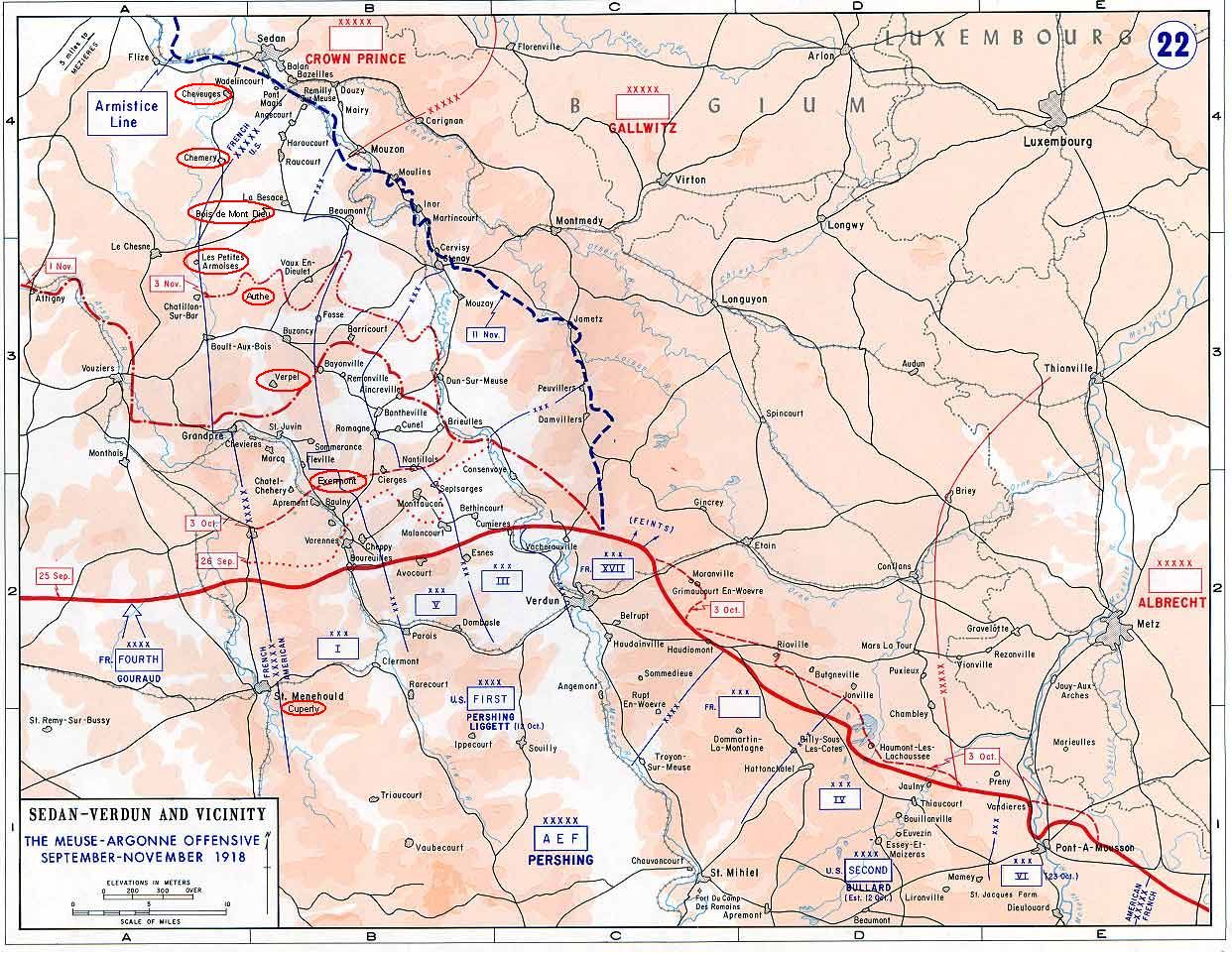
I'll assume that Leo was injured sometime between 4 and 7 November; that is, between the villages Authe and Chevauges. I would suggest that the 7th, when BAT3 took the lead, was the most likely date. Leo was dropped from the muster of his Company on 21 November (as were a great many other men of the unit). This was ten days after the armistice.
"Losses During Month (cont)115 men of the regiment were lost during the month! Most of these were dropped on the 21st. I expect this was an administrative date, the men having been injured or killed during the last days of the fighting, then not removed from regimental roles until directed to do so from above. The 42nd Division was participating in the Sedan fighting during the "Drive to the Rhine" when the war ended on 11 November.
. . .
Privates
. . .
49. Hissen, Leo W 1422981 Dropped November 21" - from the "Roster of Company I, 166th Infantry, Midnight November 30, 1918
The system for the delivery of medical care on the battlefield was based on the premise of providing a process of progressive treatment and evacuation. At the front line were litter bearers who would take casualities to dressing stations. From there ambulances would transport the injured to field hospitals. After the patient was stablized they would be sent to evacuation hospitals, thence, if necessary, to a base hospital, via railroad, for advanced care. See Delivery of Medical Care On the Battlefield and Delivery of Medical Care Off the Battlefield.

Leo was probably first evacuated to a frontline mobile medical unit and then to an evacuation hospital. The 42nd Division had four mobile Field Hospitals, Nos. 165, 166, 167, 168, and four Ambulance Companies, Nos. 165, 166, 167, 168. The latter were a mix of horse-drawn and motor vehicles. The third level of care was the Base hospital, located some distance behind the front lines. There, operations of all kinds were performed, and patients were kept until they were ready for discharge or transfer to port hospitals for transport home. Ultimately, 120 base hospitals were established, 49 of them affiliated hospitals organized and staffed by volunteers from U.S. hospitals and medical schools. For transportation reasons, base hospitals were eventually grouped into hospital centers.
An evacuation hospital, number 15, was located in Revigny-sur-Ornain, in the Meuse department, just southeast of where Leo was probably wounded. Carpentry, where Leo's unit was on 31 October, is about 25 miles north of there. Sedan, is about 60 miles north. There was also a base hospital there, number 83. The majority of the patients were evacuated as soon as they were in condition to travel via special hospital trains. More hospitals were in the Haute-Marne and Vosges departments, just to the south.
Leo was eventually evacuated through Base Hospital #216, in Nantes, Loire-Atlantique department; a Type A unit. This hospital handled all evacuations from Europe.
| Base Hospital #216
The hospital center at Nantes, Department Loire Inferieure, was organized on 29 July 1918 at Doulon, a suburb of Nantes. One base hospital unit (No. 34) was located at Nantes, about 3 miles from the center proper. The group originally consisted of three base hospitals, Nos. 34, 38, and 11, and to these was added Base Hospital No. 216, on 1 November 1918, which had been organized from personnel in the center. It was assigned to a standard type A, 1,000-bed hospital of cement, fiber construction, with an emergency expansion to 1,800 beds. When taken over, it contained about 1,200 patients, the overflow from Base Hospitals Nos. 11 and the adjacent 38. The hospital handled chiefly medical cases. The greatest number of patients in the hospital at one time was 1,514 on November 7, 1918. In January, 1919, the hospital was designated as the evacuation hospital for the center, and all patients evacuated directly to the United States were sent through this unit. A total of 6,367 patients were handled by the evacuation department. Base Hospital No. 216 ceased to function on June 21, 1919, and its personnel returned to the United States; sailed from St. Nazaire, July 6, 1919, on the Matsonia; arrived in the United States July 16, and were demobilized at Camp Dix, N. J., July 21, 1919.  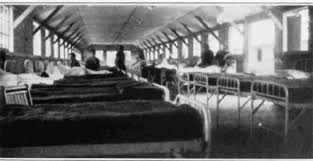 Left: A typical Type A Hospital (#38) Right: Inside a Type A unit |
Leo returned to America, first on a special train from the hospital center in Nantes to St. Nazaire, then, via ambulance, to board the USS RIJNDAM. The ship sailed from St. Nazaire, France on 3 April 1919, almost five months after the armistice. Leo's injuries must have been very severe. St. Nazaire is the port downriver from the hospital in Nantes. This portion of the ship's complement was described as,
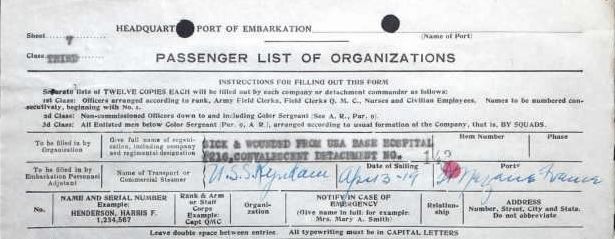

"Sick & Wounded from USA Base Hospital #216, Convalescent Detachment No. 142
Transport: U.S.S. Rijndam Date of Sailing: April 3-19 Port: St. Nazaire, France
. . .
(Class 2 - Requiring Dressings in Standees)
. . .
No. 159 Hissem Leo W. Pvt. Inf Co.I 166 Inf Mrs. Tillie Hissem Mother Douds Iowa
1422981 GSW Right Chest "
USS RIJNDAM (ID-2505) had originally been the SS RIJNDAM [RYNDAM], an ocean liner of the Holland America Line.

Interesting, though confusing, is the following.
"The transport Mercy sailed from St. Nazaire April 6th and is due to arrive in New York April 20th with the following troops:I don't know, perhaps the MERCY was simply carrying more of Detachment 142.St. Nazaire Convalescent Detachments Nos. 132, 135 to 142, inclusive, 10 officers, 375 men.
Included in the foregoing are sick and wounded classified as follows: Bed ridden, 8 officers, 276 men; requiring no special attention, 2 officers, 99 men; Medical Detachment for duty, 1 officer." - from "United Business Service, volume 1"
Back in the United States, Leo spent a short time in Army hospitals recovering. He was finally discharged on 30 May 1919, perhaps six weeks after coming back to America. It is interesting that the 166th Regiment, who had served in the occupation of Germany after the war, was itself discharged before him, on 17 May 1919 at Camp Sherman, Ohio. Leo's rehabilitation must have been extensive.
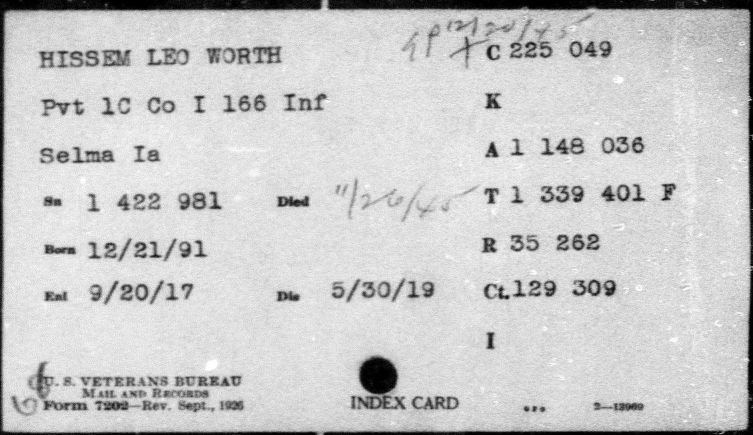
| Serial Number 1 422 981
First Letter: 1 = Enlisted in the Army, not drafted. |
| C: Claim #225 049
A claim number was assigned whenever a veteran made application for benefits such as service connected disability, pension, and education and training. K: Life Insurance #The War Risk Insurance Act and subsequent regulations from the Bureau of War Risk Insurance provided that the insurance held by a soldier while in the service could be continued in the same form, at the same rates, and with the same benefits for a period of five years after the termination of the war if the member so chose. A: Adjusted Compensation #1 148 036A discharged soldier was provided a $60 bonus [almost $1000 today] as a bridge to civilian life and well as a per mile amount to get back home. In 1924 [note that the card above was the 1926 version of the form] the Federal Governmeent passed the World War Adjusted Compensation Act. It awarded veterans additional pay in various forms, with only limited payments available in the short term. The value of each veteran's credit was based on each recipient's service in the United States Armed Forces between April 5, 1917, and July 1, 1919, with $1.00 awarded for each day served in the United States and $1.25 for each day served abroad. It set maximum payments at $500 for a veteran who served stateside and $625 for a veteran who served overseas. It authorized immediate payments to anyone due less than $50. The veterans were given an "Adjusted Service Certificate" which functioned like an insurance policy. Based on standard actuarial calculations, the value of a veteran's certificate was set as the value of a 20-year insurance policy equal to 125 percent of the value of his service credit. Certificates were to be awarded on the veteran's birthday no earlier than January 1, 1925, and redeemable in full on his birthday in 1945, with payments to his estate if he died before then. In 1932 a 'Bonus Army' gathered in Washington D.C. demanding an early payment due to the ravages of the Depression. T: War Risk Insurance #1 339 401 FWhen war broke out in Europe in 1914, commercial merchant ships supplied war materials to the allies in the war against Germany – but they could not get marine insurance from private companies. Congress passed the War Risk Insurance Act on September 2, 1914, providing marine insurance protection for merchant ships supplying the allies, since private insurance was not available. When America entered the war against Germany in April 1917, the War Risk Insurance Act was amended on June 12, 1917, to cover merchant marine personnel and again on October 6, 1917, authorizing for the first time issuance of government life insurance to members of the armed forces. The cost of the insurance was between $6 and $7 per month. In case of the member's death the policy paid out $57.50 a month to the beneficiaries for 20 years. "In case of DISABILITY, compensation is payable to the disabled person himself. If the disability is TOTAL, the amount of compensation varies from thirty dollars ($30:00) to ninety-five dollars ($95.00) per month, according to the size of the disabled man's family. In exceptional cases, a sum not exceeding twenty dollars ($20.00) per month additional may be paid for the services of a nurse.R: Rehabilitation #35 262 Not yet sure, but probably for follow-on care for the veteran back at home. Ct: WWI Certificate #129 309, issued with BonusCertificate number assigned in conjunction with the World War I Bonus. The certificates were issued by service departments. I: Permanent Disability #Numbers prefixed with the letter "I" were assigned on permanent and total disability claim or death for payment of term insurance. [Why didn't Leo have one?] |
I recently found the following narrative on the Van Buren county, Iowa website. It conflates the entire history of the division with the service of Leo.
"Country Facts and Folklore
By Andy Reddick
An Injured War Veteran From DoudsThe men were intrigued with the stories that circulated around camp. Legendary Joan of Arc was born in the hills surrounding them, and stories of her mission seemed to inspire them. They were behind the lines--close enough that they could hear artillery shells in the distance.
Iowa National Guard units joined those from other states and formed a division under Major Douglas MacArthur, who said that it "stretched over the country like a rainbow," and the phrase caught on and became the 42nd division's nickname.
It was November, 1917. Among the excited Iowa farm boys was a blue-eyed 25-year-old from the Douds community. In August, Leo W. Hissem, had enlisted in Keosauqua along with his cousin Weldon.
After much marching and target practice, the 42nd Rainbow Division was ordered to march to Chaumont in the Rolampart area, in December. They were to begin the march on the day after Christmas, but the area was blanketed with heavy, knee-deep snow, and the temperature dropped below zero. Still, the march began on schedule, with the wind whipping the snow into a white-out blizzard. General Washington's men at Valley Forge had nothing on these men.
The Rainbow went through intense, demanding training in all aspects of trench warfare during the next six weeks, then took the train to Lorraine, to the front lines, where they experienced direct contact with the German forces. The area had been quiet until the 42nd arrived, but they began bombarding the Germans who responded with brutal retaliation.
In the dark, wee hours of March 3, they were attacked by German bombardment shortly after midnight. After six hours of shelling, the infantry attacked at dawn. They held their ground and the Germans couldn't penetrate, even when the Germans included mustard gas in their attack. The 42nd took over Lorraine and the Baccarat Sector, and as they did, a rainbow appeared over the skies--to them, a sign of good luck.
German activity lessened by mid-April, and the 42nd began reconnaissance missions to observe the Germans and acquire intelligence. When the Americans led day raids, the Germans responded by nightly retaliation. By June, activity was infrequent, and the 42nd was sent to a bare, drab, desolate front where only a few poppy fields provided color.
The Germans planned an attack on July 14th, but the Americans and French surprised them by attacking first. For awhile the Germans defended, but suffered a huge defeat, and began retreat. It cost them dearly, but the 42nd recorded one of the greatest offensives of the war.
With torn, tattered uniforms, the 42nd withdrew from the front lines to the Marne, then moved north and attacked the Germans on September 11 with a four-hour bombardment. By the 14th, they occupied that area and advanced toward the retreating German Army. For 2 weeks it rained, but they took over the city of Exermont with little resistance, and continued chasing the Germans until the Armistice was signed. Then, the 42nd became part of the Army of Occupation of the Rhine. In a commendation issued to the 42nd, they were recognized for their dedicated, devoted service and each man was given hope that he might find a storied pot of gold at the end of his rainbow.
Leo did not take part in the occupation, because he had been gassed during one of the raids, lost a lung, and had a wound in his side that was left open to drain for the rest of his life. Later, he lost an eye as a result of his war injuries. He was discharged in May, 1919 and returned home to Iowa, where he married in 1920 and raised a family.
Leo did not find much gold at the end of his rainbow. He suffered through his many injuries, and as all who served in the war could tell you, life on the farm was never quite the same." - Contributed to the Van Buren Co. IA GenWeb Project by Andy Reddick
In the 1920 census of Village township, Van Buren county as Leo Hissem, 28, living at home with his parents, Arthur and Tillie, and his sister, Gladys.
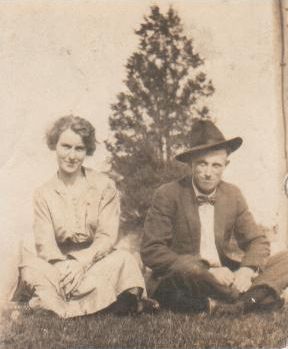 Leo Worth Hissem, 28, the son of Arthur Walker Hissem and Tillie Elizabeth Haney, married Lena May Six, 25, the daughter of George Washington Six and Lucy Orr, on 28 July 1920 in Lee county, Iowa. See the Six Family page for more information about her family. She was born on 2 November 1894 in Illinois. Lena and Leo Hissem are at the left. Leo was a wounded man, never to be whole. How do we explain the attachment that led Lena to marry this man? Were they an 'item' before Leo enlisted?
Leo Worth Hissem, 28, the son of Arthur Walker Hissem and Tillie Elizabeth Haney, married Lena May Six, 25, the daughter of George Washington Six and Lucy Orr, on 28 July 1920 in Lee county, Iowa. See the Six Family page for more information about her family. She was born on 2 November 1894 in Illinois. Lena and Leo Hissem are at the left. Leo was a wounded man, never to be whole. How do we explain the attachment that led Lena to marry this man? Were they an 'item' before Leo enlisted?
When did Leo and Lena meet? In 1910 Leo was in Union township, Davis county / Lena was in Chequest township, Van Buren county. In 1915 he was in Douds Leando, Village township, Van Buren county / Lena was in Marion, Davis county. In 1920 he was in Village township, Van Buren county / she was in Union township, Davis county. So, many 'near' opportunities to meet.
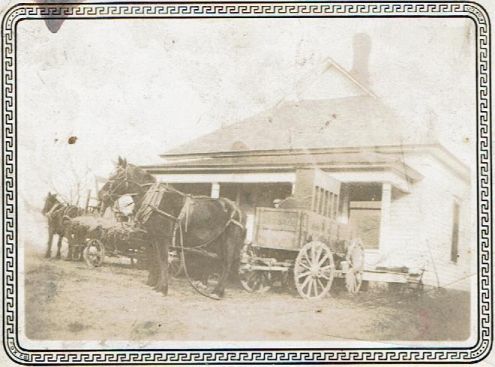
| Historical Timeline: The 1920's
An era of prosperity and rapid social change. Prohibition, the last gasp of the Progessive movement, led to the illegal manufacture and distribution of alcohol, a huge boon to organized crime. Movies and radio, both wildly popular, spread new ideas and eroded traditional social values. - 1927 Charles Lindbergh became the first man to fly solo across the Atlantic Ocean and achieved international fame. - 1929 After reaching an all time high in September, the stock market crashed creating a worldwide economic crisis. |
On 20 January 1923 Leo made an application for his Iowa state bonus for war service (Sec. 6, Ch. 332. Laws of the 39th G.A.). He noted an enlistment date of 20 September 1917 and an Honorable Discharge on 30 May 1919. The discharge occurred at Camp Dodge, Iowa. The bonus was approved on 31 May 1923, voucher #897 of 2 Jun3 1923. The amount of the bonus, $309, was based on his length of service (enlistment to discharge), 618 days, at 50 cents a day. At the bottom of this document Leo states that he reported for active duty to Camp Dodge, Iowa with the 336th F.A. [Field Artillery]. However, as discussed above, his first assignment was actually with the 339th F.A. After nine years and a world war I guess Leo forgot.
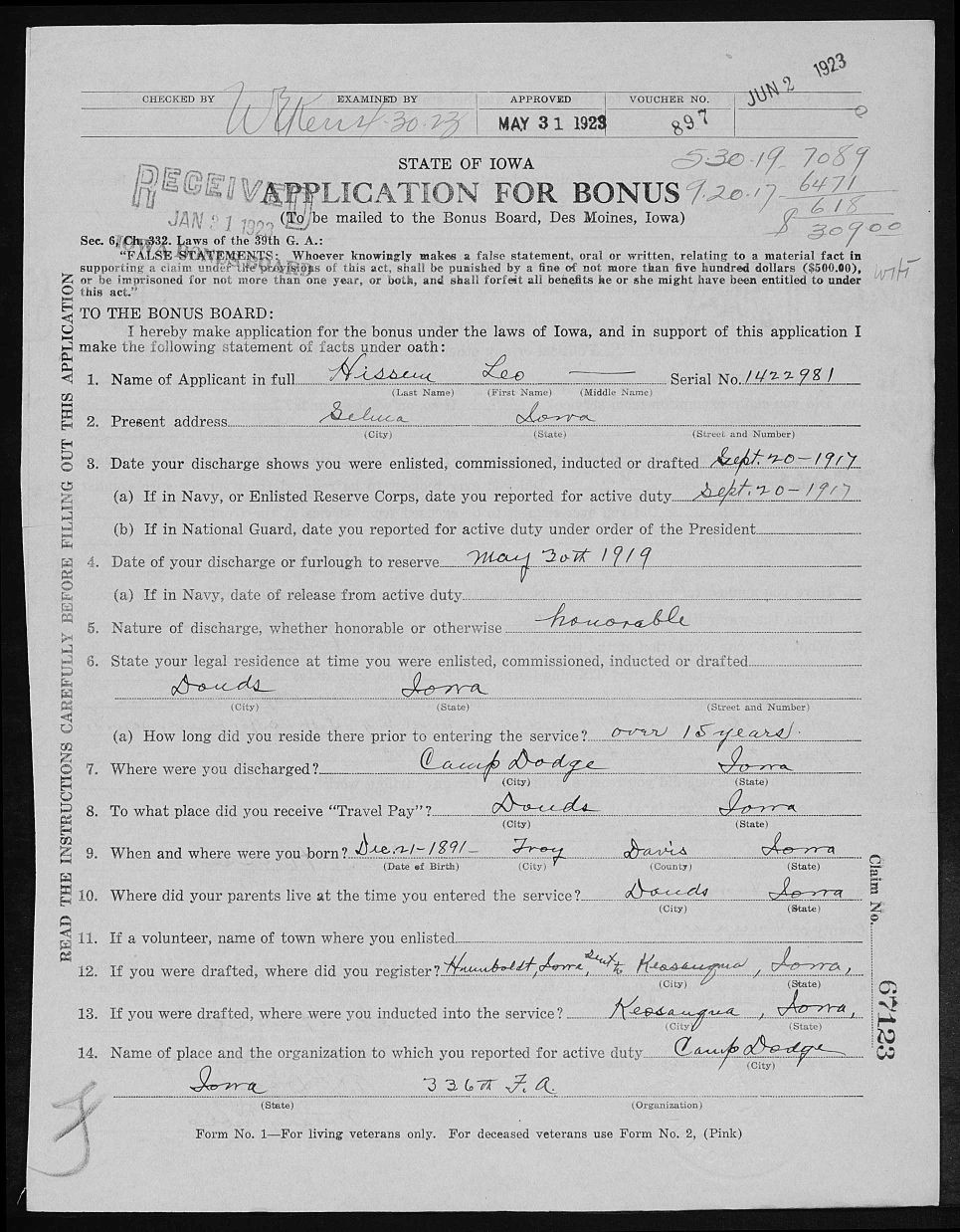
In the 1925 state census of Chequest township as Leo W. Hissem, 33. Living with him were his wife, Lena M., 30, and children, Alice P., 2, Gerall G., 1, and Derall D., 1. both Leo and Lena had 8 years of schooling. There seems to have been a lot of confusion with the spelling of the twin's names.
In the 1930 census of Milton, Jackson township, Van Buren county, Iowa as Leo W. Hissem, a 38 year old with no occupation. According to my father Leo was too ill to farm so instead he rented the two 160-acre farms he had inherited, including to his in-laws. He apparently invested wisely because the family weathered the Depression with no more than expected problems. Living with him were his wife, Lena M., 35, and children, Alice P., 8, Gerald [sic] G., 5, Derall [sic] D., 5, and Herbert R. [sic], 6/12. Leo also had a seven-acre plot in town and a family residence of another two-acres, also in town. The census indicated that he owned his own farm, worth $700 [I assume this was just the in-town farm he resided on], and he had a radio.

Leo and Lena's baby son was injured in 1931. I assume this was Lozelle, who would have been about a year and a half old.
"Separator Mangles Child's Fingers Left Hand Is Caugbt In Gear of Machine and Two Fingers of Boy Are Injured
Milton Herald
The little baby son of Mr. and Mrs. Leo Hissem met with a very painful accident Tuesday aftenoon while playing around a cream separator. He caught his left hand in the gearing in some manner and two of his fingers were badly mangled. He was brought to Doctor Stephenson's office where he was given an anaesthetic and the wounds repaired." - from the Pella [Iowa] Chronicle of 11 June 1931
Leo and the family hosted the 50th wedding anniversary party for Lena's parents on 20 June 1931.
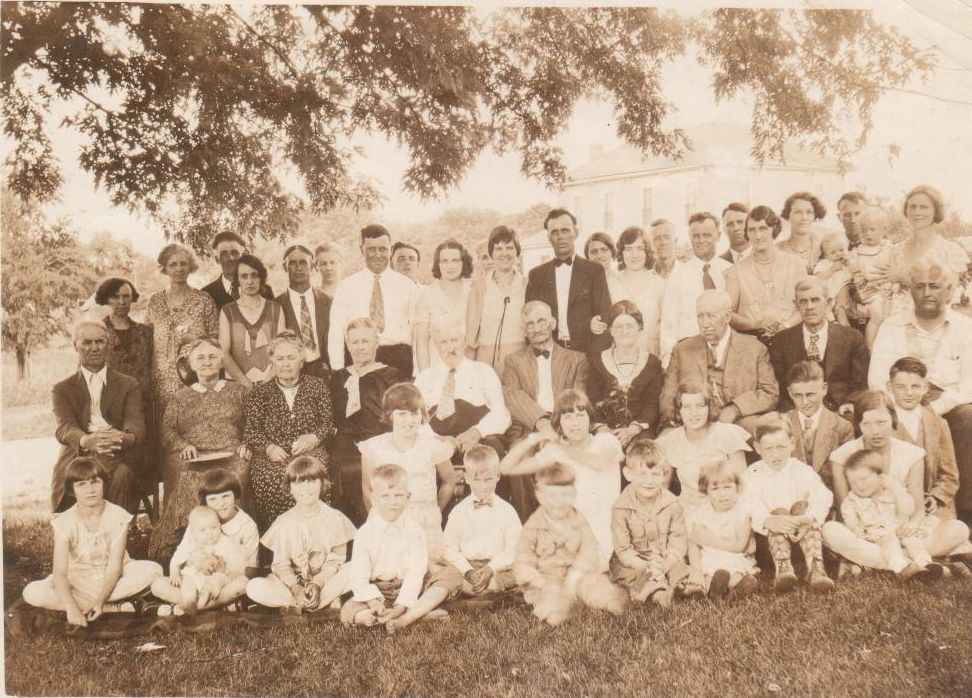
In 1934 the Iowa General Assembley passed a law creating an Old Age Assistance Commission to oversee the care of the State's needy aged; assistance was to be provided to indigent applicants over the age of 65. A tax of $1 a head, the first year, and $2 a head annually thereafter was collected from all persons over the age of 21 to fund this aid. The names of those to be taxed included:
Taxpayer: Hissem, Leo W. Birthplace: Iowa. Birthdate: 1891 Dec 21. Father: Hissem, A W. Mother: Haney, Tillie. Residence: Cheq
Taxpayer: Hissem, Lena May. Birthplace: Illinois. Birthdate: 1894 Nov 2. Father: Six, Geo. Mother: Ore, Lucy. Residence: Cheq
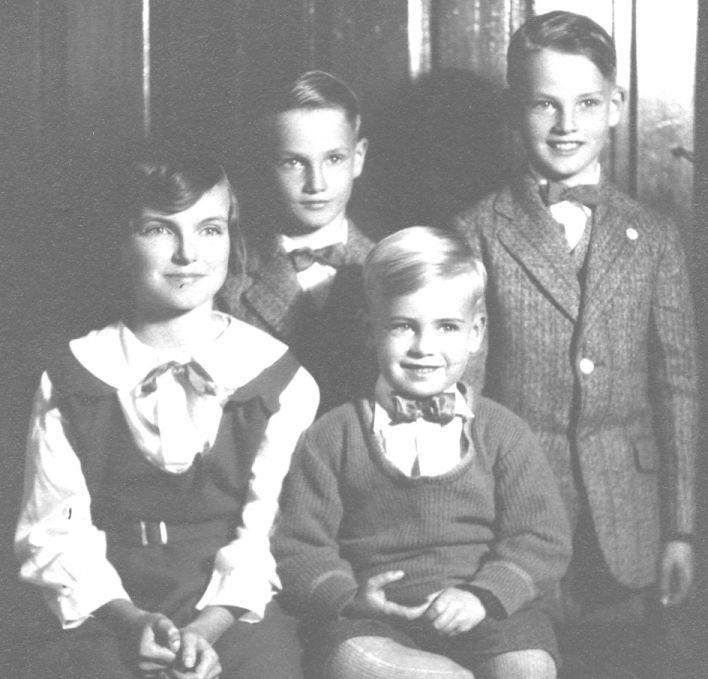
In the 1940 census of Milton, Jackson township, Van Buren county, Iowa as Leo Hissem, 48, with no occupation and listed with code U, "unable to work." Living with him were his wife, Lena, 45, and children, Gerald [sic], 15, Darell, 15, and Lozelle, 10. Alice [as Alice Hissera in familysearch.org] was living in Des Moines. Leo owned his own house, which was worth $1000; he did not live on a farm. Leo and Lena had completed 8 years of schooling. Garell and Darrell were in their second year of high school; Lozelle was in the 5th grade. Interestingly, Lozelle Hissem was also shown living with his grandmother, Lucy Six, also in Milton.

Leo Worth Hissem, aged 50, of Milton, Iowa registered for the draft again on 27 April 1942 in Milton. He was unemployed. His wife was Lena May Hissem. Leo was 5' 6" tall and weighed 136 pounds. He had a scar on his chest, perhaps from his war wounds.
Leo died on 26 November 1945 and was buried in the Sunnyside Cemetery in Milton, Iowa.
"Services Pending For Leo HissemI remember my grandmother telling me that Leo had no gravestone because she could not afford to erect one. She mentioned this upon seeing a monument to a horse, which set her off. See more about Leo in the section about my father, below. Apparently someone erectred a monument in the Sunnyside cemetery, in Milton, Iowa, at a later date.
Await Word Of Arrival Of Son Enroute Home From Pacific; Wife, Four Children Survive. **Handwritten: Nov. 26 - 1945Leo Hissem, 53, died at 3 a.m. Monday at his home in Milton following a lingering illness. a veteran of world war one, he had been in failing health for many years.
Surviving are his wife, Lena; a daughter, Mrs. Alice Rogers of Des Moines, and three sons, Lozelle at home and twins, Darrell with the air corps in Berlin, and Garrell en route home from Los Negros island, where he was with the 503rd parachute infantry.
The body was taken to the Brown funeral home in Milton to await definite funeral arrangements. These arrangements are pending the arrival of his son Garrell, who they hope will arrive in time for the funeral." - from Van Buren Co. Genealogical Society Obituary Book C, Page 334, Keosauqua Public Library, Keosauqua, IA
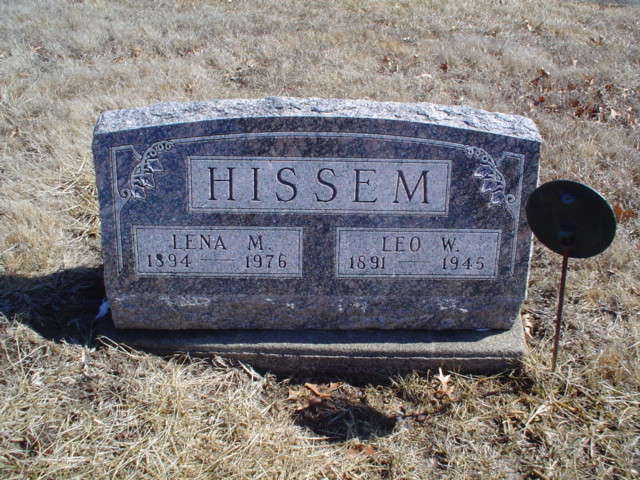
In 1949, 1953-54 Lena M. Hissem was living at 2800 Eastern avenue, Davenport, Iowa, a matron at the Annie Wittenwmyer Home. See below for more abou this orphanage. In 1956 she was referred to as a housemother.
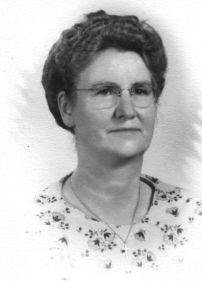
Lena died on 28 April 1976, at the age of 81. She was buried in the Sunnyside Cemetery, next to Leo. Leo and Lena had the following children,
(26) Alice Pearl Hissem (1922)
(26) Garrell Gene Hissem (1924)
(26) Darrell Dean Hissem (1924)
(26) Herbert Lozelle Hissem (1929)
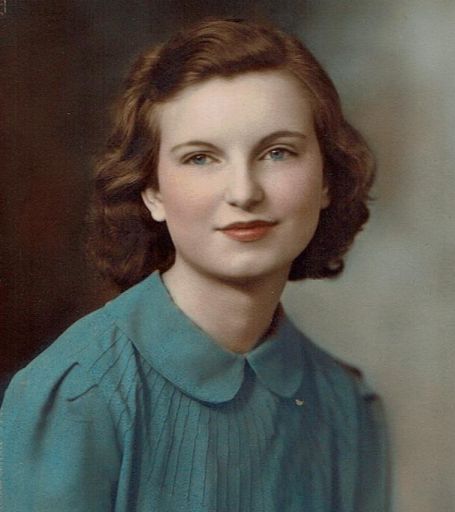 (15) Raphe Hesome (c1550)
(16) William Hesome (c1577)
(17) George Hesom (c1600)
(18) John Heesom (1650)
(19) Unknown Heesom (c1687)
(20) Thomas Hesom/Hissom/Heysham (c1720)
(21) David Heysham/Hissam (1762)
(22) Jesse Hissam (1795)
(23) Abner Hissam (1830)
(24) Arthur W. Hissem (1866)
(25) Leo Worth Hissem (1891)
(15) Raphe Hesome (c1550)
(16) William Hesome (c1577)
(17) George Hesom (c1600)
(18) John Heesom (1650)
(19) Unknown Heesom (c1687)
(20) Thomas Hesom/Hissom/Heysham (c1720)
(21) David Heysham/Hissam (1762)
(22) Jesse Hissam (1795)
(23) Abner Hissam (1830)
(24) Arthur W. Hissem (1866)
(25) Leo Worth Hissem (1891)
Alice Pearl Hissem, the daughter of Leo W. Hissem and Lena Maye Six, was born on 20 April 1922 in Van Buren county, Iowa. In the 1925 state census for Birmingham-Henry, Van Buren county, Iowa as Alice P. Hissem, 2. In the 1930 census of Milton, Van Buren county, Iowa as Alice P. Hissem, 8.
My Father indicated that Alice did not live in her parents house, but rather with her grandparents. I assume these were the Sixes since Tille Haney Hissem had died by 1927. I guess the house was too small for all the children. She apparently spent a lot of time at her parents house, but slept apart.
Alice Hissem graduated from Milton High School in 1939. The photograph is of Alice, circa 1939.
In the 1940 census of Ward 4, Des Moines, Polk county, Iowa as Alice Hissem [Hissera in familysearch.org], 17. No occupation is shown. She was living at the Iowa National Esther Hall, an all woman institution. Mrs. J. M. Williams was the Head.
| Esther Hall
This building was constructed in 1922 to house those programs, which trained Methodist women as social workers, missionaries, and deaconesses. It contained dormitories, lecture, science and recreation rooms, and a chapel. Its function expanded in 1925 as a residence for young career women. The Bible training program was phased out during the Great Depression. - from Wikipedia. |
In the early 1940's she was a stenographer at the Conneticutt Mutual Life Insurance Company. She was residing at 921 Pleasant street, in Des Moines, Iowa (Esther Hall).
Alice married Carrol Lester Rogers in 1942. He was born on 23 June 1923. They resided in Urbandale, Iowa. They had five children.
(27) Marlena Kay Rogers Murphy (1947), she was born on 9 April 1947, she married a Murphy, second she married Richard R. Heitman, she lived in San Diego at one time, but now may live in Enumclaw, WashingtonAlice died on 10 April 1999 in Des Moines, Polk county, Iowa. Uncle Carrol died on 1 July 2017. His obituary,
(27) Carla Marie Rogers (c1949)
(27) Shawn Carrol Rogers (1951), born 14 June 1951, currently living in Des Moines, Iowa
(27) Leora Janine Rogers Russell-Sourwine (1957), she was born on 28 December 1957, she is a breakfast server and computer operator at an elementary school in Urbandale, Iowa
(27) Zena Alice Rogers Mitchell (c1961), "Zena Rogers Mitchell, 47, daughter of Carrol and the late Alice . . . Urbandale died October 28, 2008" in St. Charles, Missouri
"Carrol Lester Rogers of Urbandale, Iowa passed away on July 1, 2017 after a three year battle with G.I.S.T. cancer. Per Carrol's wished his body has been donated to the University of Iowa in Iowa City. No services are planned.
Carrol was born in Runnells, Iowa the son of Lester Clyde and Mary Edith (Mix) Rogers. They resided in Hartford, Iowa.
Carrol married Alice Hissem in 1942 and moved to Des Moines to work at Meredith Publishing, where he retired after 43 and a half years. He moved his family to Urbandale in 1952 where he and Alice raised five children.
Left to remember him are his children, Marlena (Dick Heitman) Murphy, Carla Rogers, Shawn Rogers and LeOra Russell-Sourwine; brother, Don Rogers; sister, Helene Hillisted; second cousin, Gwendolyn Mix; his best bud, Buzzard and many friends and family. He was preceded in death by his parents; his wife, Alice; and daughter, Zena Mitchell.
| Historical Timeline: The 1930's
The Great Depression dominated the domestic political arena while world-wide economic problems and unresolved issues of World War I resulted in the rise of dictatorships in Germany, Italy and Japan. - 1930 In an attempt to protect American industries in the face of a developing depression, the Smoot-Hawley Tariff Act brought the U.S. tariff to its highest level in history. Retaliatory tariff acts from foreign countries caused U.S. foreign trade to suffer a sharp decline, worsened the economic downturn and caused a world-wide economic recession.- 1939 Germany attacked Poland starting World War II. |
| Historical Timeline: The 1940's
World War II fought and won. America rose to the status of a super-power as she led the Allies to the defeat of the dictatorships. The Nuclear Age begins. - 1941 Japan attacked Pearl Harbor and America entered World War II on the side of the Allies.- 1945 America dropped nuclear bombs on Hiroshima and Nagasaki, Japan. Japan surrendered ending World War II. - Tensions with Soviet Russia and her occupation of Eastern Europe result in the Cold War, a global competition that stopped short of major conflict, but which played out in wars and revolutions in proxy states. - June 1950 North Korea attacked the south starting the Korean War. |
My Uncle, my Father's twin, was born on 7 December 1924. While this may have no relevance what so ever, note that the Gorrell family, near neighbors of the Hissam's in West Virginia, pronounced their name as "Garrell." Was this the origin of Garrell's name? My father, unfortunately, can't remember the story of his brother's naming, though he's sure he was told.
| Gorrell Family in Van Buren County
I have always wondered if Uncle Garrell had been named after some local man admired by his parents; a minister, a doctor, or politician are likely, or . . . a childhood friend or sweetheart? The Reverend Isaac Harper Gorrell, the son of Ralph Gorrell and Abiah Smith Andrews, of Burlington, Iowa, was born in January 1854 in Elvaston, Hancock county, Illinois. In the 1880 census of McDonough county, Illinois as Harper I. Gorrell, 25. McDonough is the next county east of Pike county, Illinois, where Lena May Six Hissem's father, George, was born and lived from 1861 to at least 1880. Isaac married Nancy Olive Horton on 6 January 1886 in Lockridge, Jefferson county, Iowa. The Sixes also lived in Jefferson county circa 1900. The Reverend Gorrell practiced in Chequest township at the Bethel church, southwest of Leando, in section 16 of Chequest township. See the plat map above, under Abner Hissem. "Rev. Gorrell and family moved last week into a house of Abner Hissen's, lately purchased of Mr. Murray."So perhaps Gorrell was a friend of the Hissems vice the Sixes. In the 1900 census of Chequest township, Van Buren county, Iowa as Isaac H., a 46 year old minister, and Nancy O. Gorrell. Their chidren were Edward J., 13, Bertha A., 11, and Roy A., 5. In 1901 he was in the Ottumwa, Iowa city directory. In 1905 he was listed in the state census for Jefferson county, Iowa. In the 1910 census of Fairfield township, Jefferson county, Iowa as Isaac N. [sic] and N. Olive Gorrell. Jefferson county is just north of Van Buren county. The Sixes had lived in Jefferson county in 1900, and in Van Buren county in 1910.
However, sometime between 1912 and 1920 he moved to Wisconsin. His children were,
|
In the 1925 state census for Birmingham-Henry, Van Buren county, Iowa as Gerald G. Hissem, 1.
In the 1930 census of Milton, Jackson township, Van Buren county, Iowa as Gerald [sic] G. Hissem, 5. In the 1940 census of Milton, Jackson township, Van Buren county, Iowa as Garell Hissem, 15, in the second year of high school.
Garrell joined the Army about the time of his 18th birthday in December 1942. This is an estimate based on my father's joining in April 1943, which he termed as four to six months after his brother joined. They both entered the Army, but Uncle Garrell, the more adventuresome of the two according to my father, opted to become a parachute combat infantryman in the Airborne.

Garrell served during WW II as a paratrooper in the Pacific. After Basic Training, when he volunteered for Airborne, he would have been assigned to Fort Benning, Georgia, where the Army's Jump school is located. At left are jump towers at Fort Benning in 1944. He eventually became a member of Company C, 1st Battalion, 503rd Parachute Infantry Regiment of the 503rd Parachute Regimental Combat Team. The 503rd PRCT also included 462nd Parachute Field Artillery Battalion and 161st Parachute Engineer Company. See The 503rd P.R.C.T. Heritage Battalion Online, History of the 503rd Parachute Infantry Regiment, and Chronology of the 503rd for more about the unit.
The Regiment was transferred to Fort Bragg, North Carolina in March 1942. On 20 October 1942 the Regiment left POE San Francisco on the MS POELAU LAUT. The first stop was the Panama Canal Zone to pick up the 501st Parachute Battalion. The Regiment landed in Cairns, Australia on 2 December 1942 after a voyage of 43 days and 42 nights. See Certified Survivors of the POELAU LAUT for a description of the ship and the voyage. During more than three years service in the Southwest Pacific theater, the 503rd served in five major combat operations.
Garrell joined the PRCT no later than when they arrived in Australia because he fought in New Guinea, their first jump. On 5 September 1943 the unit jumped into the Markham Valley, New Guinea in the first successful Airborne Combat jump. The Regiment forced the Japanese, who had to evacuate a major base at Lae, to take a route which proved to be disastrous for them. The third Battalion of the 503rd had a major skirmish with the rear guard of this exodus. The successful employment of Parachute troops in the Markham Valley has been credited with saving the concept of vertical envelopment from being abandoned following several less than successful engagements in Europe [I remember my Dad telling me about Uncle Garrell's time in New Guinea].
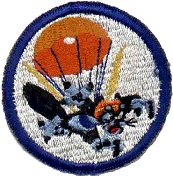 Shortly after their assault on the Markham Valley the 503d adopted the "descending wildcat" to become their official insignia. The 503d proudly wore their "wildcat" during the next two years. The "Wildcat Patch", right, which was soon nicknamed the "Cat Patch", had been dreamed up by the Walt Disney Studios some time shortly after 7 Dec 1941, and several paratroop units adopted similar Disney based patches. The backgrounds remained the same, and the number of the unit was added, so the design was hardly unique to the 503d.
Shortly after their assault on the Markham Valley the 503d adopted the "descending wildcat" to become their official insignia. The 503d proudly wore their "wildcat" during the next two years. The "Wildcat Patch", right, which was soon nicknamed the "Cat Patch", had been dreamed up by the Walt Disney Studios some time shortly after 7 Dec 1941, and several paratroop units adopted similar Disney based patches. The backgrounds remained the same, and the number of the unit was added, so the design was hardly unique to the 503d.
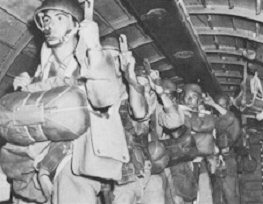 It was only after the unit's successful liberation of Corregidor that the symbolic "Rock Patch", created by one of the unit's own men, was adopted for wear on the sleeve as a unit patch, below.
It was only after the unit's successful liberation of Corregidor that the symbolic "Rock Patch", created by one of the unit's own men, was adopted for wear on the sleeve as a unit patch, below.
The 503rd's penultimate mission was the combat jump on Corregidor on 16 February 1945 to liberate the island from occupying Japanese forces. Left, the 503rd prepares to jump into Corregidor; the night before they had watched movies of the loss of Corregidor and the Philippines to the Japanese . . . to get their blood up, I guess. This was the premier combat jump of the Pacific War and was the most vicious combat action in which the combat team was engaged. There were an estimated 6550 Japanese on the island when the 503rd landed. Of those, only 50 survived. The 503rd lost 169 men killed and many more wounded. The drop on Corregidor was done at 700 feet with just enough time for the chute to open and slow the men's fall before they hit the ground, see above. They carried a huge amount of gear and had to be in excellent physical condition. See the book "Rock Force" for a dramatic retelling of this story.
Below are shots of the jump and subsequent action.
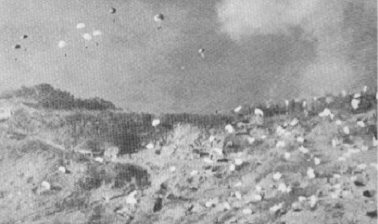
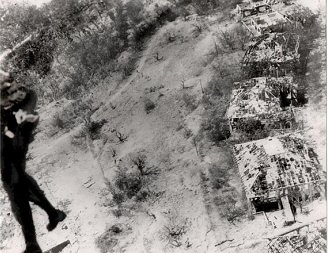
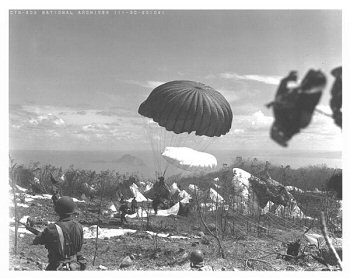
This airborne assault took the Japanese by surprise; they had expected an amphibious assault and so had concentrated their forces on the beach. The paratroopers quickly took the 'high ground' and methodically began to expand their perimeter, forcing the Japanese defenders underground, into the large tunnel complex.
First Battalion was assigned to go in on the third wave of the air assault, but by that time an amphibious landing at the South Dock (San Jose Point) had already been made by the 34th Infantry. With a safe beachhead secured it was decided to send Garrell's unit in via LCI (Landing Craft Infantry); a whole lot safer route.
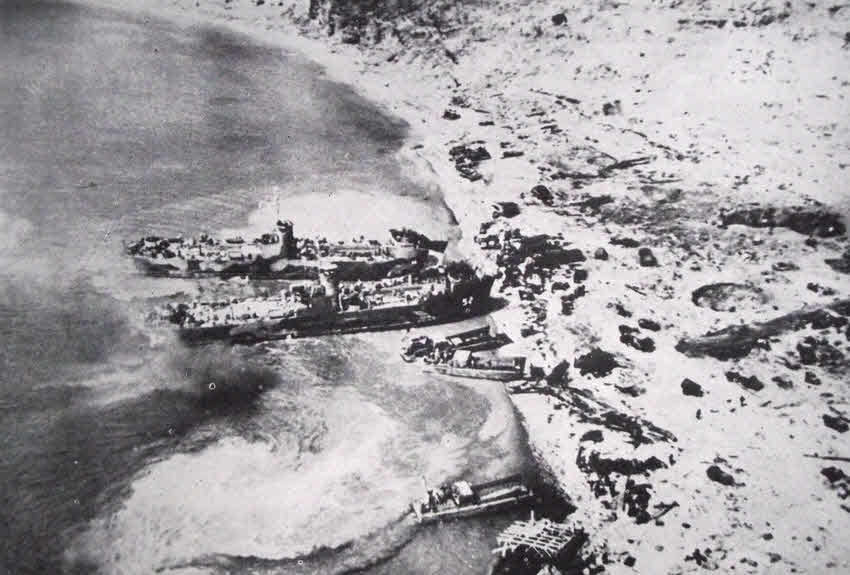
The paratroopers of Company C 1st Battalion, once secure on the beach at San Jose Point, moved west, along the South Shore road, to Searchlight Point [see map below as Search Pt.] where they met stiff resistance. The Company C 1st Battalion commander called in Naval gun fire in support. The next day the Battalion were ordered to move east to contain surviving Japanese holding out in the Malinta Tunnel complex. They then continued down the 'Tail' clearing Japanese positions. On the 25th 1st Battalion, with Company C, took Water Tank Hill with fixed bayonets [the Hill was in the center of the Tail, west of Monkey Point]. The worst incident to hit the 1st Battalion occurred at the old Naval Intercept Tunnel at Monkey Point. A huge blast, set off either by the Japanese inside the tunnel or due to an American round igniting munitions in the tunnel, was a disaster, killing 52 paratroopers and wounding 197.

Colonel George M. Jones was the 503rd, "Rock Force," commander.
16 February: "Initial landing is against light opposition due to surprise. Third Bn get the first drop honors."First Battalion was commanded by Major Robert H. Woods.
02 March: Mission declared closed, patrolling and small actions continue against isolated, remnant units. - from Unit Periodic Reports
22 February: "1st Bn - Defending Btry Wheeler and south of it at Topside cliff edge . . . 1st Bn getting ready to move in the morning to San Jose beach to be ready for assault on East part of Island."Company C was commanded by Captain John P. Rucker.
"Nearly 300 feet below Battery Wheeler's end station at Wheeler Point a 155 battery position, Battery Monja, had been tunneled in the face of the cliff. The 2d Battalion commander, Lawson Caskey, ordered E Company to patrol north from Searchlight Point to Wheeler Point, a straight-line distance of some 600 yards. The patrol would start out in the morning of February 23d. The 1st Battalion had been in this area for several days meeting considerable resistance believed to be centered at Wheeler point and Battery Monja.23 February: "1st Bn - To assemble at Bottomside to prepare for push East of Malinta Hill."
On 21 February the cliffs in the Wheeler Point area between Topside's high ground and some 500 feet below it on the rocky shore, had been reported cleared of all "but a few stragglers" after "a combined naval and ground strike [see Captain Rucker, 22 February, below]. The journal was incorrect since in fact C Company, 1st Battalion, "unable to move due to heavy fire coming from the cliff face north of them, had never advanced beyond Searchlight Point." . . . E Company [2nd Battalion] relieved C Company [1st Battalion] in the morning of February 23d at their positions above Searchlight Point." - from Attack on Battery Monja
24 February: "1st Bn - Spearhead of the drive around Malinta Hill towards Tailside . . . In an unfortunate incident, mortar fire falls on 1st Bn CP, killing Maj. Woods and wounding several others."
25 February: "1st Bn - Just before sunrise, a .50 cal MG gun crew from Battery D ambushed 14 enemy infiltrators."
26 February: "1st Bn - 1st Bn to advance to Kindley Field. The drive to the East was met by a serious suicidal attempt in the vicinity of Monkey Point by the enemy exploding a huge underground arsenal . . . Reports that tank fired into one of the cave pill boxes and a big explosion followed by three or four smaller ones tore up high ground around Monkey Pt and occupied by our troops assaulting position. Blast apart Sherman tank and big rocks filled sky which in falling caused many deaths & injuries. Med aid rushed from Mariveles by cub. The total casualties are 156." - from Unit Periodic Reports
22 February: "On the south side of Topside, Capt John P. Rucker, "C" Co, risked his life for two hours to direct naval fire on enemy positions while exposing himself to both friendly and enemy fire in order to neutralize enemy fire . . . Under John Rucker, attacking West along South Shore Road, stopped by persistent Japanese force at Searchlight Pt."Garrell's [Squad?] Staff Sergeants were Bryan Ownby and Richard Kehneman and his Pfcs wer Arthur Dines, Henry McDowell, Dominick Massaro, and Gerald McMillan. This is how the roster looks, but its not clear this tells the true story.
25 February: "C Co - Attack Water Tank Hill after a preliminary softening up by mortars, artillery fire and naval fire" - from Unit Periodic Reports
On the unit's return to Mindoro from Corregidor a series of photographs was taken of the surviving members of the 503rd PRCT. They were photographed in their State of Origin groupings. The photo of "503rd Regimental Combat Team Names of Personnel Participating in the Corregidor Operation," Harold Templeman's "The Return To Corregidor," below, shows 503rd members from Iowa.
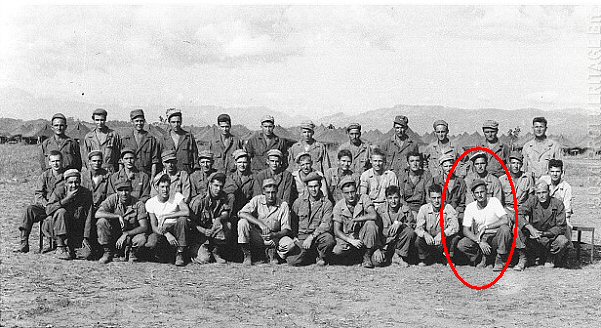
Garrell was listed as "Cpl. Hissem, Garrell" [promoted after the picture above was taken?] in Company C, 1st Battalion.
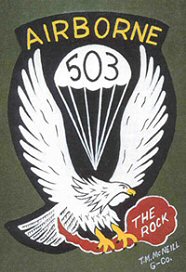
Almost immediately after returning to Mindoro from Corregidor, the Combat Team was called upon to bolster the 40th Division which was bogged down on the Island of Negros, in the Central Philippines. The Combat Team was inserted into Negros by landing craft, although it had been alerted for another combat jump. The 503rd engaged in fierce battles against frantic Japanese resistance in the mountainous areas of Negros for more than five months. The 40th US Division convinced higher headquarters there were only a few enemy troops remaining on the Island and were moved to Mindanao, leaving the 503rd to battle the Japanese alone. At the end of the War with Japan on 15 August 1945, about 7,500 surviving Japanese troops surrendered to the 503rd Parachute Regimental Combat Team.
In November 1945 Garrell was recalled to the States by the impending death of his father. By early November 1945 the 503rd Parachute Regimental Combat Team ceased to be operational. All men with lengthy service in the Southwest Pacific had been rotated to the United States while those who had served the Combat Team for a shorter time had been reassigned to the 11th Airborne Division and sent as occupation troops to Japan. The Regiment was inactivated on 24 December 1945 at Camp Anza, California.
Garrell's combined pay and leave from his extended combat duty allowed him to take six months off duty at home. He had a girlfriend who he had written to throughout the war and, perhaps, thought to marry on his return. When he got home, however he found she had planned out his life for him, a life that did not include the military that he had learned to love. There was a falling out and when he met Margie Smith of Rock Island, he married her. His brother, my father, served as his best man.
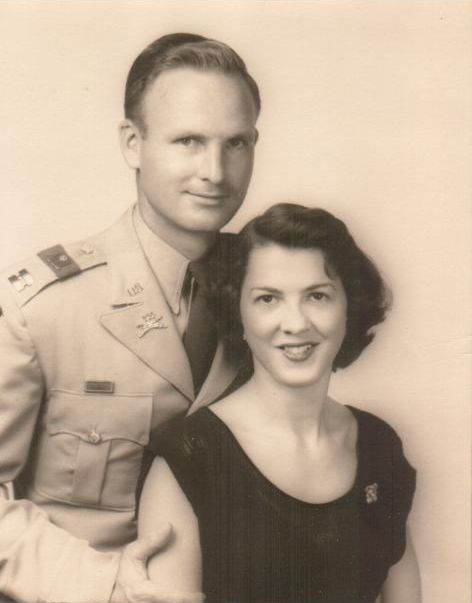
Garrell G. Hissem re-enlisted in the Army as an Infantry Staff Sergeant on 15 January 1946 at Fort Snelling, Minnesota. He had always enjoyed the service life and was good at it. My Dad remembers that soon after marrying he was sent to Fort Snelling, Minnesota. Was this a return trip or the actual time of his re-enlistment? I think he also went there for processing and to pick up further orders. His enlistment was, or had been, for the Hawaiian Department, an upper-echelon administrative unit of the Army. He had three years of High School and was classifed a machine operator, the same as my Dad.
| Fort Snelling
The Fort was also used as a supply base for the Dakota Territory and a training center for soldiers assigned to the Indian Campaigns, the Spanish American War, and World Wars I and II. It was closed in 1946 (I have records showing it was still processing servicemen on 1 July 1946). See the Heysham-Gibbon page for the story of a relative, Colonel John Gibbon, who commanded the fort in the late 19th century. |
After Fort Snelling, and probably because of his excellent combat record, Garrell was assigned as a jump instructor at the Fort Benning Parachute school. The U.S. Army Parachute School has been known by a variety of names over the years. In 1946 it was the Airborne School. By the end of the year it was the Airborne Army Aviation Section, of the Infantry School. Garrell's superiors at the jump school pushed him to seek a commision and he eventually did. He attended officer training at Fort Riley in Kansas, probably in one of the last classes in 1947, and was commissioned a Second Lieutenant.
| Army Officer Candidate School
OCS is a 14-week program which graduates commissioned officers in the United States Army. Army OCS was established in 1941 to provide Infantry officers for World War II. After World War II, Infantry OCS was transferred to Fort Riley, Kansas, as part of the Ground General School. Due to the post-war downsizing of the Army and the declining need for new Officers, all but Infantry OCS was closed. Finally, on 1 November 1947, it was deactivated. The final class graduated only 52 second lieutenants. Through all of the years OCS has remained an important commissioning source for the Army. Officer Candidate School (OCS) is currently located at Fort Benning, Georgia and is the Army's only active duty Officer Candidate School, commissioning over 800 lieutenants annually. |
In 1947 Garrell's daughter Linda was born.
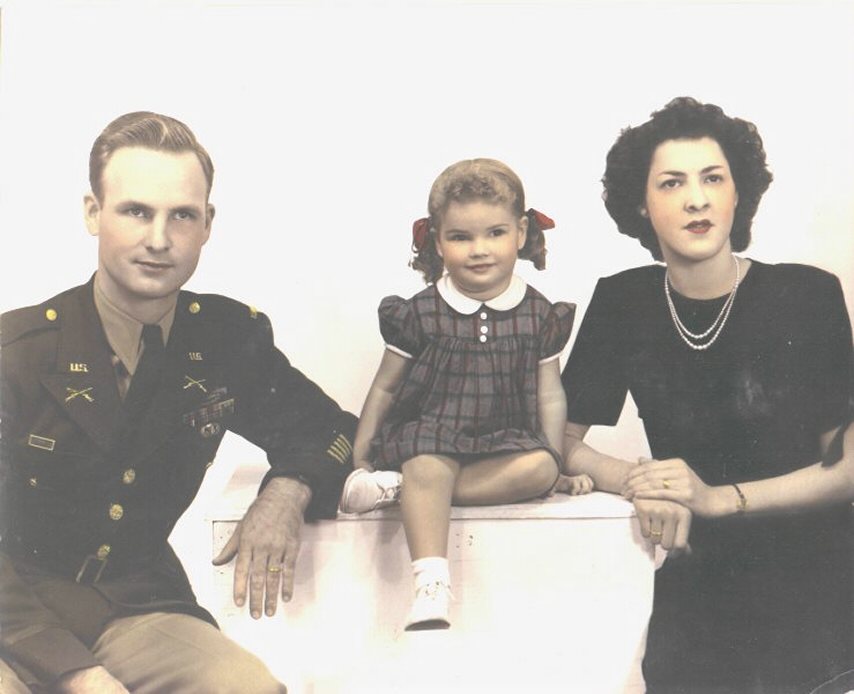
Garrell's first assignment after OCS was to Trieste, Italy where he served in the 351st Regiment of the 88th Infantry Division. This was in the early 1950s, a period when Trieste was one of the "hot spots" on the globe and it drew many "hot" officers who wanted to make their mark. The 351st was considered at this time to be an "elite" unit by the U.S. Military Academy. I should also point out that this was probably less onerous duty than war in Korea, the other hot spot.
| The Free Territory of Trieste
Trieste, in northeastern "armpit" of Italy, had been a part of Italy since the First World War, and before that of the Austro-Hungarian Empire.
The first years of the occupation were stormy. While the predominant Italian population of Trieste was generally friendly, a determined minority of pro-Yugoslav Communists tried to stir up trouble with the aim of annexing Trieste to Yugoslavia. In September 1946, seven U.S. MPs were injured in the the explosion of a hand grenade thrown during a Communist demonstration. A year later, after the signing of an Italian peace treaty, the borders of the Free Territory of Triest were adjusted and the Yugoslavs seized on this opportuiny to provoke other incidents. Coolness and firmness on the part of everyone from the Allied Military Governor to the non-commissioned officers at the outposts prevented the mutual hostility from flaring up into open hostility. At one outpost, manned by five enlisted men and one lieutenant, a Yugoslav colonel demanded the right to march 2,000 men through the U.S.-British zone. The colonel threatened to use force, but the American officer talked to him patiently, delaying him until higher authority could be brought to bear on the fiery Yugoslav, who finally withdrew. A smart junior officer who knew his job had prevented what easily might have become a very unpleasant and perhaps world-shaking incident. The intent was to create a free city, belonging to neither Italy nor Yugoslavia. In 1949 the populace, largely Slovene, had voted against reunifying with Italians they saw as oppressors. In 1954 Italy, however, invaded and seized Trieste. |
I believe Uncle Garrell was in Armor, or tanks, as his final assignment, below, attests. Below are pictures of "tankers" of the Trieste United States Troops. I don't know that any of the pictures are of him, though the top left shot looks very like him. If nothing else, it gives a flavor of the men, their equipmenta and mission.
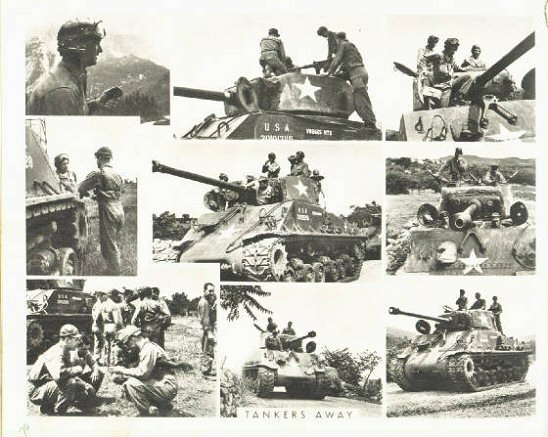
In a recent email, Charles Nobles wrote,
"I stumbled onto your genealogical website last night when I googled Garrell Hissem. I was a young recruit when I was assigned to Tank Company 351st Infantry Regiment in the Free Territory of Trieste. We were miles apart in rank as he was Executive Officer in the company while I was the newest of the new. You mentioned that you had no picture of him over there. Yes, you do. On that page of tankers (I have the same copy of the book), he is shown in the upper left. I put together a reunion association of the officers and men who served in Trieste during the years of the Free Territory (1947-54). We meet annually. Although our numbers are dwindling rapidly, we have formed a strong bond with the TRUST Tankers."In answer to my questions whether Garrell was in Armor at this time, Charles wrote,
"Yes, Garrell was a tanker, at least, he was wearing Armor Brass on his labels."He wrote again,
"I'm sending you a link to the second page of the "Old Soldiers Home". It is a website for the Yanks and the Brits who served in Trieste. On this pg 2, is a massive document that I transcribed from the magazines, newspapers, and Army documents from the end of WW II to the end of October 1954 concerning Trieste. It is in PDF format. I would recommend that you check out the index before you import any of the three sections to see if there is anything that particularly interests you. On page one of the Old Soldiers Home is a guest book that is used by former members of TRUST to communicate with one another on a daily basis. You may want to check the links. TRUST (Trieste United States Troops) was indeed the finest command in the Army at the time. I had just turned 18 when I arrived in Trieste and it was my home for over two and a half years. Crudely put, our mission was to keep the Italians and Yugoslavs apart while the politicians settled on the fate of the port city of Trieste. It was awarded to Italy at the end of WW I as a prize for joining the Allied side in that war. Tito wanted it and was willing to take it by force. The members of TRUST became my brothers and remain so to this day."The link is The Old Soliders' Home. Charles also sent me a "Roster of Tank Company, 351st Infantry" as of 17 June 1952 in which Garrell is shown to be the unit's Executive Officer, or XO:
McNeese, Frank J. Capt
Hissem, Garrell G. 1st Lt
Bell, John E. 1st Lt.
Blazins, Joseph J. 2d Lt.
My Dad had implied that Garrell didn't go into Armor until his last tour, at Fort Hood.
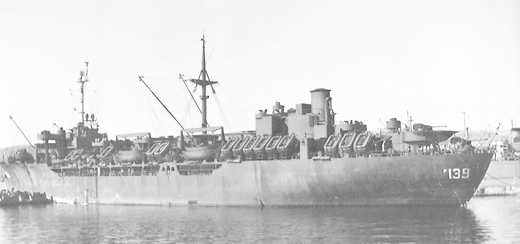
Garrell's wife, Marjorie, and his daughter, Linda, came home from Trieste in 1952 on a WWII troop transport.
"From Trieste, FTT, 17 October 1952, USNS GENERAL R. E. CALLAN (T-AP139) [photo above], arriving at port of New York, NY 1 November 1952 . . .
Hissem, Marjorie E., 27, Female, 546 22nd St., Rock Island, Illinois, Married, Iowa
Hissem, Cinda [sic] J., 5, Female, 546 22nd St., Rock Island, Illinois, Single, Georgia" - from the "New York Passenger Lists, 1820-1957"
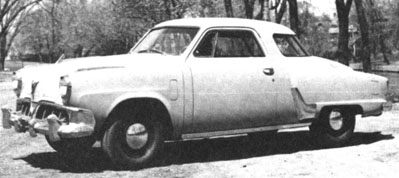 Dad says he knows Garrell had returned from Italy by 1952 because he remembers the Studebaker Garrell bought . . . it wasn't a very good car.
Dad says he knows Garrell had returned from Italy by 1952 because he remembers the Studebaker Garrell bought . . . it wasn't a very good car.
In 1953 Garrell was stationed at Fort Bragg, just west of Fayette, in Cumberland county, North Carolina. Oddly, it is the home of the Airborne, of which Garrell was no longer a member. His daughter, Susan, was born there in 1953.
He was assigned to duty in Korea, as an infantry officer according to Dad, probably from 1955 to 1956. It is impossible at this point to say which unit he was attached to. It was while in Korea that Garrell had the first indications of the illness that would kill him. The doctors there, however did not feel competent to treat or even fully diagnose the problem.
In 1956 "Hissem Garrell (Marjorie) USA" was residing at 449 23rd street, in Davenport, Iowa.
According to research by my cousin, Richard Six, Garrell sometime later graduated from the Command and General Staff College, Ft Leavenworth, Kansas.
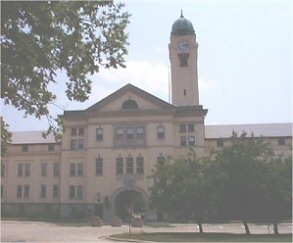 The Command and General Staff College (CGSC) The Command and General Staff College (CGSC)
This the Army's senior tactical school. It develops officers able to lead fighting units at the tactical and operational levels of war. Mid-career officers, majors and some promotable captains, attend the 10-month Command and General Staff Officer Course. The course educates selected officers in the values of the profession of arms, and in the conduct of military operations during peace, conflict, and war with emphasis at corps and division level. Students include Army active and reserve component officers, international officers, and officers from other branches of the U.S. Armed Forces. The college was established at Fort Leavenworth, Kansas in 1881. |
I assume that the Staff College tour came fairly late in this career, probably just before his last assignment. Garrell's final tour of duty was as a Captain, Headquarters Company, Second Medium Tank Battalion, of the Patton 37Th Armor (known as the Iron Dukes), Second Armored Division, at Fort Hood, Texas. General Patton created the Second Armored Division in the mold of the German Panzer divisions of Field Marshalls Guderian and Rommel. It is famous for its drive across France after the break-out from Normandy and its relief of Bastogne. The Battalion had been stationed in Germany, returning to the United States in early 1958. It remained at Fort Hood until 1963 when it returned to Germany, where it remains today.
| Historical Note:
Private Presley then transferred to Germany, serving there from October 1958 to March 1960 as a member of the 1st Medium Tank Battalion, 32d Armor. He was attached to the battalion's Headquarters Company in Friedberg. Below, Elvis in the uniform of the 2nd Armored Division during basic training; note the patch on his shouler. "All I want is to be treated as a regular GI. I want to do my duty and I'm mighty proud to be given the opporutnity to serve my country". ~ Elvis Presley "If I had to rate Elvis as a soldier, I'd rate him very high - the highest. He really knew the basics, and they say he'd done well in basic training at Fort Hood - caught on fast". ~ Ira Jones, Master Sergeant SGT Presley was Honorably discharged from active duty on 23 March 1960. |
Did Uncle Garrell know Elvis when they were together in the same Battalion? My guess is no. Garrell's illness had probably shown up by this time, distracting him from any other concern than for his family's future.
We visited Garrell's family at least once while they were stationed at Fort Hood. Dad was stationed at Bryan Air Force Base, Texas at this time so the drive wasn't long. I do remember the visit. The base was huge and it seemed we drove forever from the front gate until we got to their house. They lived in a white frame row house [base housing] that was situated on a rise above a parking lot below. I remember this because we played on the hill. There is a picture of my family in front with our 1956 Buick Special when we visited. Georgia and Linda, Garrell's eldest daughter, were, according to Dad, ga-ga over Elvis and could barely control their excitement at being so close to him. Dad and my Uncle were unimpressed.
Dad says he and Garrell went riding while there. Garrell was a good rider and possessed a full Patton-esque riding regalia. Again, according to Dad, Garrell looked every inch the rising officer.
Garrell Gene Hissem, the son of Leo W. Hissem, died in the US Army Hospital at Fort Hood, Bell county, Texas of colon cancer on 9 January 1959. He was buried at the National Cemetary on Rock Island, across from the city of Davenport where his mother lived. I believe he received what is known as a "deathbed" or "tombstone" promotion to Major.
"Hissem, Garrel Gene, b. 12/07/1924, d. 01/09/1959, CAPT HQ 2D MED TANK BN PATTON 37TH ARMOR 2D ARMORED DIV FT, Plot: F 1242, bur. 01/16/1959"His obituary,
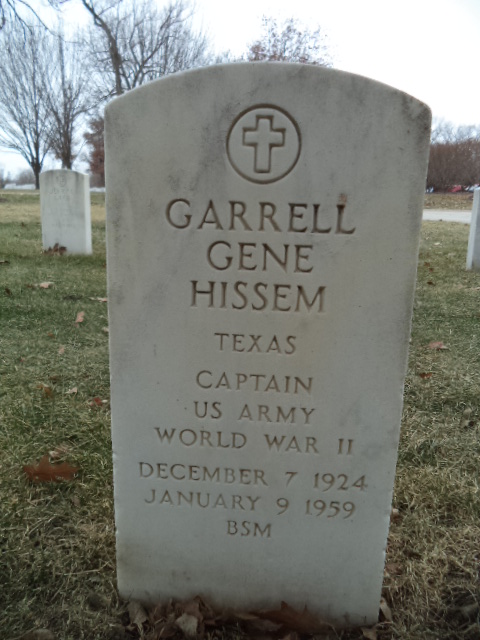
"Capt. Garrell Hissem
MILTON. - The funeral of Capt. Garrell G. Hissem, 34, will be held Friday at 2:30 p.m. at the Hodges and Son funeral home at Rock Island, Ill. Burial will be in the Rock Island arsenal cemetery.
Captain Hissem died Friday at the army hospital at Ft. Hood, Tex. He had been ill of cancer for a year and death resulted from gastro-intestinal hemorrhage.
A service was held Sunday at Killeen, Tex., where he had been making his home.
He was the son of Leo W. and Lena Hissem of Milton.
He is survived by his mother, now living in Davenport; his wife, the former Marjorie Smith of Rock Island, Ill., and two daughters, Linda, 11, and Susan, 5. His twin brother, Tech Sgt. Darrell D. Hissem, with the air force, lives in Leland, Miss. His sister, Alice Rogers, makes her home in Des Moines.
A younger brother, T/Sgt. Herbert Lozelle Hissem of the air force, died of cancer about a year ago. His father also preceded him in death." - from Van Buren Co. Genealogical Society Obituary Book D, Page 254, Keosauqua Public Library, Keosauqua, Iowa
| Rock Island, Illinois
After the War of 1812 a fort was built on the island to protect river traffic, but this was abondoned in 1836 after the Black Hawk war. With the outbreak of the Civil War, however, the Federal Government needed to replace the arsenal at Harper's Ferry, which had fallen to the Confederates. The western end of Rock Island became the location of one of three The cemetary was established in 1863, originally for the Arsenal. It is located on the extreme southeast end of the Arsenal. There are approximately 18,000 internments. The POW camp was established in 1863 on the north central shore of the island and housed over 12,000 Confederate soldiers during the war. All that remains are the graves of the soldiers and their guards who died there. |
The brothers looked quite a bit alike, but not identical, at least to my eye. I remember Uncle Garrell as a smooth and urbane version of my father. As an example, for a Christmas present he gave my father a smoking jacket. Dad never knew what to do with it.
Garrell's widow later married Thomas Woods, now retired as a Lieutenant Colonel in the Army. They live in Columbia, South Carolina. Both Linda and Susan were adopted by Tom Woods.
Marjorie died in March of 2013. Her obituary:
COLUMBIA - A memorial service for Marjorie E. Woods, 87, will be held at 4:00 p.m. Saturday, March 23, 2013, at Shandon United Methodist Church, with burial in the church memorial gardens. A reception will follow the memorial service in Wesley Hall. The family will receive friends from 6 until 8:00 p.m. Friday, March 22, 2013, at Dunbar Funeral Home, Devine Street Chapel.
Mrs. Woods died Sunday, March 17, 2013. Born in Preston, Iowa, she was a daughter of the late Herbert Earl and Gertie Elizabeth Brake Smith. Mrs. Woods was one of five children and graduated from Miles High School in Miles, Iowa. Mrs. Woods was an avid bowler in three bowling leagues at Fort Jackson. She was a homemaker, active in her community and a volunteer Red Cross worker at Moncrief Army Hospital. Mrs. Woods was active at Memorial Chapel, Fort Jackson and a member of Shandon United Methodist Church.
Surviving are her daughters, Gigi Woods Addahoumi of Columbia, Linda Dull of Redmond, Washington, Susan Perryman of High Point, N.C.; three grandchildren, Jessica Cox, David Perryman, Jamel Woods Addahoumi; step-grandson, Sammi Addahoumi; sister, Jean Quast of Rock Island, Ill.; brother, Stanley Smith of Rock Island, Ill.
In addition to her parents, she was predeceased by her husband, LTC Thomas George Woods; son, Thomas B. Woods; sister, Catherine Spangler and brother, Gerald Smith and her first husband, Garrell "Jerry" Hissem.
Garrell's children were,
(27) Linda W. Hissem (1947)
(27) Susan W. Hissem (1953)
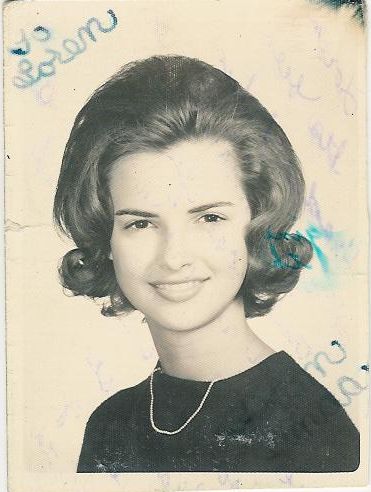 I received the photo of Linda from a high school friend of hers.
I received the photo of Linda from a high school friend of hers.
"About the picture of Linda. I was in the class ahead of Linda when she lived in Lansing, Kansas while her father was attending the Command & General Staff College at Ft. Leavenworth. Don't know if that is what it was called then! I have old year books from those days that I occasionally look thru and saw Linda's picture and the laptop was near so I goggled her name and up came your website. She had given me a couple of pictures of herself, one is the one I sent to you.
I wonder what she remembers of her time in Lansing!
Living in a military community all my life I have seen a lot of friends come and go and often wonder how their lives turned out!"
Loren Russsell"
Linda teaches gifted children in Sammamish, Washington, in the Lake Washington School District outside of Seattle, which has been her life's work. She has 120 students, 1st-6th grade, who come to her one day a week from about seven different schools.
She first married James Cox, with whom she had a daughter, Jessica, now 27. Jessica is currently attending graduate school at McGill University in Montreal, Canada, studying atmospheric physics. Linda married a second time, but without children. She then married Steven Dull, a Navy man and lived in Florida, California, and now Seattle [actually I think she lives in the suburb of Redmond]. Steve was an S-3 'Viking' pilot and retired as a Captain. He is now the 737 project director at Boeing.
Susan Anne Hissem, the daughter of Garrel G., was born on 31 March 1953 in Cumberland, North Carolina. Fort Bragg is located in Cumberland county. Susan married Clyde Perryman. She now lives in Highpoint, North Carolina with her son, David, who will attend Jr. College next year. He is an Eagle Scout.
(28) David Garrell Perryman (1985)My Father. Garrell's twin brother, Darrell, the son of Leo Worth Hissem, a 32 year old farmer, and Lena Maye Six, a 30 year old farmer's wife, was born on 7 December 1924 in Milton, Iowa, the second of the twins. His name was originally spelled Derall Dene Hissem, but was later changed, but I don't know if this was officially done. In the 1925 state census for Birmingham-Henry, Van Buren county, Iowa as Derall D. Hissem, 1. In the 1930 census of Milton, Jackson township, Van Buren county, Iowa as Derall [sic] D. Hissem, 5. In the 1940 census of Milton, Jackson township, Van Buren county, Iowa as Darrell Hissem, 15, in the second year of high school.
My Grandfather, My Dad and I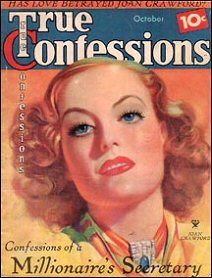 My Dad grew-up on a small, but prosperous farm in Milton, Iowa. While in the years of the Great Depression there was very little actual money to be had, the family did not want for food, clothes or housing. Most of what they needed that could not be obtained on the farm was gained by barter, something like the small-town doctor who is paid for his services in chickens. The house was small enough that my Aunt Alice had to live with her Grandparents, but they were close by and Alice spent most of her time at home.
My Dad grew-up on a small, but prosperous farm in Milton, Iowa. While in the years of the Great Depression there was very little actual money to be had, the family did not want for food, clothes or housing. Most of what they needed that could not be obtained on the farm was gained by barter, something like the small-town doctor who is paid for his services in chickens. The house was small enough that my Aunt Alice had to live with her Grandparents, but they were close by and Alice spent most of her time at home.
The family barn was painted a red and white candy-stripe, so clearly my Grandfather had style and was not just some dour, American Gothic type. A pall was cast over the family, however, by the lingering effects of his war wounds. Troubled by a wound that never fully healed and the after effects of gassing, he was never an entirely well man again. I never knew him. He appears to have been prosperous, owning two 160 acres farms. One, originally that of his grandfather Abner Hissem, was located northeast of Milton, near Douds-Leando. The other, which had been his father's farm, was to the west, near Troy, Iowa. He rented out both them. He also had, a 7 acre property in Milton which he farmed and on which his house was located, as well as other properties he bought and sold throughout the Depression. Another odd clue to Leo's character - Dad remembers he had a subscription to "True Confessions" magazine.
My grandfather married Lena May Six. Her father, George Six, had a reputation for being less, perhaps, "serious" than my grandfather. Certainly he was not the nose-to-the-grindstone type. As he told the story, George went prospecting in the Klondike, struck it rich, but was robbed on the way home, explaining his destitute condition. On more than one occasion Leo Hissem had to support his father-in-law, so I'm told, and rented one of his farms to him.
 Mechanization came to the farm in my father's youth and Dad told me about the excitement engendered by the arrival of the Steam Tractor, like the one to the left. A number of farmers wouLd go in together to rent this huge, slow moving machine and my father clearly remembers the awe inspired by its slow approach - it only went about 2.5 miles an hour. It was quickly superceded by diesel tractors, but during my father's life horses continued to be important work animals.
Mechanization came to the farm in my father's youth and Dad told me about the excitement engendered by the arrival of the Steam Tractor, like the one to the left. A number of farmers wouLd go in together to rent this huge, slow moving machine and my father clearly remembers the awe inspired by its slow approach - it only went about 2.5 miles an hour. It was quickly superceded by diesel tractors, but during my father's life horses continued to be important work animals.
Darrell and Garrell:
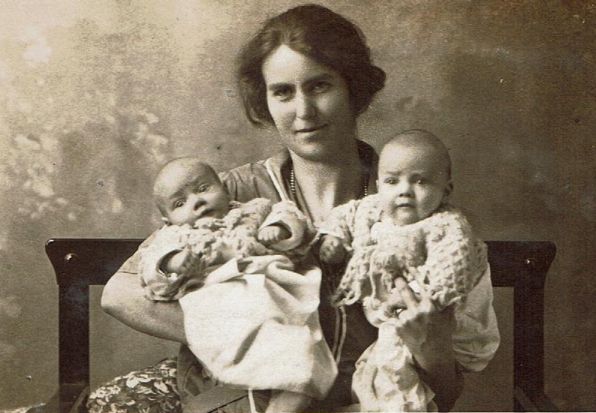 _____
_____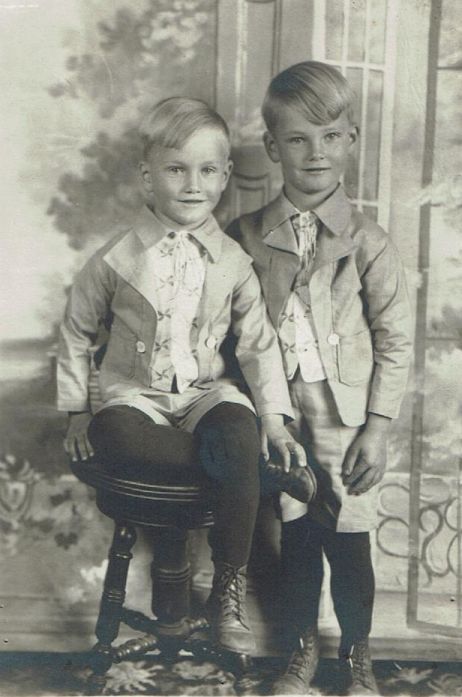
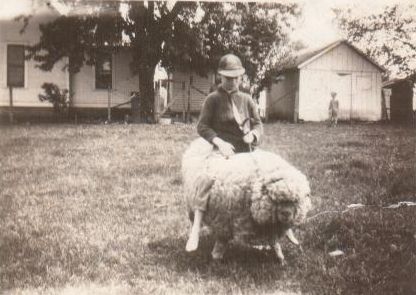 The family also kept a ram named "Billy" and my father and his twin brother used to harness it to a cart. To encourage it forward they would squeeze its testicles, which would cause the animal to bolt. Because the traces were somewhat elastic the cart would take off some time after the ram did, then quickly gather speed, bumping into the ram further exciting him. I suspect all such excursions ended in disaster. At right my Dad is riding Billy in a quieter moment. Lozelle is in the background, in front of the shed.
The family also kept a ram named "Billy" and my father and his twin brother used to harness it to a cart. To encourage it forward they would squeeze its testicles, which would cause the animal to bolt. Because the traces were somewhat elastic the cart would take off some time after the ram did, then quickly gather speed, bumping into the ram further exciting him. I suspect all such excursions ended in disaster. At right my Dad is riding Billy in a quieter moment. Lozelle is in the background, in front of the shed.
My Dad and his brother mowed yards to make a little extra money, charging between 35 and 75 cents, depending on the yard's size. The 75 cent yard was an all day affair. Dad was delegated the duty of collecting payment and found some of his neighbors slow to pay off. Later they were offered a job mowing the Sunnyside cemetary. They quickly took up the offer when they realized it included a power mower.
 The other story my Dad had from his childhood was when his twin, Garrell, carved his name in the school house door. He was caught, of course, and forced to sand down the door. His father imparted one bit of good advice to Garrell, "If you're going to carve something in the school house door, let it be something other than your own name." There was a one-room school house in the area known as the Hissem school, but I don't believe my Dad ever attended it. He went to the two story, brick school house in town, shown to the left. My father played baseball as a boy, doing well at third base, the "hot corner." He did not finish high school, leaving after his junior year.
The other story my Dad had from his childhood was when his twin, Garrell, carved his name in the school house door. He was caught, of course, and forced to sand down the door. His father imparted one bit of good advice to Garrell, "If you're going to carve something in the school house door, let it be something other than your own name." There was a one-room school house in the area known as the Hissem school, but I don't believe my Dad ever attended it. He went to the two story, brick school house in town, shown to the left. My father played baseball as a boy, doing well at third base, the "hot corner." He did not finish high school, leaving after his junior year.
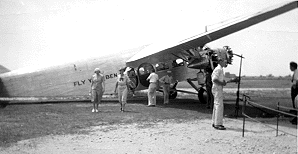 My Father took his first airplane flight in a Ford Tri-Motor in about 1940. "Big" Ben Gregory offered 50-cent plane rides out of Cram Field in Davenport, flying in the "Tin Goose." The airplane he flew is to the right. Note on its side the logo "Fly with Ben." The plane carried 14-passengers who sat on wicker seats for their light weight.
My Father took his first airplane flight in a Ford Tri-Motor in about 1940. "Big" Ben Gregory offered 50-cent plane rides out of Cram Field in Davenport, flying in the "Tin Goose." The airplane he flew is to the right. Note on its side the logo "Fly with Ben." The plane carried 14-passengers who sat on wicker seats for their light weight.
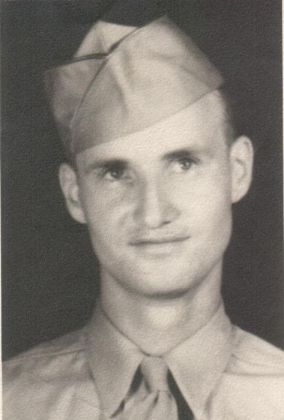 7 December 1941 was my father's seventeeth birthday and he heard the radio broadcast announcing the Japanese attack on Pearl Harbor while cruising in a Chevrolet convertible.
7 December 1941 was my father's seventeeth birthday and he heard the radio broadcast announcing the Japanese attack on Pearl Harbor while cruising in a Chevrolet convertible.
On 28 December 1942, soon after their 18th birthday, Darrell and Garrel registered for the draft. Interestingly, both listed 1412 Elm street in Davenport, Iowa as their residence and their employer as Ford Mfg Co, located as 808 Brown street, also in Davenport. Was this when my parents first met? I've always wondered how a boy from rural Milton met a gal from Davenport. My Dad listed his father, Leo, as next of kin, but also showed him living on Elm street. Garrell showed Leo as residing in Milton. The M. A. Ford Manufacturing Company was a machine tool company still active in Davenport. The address given is/was a residential neighborhood. My Dad was 5' 11" and weighed just 140 pounds.
My father's twin brother, Garrell, entered the Army first, but Dad delayed some months, not going until 19 April 1943. During his youth my father had a heart problem and he assumed he would be refused entry. This was a kind of secondary, echo heartbeat (I have the same thing). I think this perceived debility embarassed him which explained, in part, his delay in entering the Army. However, the heart arrhythmia had either disappeared or this doctor was none too picky because my Dad was accepted and eventually became a part of the Army Air Corps, as an aircraft mechanic.
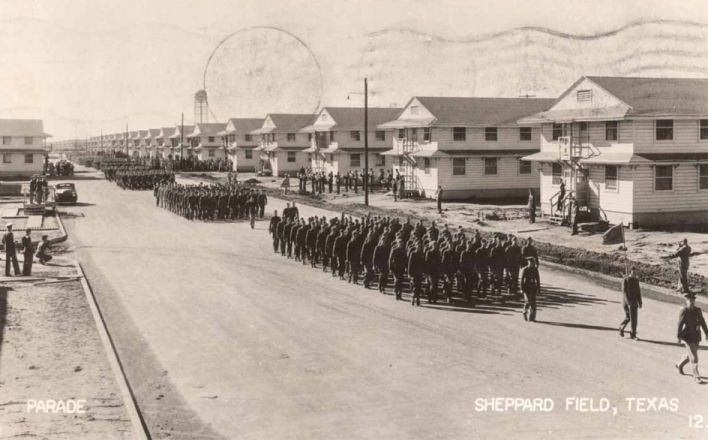 Darrell D. Hissem of Scott county, Iowa enlisted as a Private in the Army on 12 April 1943 at Camp Dodge Herrold. He had three years of High School and was classified as a machine operator.
Darrell D. Hissem of Scott county, Iowa enlisted as a Private in the Army on 12 April 1943 at Camp Dodge Herrold. He had three years of High School and was classified as a machine operator.
Darrell was first sent to Sheppard Air Force Base in Wichita Falls, Texas for basic training and aviation mechanics school. To the right is a postcard of trainees marching to class at Sheppard. I have a pass issued to Pfc Darrel D. Hissem on 1 January 1944. It required him, during off-duty periods, to remain within 35 miles of the base. While the card has a tear, I think it says he was in the 314?SS (Technical [?] School Squadron), HS TS & BTC No 3, Army Air Force Western Technical Training Center (AAFWTTC). Another document calls this the 304th TG. Organizations at Sheppard within the 1st Prov. Group included the 311, 312, 313, 314, 315, 316, 317, 318, and 319.
His first assignment after training was to the "378th Bomb Sqd.", 309th Bombardment Group (M), Columbia Army Air Base, South Carolina where he worked maintaining B-25C's. They were part of an advanced bomber training squadron. Like most young men, however, he wanted in the fight and badgered his superiors for a transfer to Europe, finally winning approval, but not until 1945, after the war was over. By the way, the B-25 pilots of the Doolittle Raid on Tokyo were all volunteers from Columbia Air Base and began their training there, though they did the majority of their training at Eglin Air Force Base in Florida.
| The 309th Bombardment Group (Medium)
The 309th Bombardment Group was a training group that served in the United States from early in 1942 until it was disbanded in the spring of 1944. The group was formed on 28 January 1942 and became part of the Third Air Force. It was equipped with the B-25 Mitchell, and at first served as an operational training group, preparing entire groups of aircrew for entry to combat. It was located at Columbia Army Air Base, South Carolina from 16 May 1942 to 1 May 1944. Once the USAAF was engaged in heavy combat it began to need replacements for casualties in existing units more than entire new units, and so the 309th became a replacement training group. This time it was preparing individual crews to join existing units or individual airmen to join existing crews that had lost a member. The group was active for just over two years, from its activation in March 1942 until it was disbanded on 1 May 1944. |
| The B-25C
|
Before the end of the war my father and mother had met and meant to get married once the war had ended.
"Mrs. Leo Hissem and sons Lozelle and Pfc. Darrell Hissem, and Jeanne Offerman of Davenport spent the week end at the Carroll Rogers house in Des Moines. On Monday Mrs. Hissem and Darrell and Miss Offerman went to Davenport. Hissem will leave Friday for Columbus, S.C." - from "The Ottumwa Courier" of 14 February 1945
The 378th was inactivated in May 1944. I can only guess that in the short time before the move described below, Darrell was transferred to another squadron at the Columbus base.
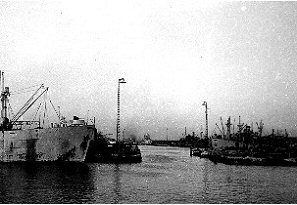 My Dad had campaigned for transfer to the European theater and he finally got his wish. He departed for Europe on 25 October 1945 in a troop transport and told me of the boredom of the trip. Not one to gamble, he used to watch the porpoises riding the ship's bow wave. Years later, while we watched the "Flipper" TV show, he noted that while this porpoise was blue, all those he had seen during his transit had been brown.
My Dad had campaigned for transfer to the European theater and he finally got his wish. He departed for Europe on 25 October 1945 in a troop transport and told me of the boredom of the trip. Not one to gamble, he used to watch the porpoises riding the ship's bow wave. Years later, while we watched the "Flipper" TV show, he noted that while this porpoise was blue, all those he had seen during his transit had been brown.
He landed in the port of Le Havre, right, in October [November?] 1945. After the city had been secured by Allied troops in September 1944, the area had been ringed with camps to serve as staging areas for new troops entering the area. Most of these camps were named after cigarettes, Camp Chesterfield, Lucky Strike, Pall Mall, etc.
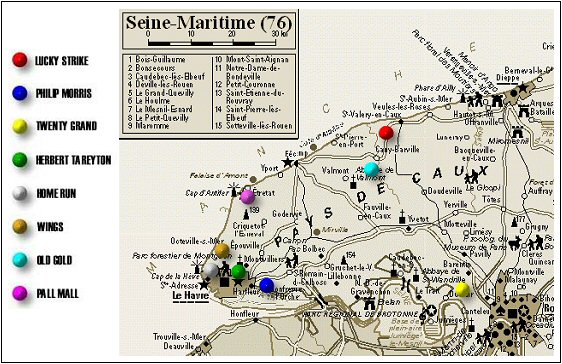 Dad had arrived in France with orders to move on to Tempelhof airbase, in Berlin, which we had received from the Russians. For the first few weeks in France, however, he lived at Camp Lucky Strike, near St. Valmy-en-Caux. During that period made many trips to Paris. The camp was little more than a tent city and was extremely cold. They slept on cots in thin sleeping bags, the cold creeping in from underneath the cots.
Dad had arrived in France with orders to move on to Tempelhof airbase, in Berlin, which we had received from the Russians. For the first few weeks in France, however, he lived at Camp Lucky Strike, near St. Valmy-en-Caux. During that period made many trips to Paris. The camp was little more than a tent city and was extremely cold. They slept on cots in thin sleeping bags, the cold creeping in from underneath the cots.
If you believe the story I've told about our family's very earliest origins, then Dad was camped not many miles up the coast from the lands of his forefathers, in Fecamp, circa 1050.
| Camp Lucky Strike
The camp became the most important military encampment in Europe. It extended over 600 hectares (1 hectare = approximately 2 acres). It was a mandatory port of entry for practically every American soldier, and 1 million spent from a couple days up to 18 months there. It was the principal camp used for repatriated soldiers and liberated POWs, but also as a reception station for soldiers on leave. It was also a staging area for the Pacific Theater and until August 10, 1945 for the invasion of Japan. There were 100,000 men in the camp each day 100,000 men to lodge, feed, train, and entertain. (Regarding repatriation, there were 6,000 daily departures by plane or boat from Le Havre, the only port liberated on the western coast that could accommodate large ships.)
The city was divided into four sections: A, B, C, and D. Each section was made up of 2,900 tents under which were housed 14,500 men. These virtual neighborhoods even had public parks, and in certain places, statues of pretty women. The Red Cross also had offices in the neighborhoods: nurses and girls who would serve hot coffee, cake, and newspapers day and night. A little further down were the bars: one for officers; another for NCOs and soldiers. One could drink everything they used to in pre-war France: the best liqueurs, good champagne, cognacs, and water of life (aqua vita), as well as Coca-Cola, whiskey, gin, and American beer. The bars were only open from 7:00 to 10:00 p.m., which was not enough time to satisfy the customers. Each sector aslo had its own auditorium, which served as a theater, cinema, and chapel all in one. There was a PX and several gift shops. The PX carried everything one could find handkerchiefs, electric razors, chocolates, condoms, cigarettes, cigars, toothbrushes, lighters, watches, and knives. In the gift shops GIs could find items from Paris which they usually sent to their mothers, wives, and girlfriends such as perfume, scarves, lace, and jewelry. A military tribunal was located in the Chateau and was presided over by a Colonel. And very near that, behind the bars, was a prison composed of a tent without heat and the guard shack. Each sector had a repair shop with thousands of repair parts and a gas station which received fuel from the harbor via tanker trucks carrying millions of liters. The lifeline of the city was assured by an administration housed in the Anglesqueville Chateau in the city of St. Sylvain. Potable water was pumped from the Durdent River, after which it was sterilized and carried by pipeline into the camp. The living conditions in the camp were very hard for the GIs, especially because of the cold, but it was infinitely more comfortable than for the French civilian population, who lacked everything, particularly food, medicine, and clothing. There was a certain feeling of bitterness on the part of the population due to the wastefulness of certain goods by the GIs. U.S. soldiers bound for the camp landed at Le Havre and were carried to Camp Lucky Strike by trucks and trains to the station at St. Valery-en-Caux. After the unconditional surrender of Germany on May 8, 1945, the camp was used for the return of troops to the United States. Before their departure, the soldiers were given new uniforms and their old ones were burned or buried. Likewise, other worn-out equipment was either burned or buried. Most of the above derived from The Cigarette Camps. |
At the heart of the camp was an old castle, the Chateau de Janville, below in a modern photo, and Dad often talked of living in a chateau while he visited Paris, but I think he merely meant that he camped out near one. Or, perhaps, in those latter days after V-E day, some of the soldiers did move into the main building. I have seen a letter from the period that indicates male soldiers lived on one side of the chatueau and female on the other. There was also an officers' club there (of course).
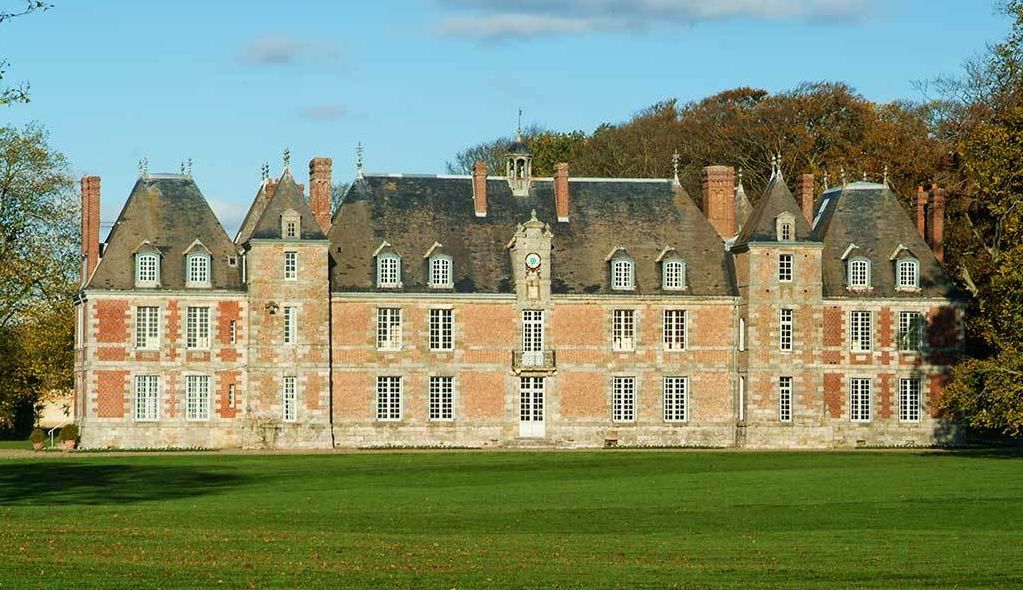
The men took frequent liberty to Paris. On one of those excursions the gendarmes decided Dad did not have the proper documents or pass and locked him in an elevator between floors in place of a jail cell while they resolved the matter. I suppose they thought he was a deserter. His pass probably wasn't valid, because he had no one in real authority to sign it.
 The gendarmes finally let him go, but did not offer transportation back to the camp. The usual transport had already left by this time and my Dad realized he did know how to get back on his own. He eventually found his way into the center of the city by the simple expedient of walking downhill and there found transportation.
The gendarmes finally let him go, but did not offer transportation back to the camp. The usual transport had already left by this time and my Dad realized he did know how to get back on his own. He eventually found his way into the center of the city by the simple expedient of walking downhill and there found transportation.
An officer had been in charge of the group of men ordered to Berlin that included my father, but at some point, and for reasons unknown, he decamped and my father took charge.
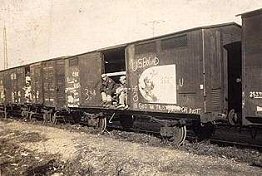 The situation in occupied Europe sounds chaotic to modern ears, but Dad was expected to make his own way to Berlin, leading a small group of men with similar orders. They would jump aboard any truck or train that was headed the right way. He noted that for transportation they usually traveled in unheated boxcars. He was always amused that these boxcars were denoted by their capacity in human beings or horses. They were known as "40 and 8's," so called for the French designation "40 hommes et 8 cheveaux," which meant the boxcars had a capacity of 40 men or eight horses. The photo at left shows the typical French boxcar.
The situation in occupied Europe sounds chaotic to modern ears, but Dad was expected to make his own way to Berlin, leading a small group of men with similar orders. They would jump aboard any truck or train that was headed the right way. He noted that for transportation they usually traveled in unheated boxcars. He was always amused that these boxcars were denoted by their capacity in human beings or horses. They were known as "40 and 8's," so called for the French designation "40 hommes et 8 cheveaux," which meant the boxcars had a capacity of 40 men or eight horses. The photo at left shows the typical French boxcar.
When Dad got to Berlin in November 1945 he was promoted to Staff Sergeant, but if that was due to the action of a promotion board or as a reward for leading his men successfully to Berlin, he didn't know. He was assigned to the 473rd Air Services Group, European Air Transport Service, at Templehof airport in Berlin where he did maintenance on the C-47's. Dad mentioned that he got ribbed a lot because the patch he wore on his uniform had the outfit's acronym, EATS. Below is a photograph of a line of EATS C-47s at Templehot. The unit was at Templehof from 4 July 1945 to 1 December 1946.

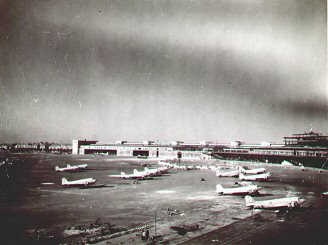 Tempelhof Air Drome, Berlin, Germany Tempelhof Air Drome, Berlin, Germany
Tempelhof, named for the Knights' Templar land it was located on, was designated an airport in 1923. Its iconic curved terminal was constructed in the 1930's. The building complex was designed to resemble an eagle in flight with semicircular hangars forming the bird's spread wings. It was the center of the Berlin Airlift 1948-1949. This base was the home of the 301st Troop Carrier Squadron (squadron code "Z4") beginning on 4 July, 1945. They had C-47's including five modified to the VC117B standard. After 1945 Tempelhof was taken over by the U.S. as an air base. The 473rd Air Service Group, United States Army Air Forces, led by Col. William Booth, took command of the U.S. Army Air Force Station, Tempelhof following the end of World War II, on May 27, 1945. |
While at Tempelhof Dad was approached to take charge of a hangar full of aircraft, including a P-51 the Operations office pilots wanted to fly, a P-38-F5, a P-47 that was to be transferred once it got a propeller swap, an L-4 the general wanted to fly for currency, and some Stinson L-5's (4 of them?) used for weather recce.
| The P-38
|
| The Stinson L-5 Sentinel
The L-5 was the military version of the commercial Stinson 105 Voyager. Also known as the Flying Jeep. Unlike other pre-war civilian aircraft that were adopted pretty much off-the-shelf by the military, the Voyager underwent a substantial redesign and emerged as a new type specifically tailored for the liaison role. The military command really wanted an aircraft comparable to the impressive German Fiesler 'Storch' yet they didn't want to spend a lot of money or wait years for development of a new type. Many good designs were already The foregoing was derived from the work of Jim Gray, president, Sentinel Owners and Pilots Association. |
| The Piper L-4 Grasshopper
|
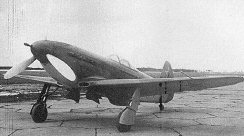 Dad jumped at the chance to maintain this diverse group of aircraft and was given a few junior personnel to assist him. He made a PFC, who had experience with the Mustang, the crew chief for the P-51. Dad took the P-38, though, in the end, this aircraft was never flown. It seems that on a regular basis a Soviet YAK-3, like the one to the left (though he may have meant YAK-9, which was in use at the end of the war and more of a match for the Mustang), would fly over the field, "taunting" the Americans, and the P-51 was used to respond.
Dad jumped at the chance to maintain this diverse group of aircraft and was given a few junior personnel to assist him. He made a PFC, who had experience with the Mustang, the crew chief for the P-51. Dad took the P-38, though, in the end, this aircraft was never flown. It seems that on a regular basis a Soviet YAK-3, like the one to the left (though he may have meant YAK-9, which was in use at the end of the war and more of a match for the Mustang), would fly over the field, "taunting" the Americans, and the P-51 was used to respond.
The L-5's went out almost every day on weather recce's and Dad would grab a back seat ride whenever he could. He said he had always idolized pilots and this was when he first realized that flying wasn't really all that hard and he might be able to do it himself. When he returned from Europe he immediately started flying lessons in Davenport. His experience was obvious to his flight instructor and Dad eventually soloed in under 8 hours.
Dad thoroughly enjoyed his time at Tempelhof and sought to extend on active duty, but extending was rarely granted - it was assumed you must be in the black market - and Dad went home on time. He left Europe, through Le Havre and Camp Lucky Strike again, on 4 April 1946 after a brief stay in the Alps at what he called a "repo depot".
| Repo Depot
Or repple-depple. GI slang for a Replacement Depot, a holding area for in-coming and out-going troops. At least one GI claimed it was just one step above the stockade as a place to be. For those on their way home, they would be billeted here while they awaited transport. They would check a bulletin board daily to see if they were on the list to ship out. |
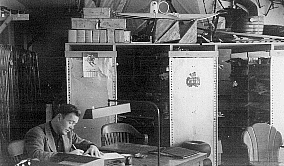 The north Atlantic was rough in April and my Dad, who does not suffer from sea-sickness, reported that he had the mess decks pretty much to himself. He arrived in New York and went by train to Camp McCoy, a separation center in Wisconsin, where he was honorably discharged. On the train he spent a good deal of time in the bar car and, he reports, it was one of the quickest trips he can remember taking. At Camp McCoy he met, against all odds, an old friend from Milton, Iowa. Dad was separated from the Army on 8 April 1946.
The north Atlantic was rough in April and my Dad, who does not suffer from sea-sickness, reported that he had the mess decks pretty much to himself. He arrived in New York and went by train to Camp McCoy, a separation center in Wisconsin, where he was honorably discharged. On the train he spent a good deal of time in the bar car and, he reports, it was one of the quickest trips he can remember taking. At Camp McCoy he met, against all odds, an old friend from Milton, Iowa. Dad was separated from the Army on 8 April 1946.
When Dad got home he began flight instruction in the Piper J-3 Cub at Elliott Aviation. This was a fixed-base operator (FBO) located on Cram field, on the west side of Davenport. His instructor was Roy Moses. At right is a picture of Roy sitting at a desk in the Parts department. Dad solo'ed in 7 hours and got his license with 40 hours of flight time.
| Cram Field
In the picture to the left are a line-up of J-3 Cubs in 1937. The Cub was the prototypical light-plane of the 30's and 40's. While slow, and only able to carry two people, it was inexpensive to buy and to maintain. It was an excellent trainer that highlighted the student's mistakes without making him pay for them.
The field was later abandoned and the area is now homes. |
After he learned to fly his logbook was filled with the names of friends and relatives he took flying. These included his finacee, my Mom, his brother-in-law, Carrol Rogers, and his younger brother, Lozelle, whose name filled the book. Lozelle wanted to learn to fly as well and grabbed as many flights as he could. My Dad reports that when Lozelle began his flight instruction he did so in the Aeronca Champ. This aircraft was similar to the Cub, but the pilot sat in the front seat whereas in the Cub it was flown from the rear. The Champ was also a little faster. The airplane my Father flies today, a Citabria, was a development of the Champ.
The photo below was taken, I think, soon after the war. That's Darrell, Garrell and Lozelle.
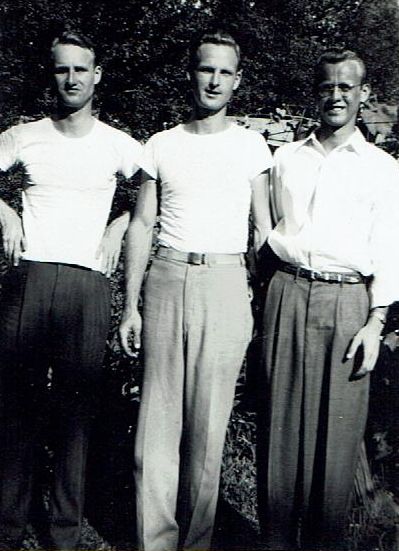
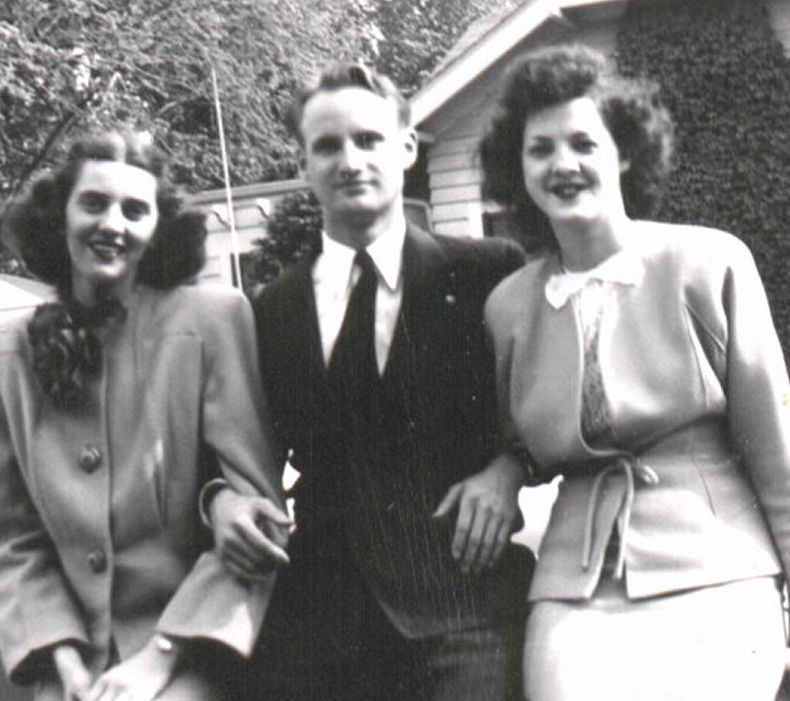
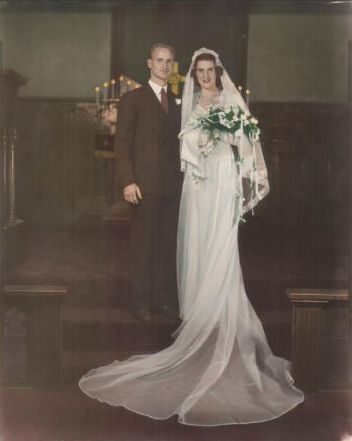 On 6 October 1946 Darrell Dean Hissem, 21, the son of Leo W. Hissem and Lena Six, married his girlfriend, Jeanne Catherine [sic] Offerman, 21, my mother, the daughter of Elmer Offerman and Edna Dengler, in Scott county, Iowa. One of my favorite stories is that, while in Europe, Dad had bought Mom a bottle of French perfume [in Paris or at the PX in Camp Lucky Strike on the way home?]. During all of his subsequent travels he had been careful to keep this fragile bottle safe and when he arrived back home he proudly showed off the gift he was going to give to a friend of his mother's. Of course the bottle slipped, hit the hard wood floor and burst. Dad was inconsolable and the finish on the floor was never the same.
On 6 October 1946 Darrell Dean Hissem, 21, the son of Leo W. Hissem and Lena Six, married his girlfriend, Jeanne Catherine [sic] Offerman, 21, my mother, the daughter of Elmer Offerman and Edna Dengler, in Scott county, Iowa. One of my favorite stories is that, while in Europe, Dad had bought Mom a bottle of French perfume [in Paris or at the PX in Camp Lucky Strike on the way home?]. During all of his subsequent travels he had been careful to keep this fragile bottle safe and when he arrived back home he proudly showed off the gift he was going to give to a friend of his mother's. Of course the bottle slipped, hit the hard wood floor and burst. Dad was inconsolable and the finish on the floor was never the same.
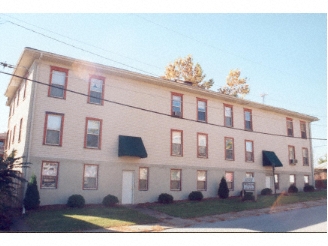
Dad spent about eight months out of the service, working as a tool salesman, selling the Stanley line to the local farmers. They lived into an apartment in Davenport.
"Hissem Darrell D (Jeanne) slsmm [salesman] h217 E 10th apt 5W" - from "Polk's Davenport (Scott County, Iowa) City Directory of 1947These were the Bixby Apartments. This apartment building, shown above, was built in 1910.
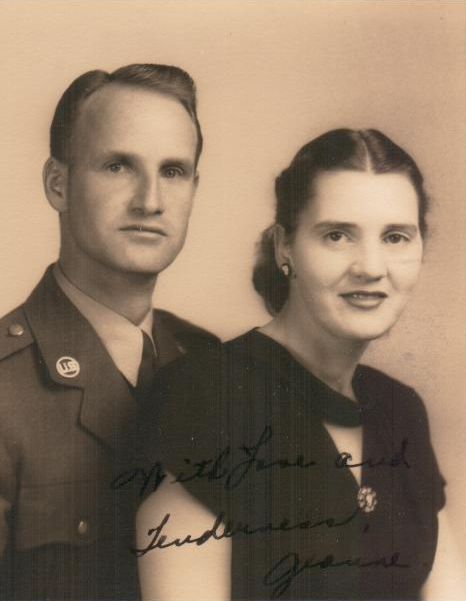 He did well in the job, but disliked the uncertain nature of sales, so when a local recruiter offered him his old stripes back and duty in the local area as a recruiter, he jumped at the chance. Another perk of the job was that he would receive per diem, an important point for the newly married Sergeant. Before starting his new job he was sent to Omaha where he was trained by insurance salesmen in the art of sales. It was said they best understood the selling of intangibles, whether that be a secure future for your family or a career.
He did well in the job, but disliked the uncertain nature of sales, so when a local recruiter offered him his old stripes back and duty in the local area as a recruiter, he jumped at the chance. Another perk of the job was that he would receive per diem, an important point for the newly married Sergeant. Before starting his new job he was sent to Omaha where he was trained by insurance salesmen in the art of sales. It was said they best understood the selling of intangibles, whether that be a secure future for your family or a career.
Having learned the love of flying in Europe Dad started flight instruction in the J-3 Cub. He solo'ed before re-upping.
Later, when he was working as a recruiter in Muscatine, Iowa, he signed up his brother Loselle. Losie afterwards learned to fly in imitation of Dad and owned a war-surplus Vultee trainer for a couple of years. I believe the address of the recruiter' office in Muscatine was 601 Grandview Avenue.
My sister, Georgia, was born in Davenport, Iowa in 1948 and I think in May 1949 the family was still living there when Dad received a bonus from the state of Iowa for his war service. Soon after that they moved to Nellis Air Force Base, Nevada, just outside Las Vegas.
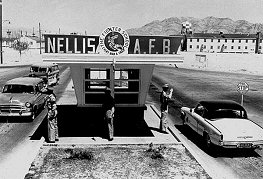 Nellis Air Force Base Nellis Air Force Base
Nellis AFB started out in World War II as the Las Vegas Army Air Field. This training facility was shut down after World War II, but reopened as the Las Vegas Air Force Base on 13 January 1948. The 3595th Pilot Training Wing (Advanced Single-Engine) was established there on 22 December 1948 and training began on 1 March 1949. The 3525th Aircraft Gunnery Squadron was activated there on 11 February 1949. The base hosted the 1st USAF Gunnery Meet on 2 May 1949 (see Darrell's photograph below). A second competition was conducted in 1950, but suspended due to the outbreak of the Korean War.  F-51D of the 3595th Fighter Pilot Training Wing at Nellis AFB in early 1950 The P-51 above is still flying as a race plane, known as 'Straw Boss 2.' The base was renamed Nellis AFB on 20 May 1950. Its advanced single-engine pilot training mission was transferred on 1 September 1950. |
Dad was probably assigned to the new 3595th Pilot Training Wing, servicing the P-51D, later redesignated the F-51D.
In the 1950 census of Clark county, Nevada as Darrell D. Hissem, a 25 year old Airman in the Air Force, of Iowa. Living with him were his wife, Jeanne K., 25, and daughter, Georgia J., 2, both of Iowa.
In the immediate post-WWII years housing was hard to get and while at Nellis my Mom and Dad bought a house trailer. They didn't really like it, however, or the trailer park. Below, a young Darrell Hissem being flash, at a gunnery competition. I don't know if this was the 1949 or 1950 event.
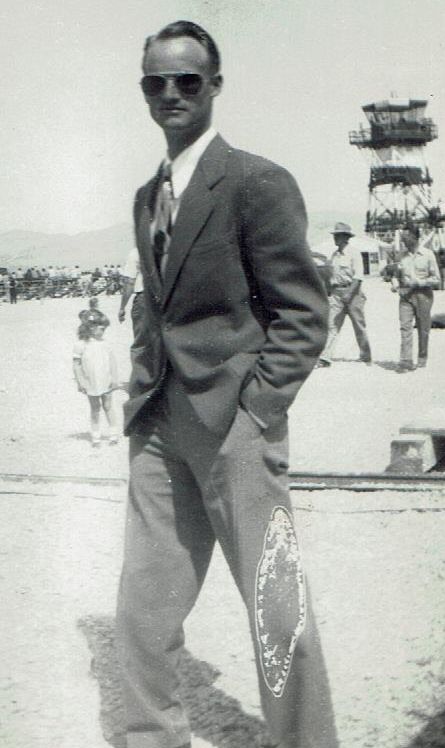
| Historical Timeline: The 1950's
An era of unprecedented prosperity for America. Pent-up demand and new technologies, such as the transistor, drove consumers to buy, while the GI Bill boosted large numbers of veterans into the white color ranks. The Cold War with the Soviet Union dominated and poisoned international diplomacy. - 1952 The Korean War ended with both sides basically where they started.- 1957 The Russians launched Sputnik, the first man-made satellite. The Space Age began. |
After Nellis, the family moved to Luke Air Force Base, on the west side of Phoenix, Arizona. Like Nellis, Luke had been a training base in World War II and closed soon after. It was reopened in February 1951 as an Air Force base, part of the Air Training Command. Students at Luke progressed from the P-51 Mustang to the F-84 Thunderstreak. The Air Force demonstration team, the Thunderbirds, was formed at Luke AFB in 1953.
In 1952 my parents lived on 1135 West Culver street - from the Phoenix City Directory of 1952. This was just south of Encanto Park. This is today an area of cute bungalows. West 1135 looks like a suburban gothic. I remember my parents taking my sister and I to this park, and cruising the neighborhood looking at houses. I wonder if they visited their old residence?
By mid-1952 Darrell had been promoted to Tech Sergeant (E-6).
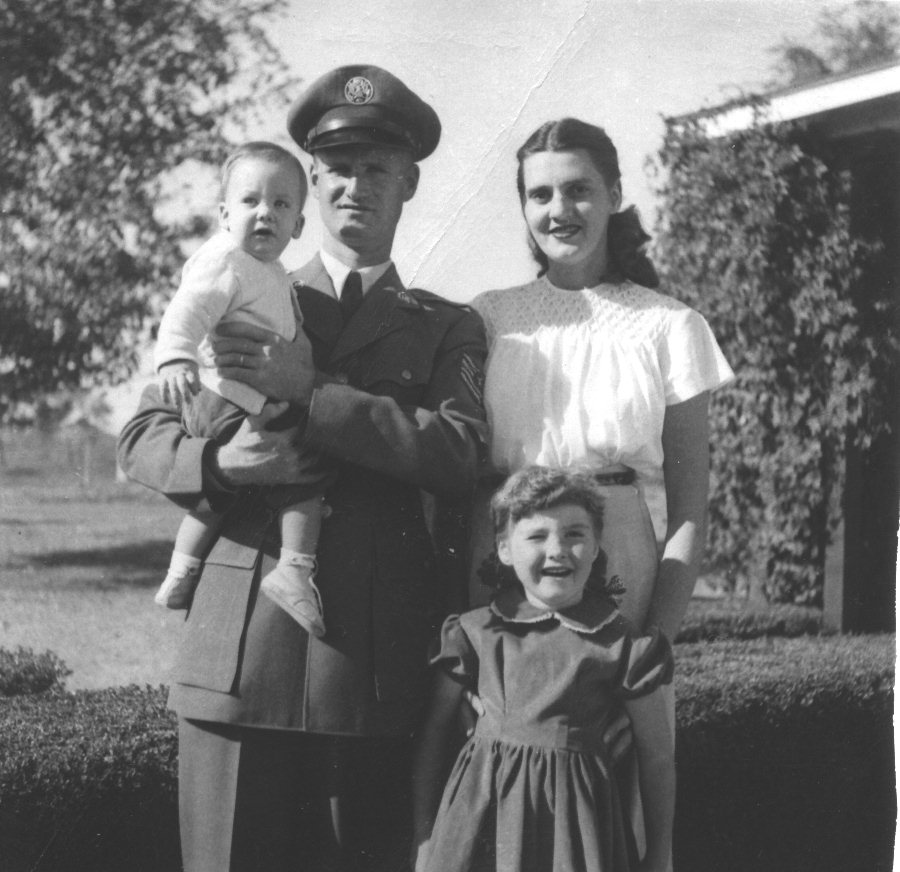
I was born at the Luke Air Force Base hospital and spent the first two years of my life in a craftsman-style home in the suburbs of Glendale, just east of the base. Georgia still remembers Dad telling her about "tying down the Mustangs" at the end of his work day, which horrified my horse loving sister. He was, of course, securing the P-51 fighter aircraft. My Dad was then transferred to Okinawa, where he maintained a squadron of F-86's. He found the commanding officer, the ace Frank Gabreski (who died on 31 January 2002), to be one of his best. Gabreski was the top American air ace of World War II, having shot down 28 German aircraft over Europe. Later, during the Korean war, he downed a further six enemy jets. In the meantime my Mom took my sister and me back to Iowa to live in Davenport. Here my first real memories begin. As I remember it, we lived in a white frame, two-story row house. My Grandma Hissem, now a widow, was a matron in a home for orphan boys, the Annie Wittenmyer Home. My impression is that this orphanage was just around the corner from our house, but, being only a few years old at the time this could be wildly inaccurate. I enjoyed visiting the orphanage, though my grandmother warned me to stay away from the boys, who were much older than I was and a bit too wise in the ways of the world. Here I'd frequently meet my cousins Shawn and Keating, as well as my many female cousins. The orphanage was in the shape of a quadrangle, with one end open. Each "house" was separate but connected by a colonnade. Terrifying and intriguing to me was the fire escape. Simply a tube shaped like a child's slide, but enclosed, it was pitch dark inside and went from the second story of each house to the ground. I never dared use it, though my cousins did.
Below are pictures of some of the individual homes taken after the home closed. The Wittenmyer home had originally been a Soldiers' Ophans home, much like the one that George Heysham, of the Robert Heysham branch of the family, put his children in after the death of his wife. My grandmother was the matron of the house to the right. Just right of that, across a sidewalk, was the chapel.

| The Iowa Soldiers Orphans' Home
During the Civil War Annie Wittenmyer, who was a volunteer working on issues of food, clothing and medicine for the soldiers, received a letter from the field that said, in part, "We are grateful for all the kindness shown us . . . but we prefer you should forget us . . . if you will but look after our wives and children, our mothers and sisters, who are dependant upon us for support . . .Succor them, and hold your charity from us."She followed this advise and, after establishing a temporary home in Farmington in 1864, Annie founded the present home for orphan's in Davenport, Iowa in 1865, initially with 150 children. She died in 1900 and in 1949 the orphanage was named in her honor. In 1975 the home closed. Over its 110 year life some 12,000 orphans passed through its doors. |
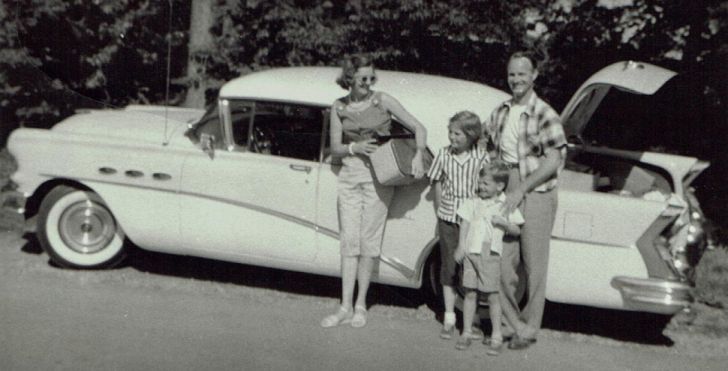 When my Dad came home from Okinawa we moved to Bryan Air Force Base, Texas, near College Station and the University of Texas. My memories of these years are of moving, usually every two years or so. Always rising well before sunrise, I'd sit, half asleep in the back seat of the car, watching the black highway illuminated only by the headlights of our car. For the next several assignments my father was in the Air Training Command, working on T-33's and later T-38's. In Texas my folks bought a small blue house on Mockingbird Lane in a new suburban neighborhood. I think it had two bedrooms, a single bath, with just a living room and kitchen in addition. It also had a single carport. I don't remember much about the interior of this house, but outside is indelibly imprinted on my brain. There was a large forest behind the houses across the street and my friends and I spent every waking Moment there. There was a lightning-struck tree, which had fallen over onto another tree, creating a perfect ramp to climb into the higher branches. There was also a creek in which we sailed model boats and, on at least one point, sailed and sunk my sister's dog, Buttons.
When my Dad came home from Okinawa we moved to Bryan Air Force Base, Texas, near College Station and the University of Texas. My memories of these years are of moving, usually every two years or so. Always rising well before sunrise, I'd sit, half asleep in the back seat of the car, watching the black highway illuminated only by the headlights of our car. For the next several assignments my father was in the Air Training Command, working on T-33's and later T-38's. In Texas my folks bought a small blue house on Mockingbird Lane in a new suburban neighborhood. I think it had two bedrooms, a single bath, with just a living room and kitchen in addition. It also had a single carport. I don't remember much about the interior of this house, but outside is indelibly imprinted on my brain. There was a large forest behind the houses across the street and my friends and I spent every waking Moment there. There was a lightning-struck tree, which had fallen over onto another tree, creating a perfect ramp to climb into the higher branches. There was also a creek in which we sailed model boats and, on at least one point, sailed and sunk my sister's dog, Buttons.
The family car was a blue and white 1956 Buick Special, pictured to the right. It was always spotless. I think the photo was taken during a visit to my Uncle Garrell, at Fort Hood, Texas.
I didn't go to either pre-school, which probably wasn't available, or to kindergarten, which was considered new-fangled and unnecessary. "The Mouseketeers Club" was our favorite TV show, though I remember something about the "Lives of the Bengal Lancers" whose antics we aped. I would up in the emergency room because of that show.
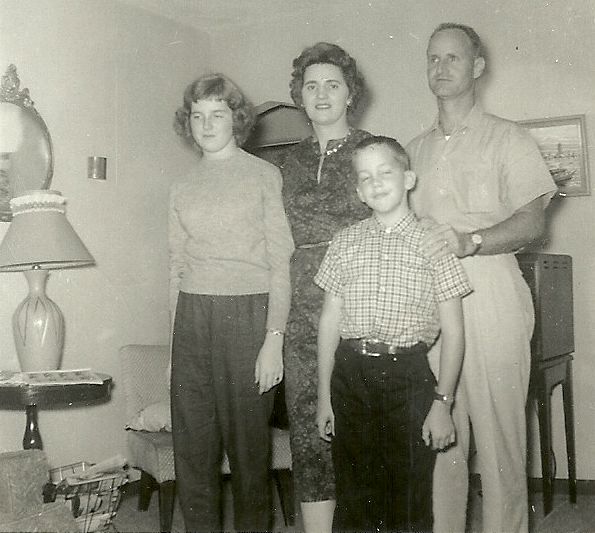 Our next assignment was Greenville Air Force Base, Mississippi, which was a huge culture shock. Greenville is in northwestern Mississippi, not far from Vicksburg and the river. The area was depressed, poverty was endemic, and I had never seen a black person before. Finding housing was more difficult than ever. My folks had not sold their house in Bryan, so they were looking for a rental. I remember going with them looking at houses and, in particular, one that reminded me more of a shed whose floor tilted noticeably. They finally found a place in Leland, Mississippi, but it was still pretty horrible. Leland was a small time due east of Greenville. A two-bedroom tar-paper shack with chickens in the back yard. Very rustic. Later we moved across the street to a frame house with a finished attic that became my bedroom and playroom. I had complete privacy up in my room, for the first time ever, and I loved it. I had a model railroad set, not the Lionel, but the cut-rate American Flyermodel, which I played with endlessly.
Our next assignment was Greenville Air Force Base, Mississippi, which was a huge culture shock. Greenville is in northwestern Mississippi, not far from Vicksburg and the river. The area was depressed, poverty was endemic, and I had never seen a black person before. Finding housing was more difficult than ever. My folks had not sold their house in Bryan, so they were looking for a rental. I remember going with them looking at houses and, in particular, one that reminded me more of a shed whose floor tilted noticeably. They finally found a place in Leland, Mississippi, but it was still pretty horrible. Leland was a small time due east of Greenville. A two-bedroom tar-paper shack with chickens in the back yard. Very rustic. Later we moved across the street to a frame house with a finished attic that became my bedroom and playroom. I had complete privacy up in my room, for the first time ever, and I loved it. I had a model railroad set, not the Lionel, but the cut-rate American Flyermodel, which I played with endlessly.
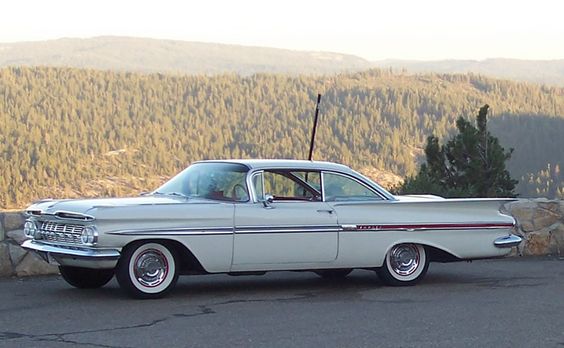 My Dad traded the Buick in on a White 1959 Chevrolet Impala, but . . . he didn't tell my Mom until we showed up at the dealership to pick it up. She immediately went to the blue Buick and had to be told that was a non-starter.
My Dad traded the Buick in on a White 1959 Chevrolet Impala, but . . . he didn't tell my Mom until we showed up at the dealership to pick it up. She immediately went to the blue Buick and had to be told that was a non-starter.
I attended first and second grade in Leland in a segregated school. Blacks did not live in town, but on the other side of the tracks in a place called "Black Dog." Their school was held in a small Baptist Church. My best friend was Smitty Reeves, whose father ran the lumberyard. Smitty gave me my first taste of beer, the warm remains of a Budweiser that I found awful.
 We then moved to Williams Air Force Base, Arizona, pictured to the right, on the east side of Phoenix. We lived on base in military housing. The houses were built along semi-circles with large grass areas in the middle, and just to the other side of the road was the desert. It was a perfect place for play and we engaged in endless games of army, cowboys & indians, and football. Once again, we spent as little time inside the house as possible. The only exception being when the TV show "Combat" came on. All games were put on hold for that event. I attended third, fourth and fifth grades there. I had a lot of trouble in the third grade, perhaps because of the poor schooling I had received in Mississippi, and had to attend summer school at the end of that year to improve my reading skills. After that, however I learned to like school and love reading. My best friend was Steve Lloyd, who lived next door. My Dad bought a used Vespa, hand-painted red, to get and forth to the flight line because my Mom was using the car to drive to her work. She now worked as a secretary in the Civil Engineering Department of the base.
We then moved to Williams Air Force Base, Arizona, pictured to the right, on the east side of Phoenix. We lived on base in military housing. The houses were built along semi-circles with large grass areas in the middle, and just to the other side of the road was the desert. It was a perfect place for play and we engaged in endless games of army, cowboys & indians, and football. Once again, we spent as little time inside the house as possible. The only exception being when the TV show "Combat" came on. All games were put on hold for that event. I attended third, fourth and fifth grades there. I had a lot of trouble in the third grade, perhaps because of the poor schooling I had received in Mississippi, and had to attend summer school at the end of that year to improve my reading skills. After that, however I learned to like school and love reading. My best friend was Steve Lloyd, who lived next door. My Dad bought a used Vespa, hand-painted red, to get and forth to the flight line because my Mom was using the car to drive to her work. She now worked as a secretary in the Civil Engineering Department of the base.
As a boy, I and my friends spent long hours out in the desert, playing complicated games and mimicing our heroes from TV shows like "Combat!" There were old ammo dumps out beyond our housing, see below, but unused when I lived there. We used to take our bikes to the top and ride them down. It seemed a pretty steep descent at the time and I remember taking a header on one ride down.
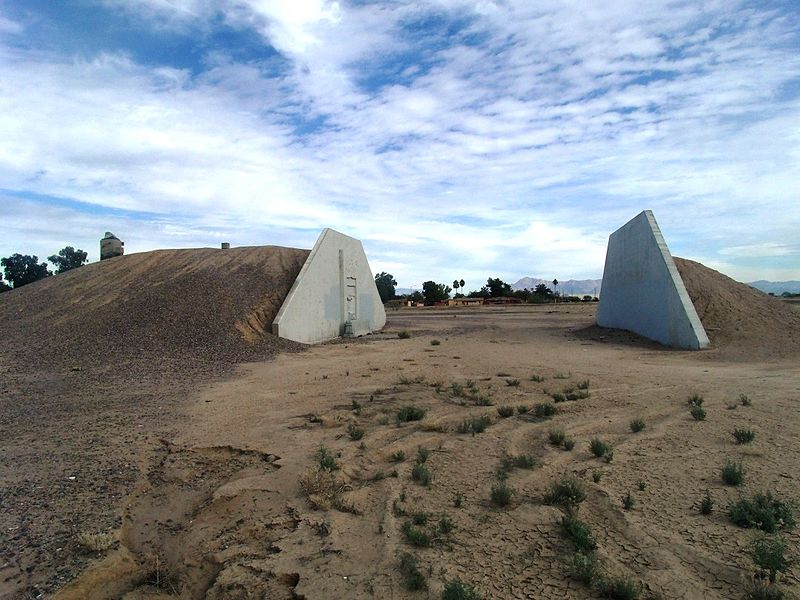
 My Dad started flying again after a long hiatus as a member of the Air Force Flying Club that used the base's runways. I had my first flight when my Dad put me in the jump seat of a Cessna 140 while he got his check-out from a club pilot. The Club had the 140, a Navion and a T-34. At other times they had a Cessna 120 and a couple of Travel-Airs, however by then I had become contrary and decided I didn't like flying so I never flew these aircraft.
My Dad started flying again after a long hiatus as a member of the Air Force Flying Club that used the base's runways. I had my first flight when my Dad put me in the jump seat of a Cessna 140 while he got his check-out from a club pilot. The Club had the 140, a Navion and a T-34. At other times they had a Cessna 120 and a couple of Travel-Airs, however by then I had become contrary and decided I didn't like flying so I never flew these aircraft.
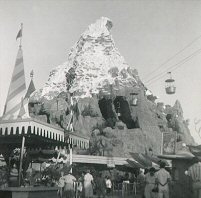 We almost never went on vacations, usually just visiting relatives while enroute from one base to another, but in 1960 we drove to Los Angeles and went to Disneyland for a day. I remember I was terribly disappointed that the Jungle Cruise was closed. I've made up for it by taking my family to the park every year.
We almost never went on vacations, usually just visiting relatives while enroute from one base to another, but in 1960 we drove to Los Angeles and went to Disneyland for a day. I remember I was terribly disappointed that the Jungle Cruise was closed. I've made up for it by taking my family to the park every year.
My Dad was strict in our upbringing and somewhat remote, as Dad's of that era were, but the atmosphere was always loving. I did get "whuppin's" for various transgressions from both my Mom and Dad, though I don't remember thinking any of them was undeserved.
My father was then transferred to Iceland. Choosing not to take his family on this arduous tour, he was able to limit his term to just a year. However, the family had to leave base housing, so we moved to Chandler, Arizona, the nearest town to the Air Force Base where my mom continued to work. I attended sixth grade in Chandler. While in Iceland my Dad worked on the F-102 as the Chief of Maintenance Control. The aircraft were assigned as Interceptors, used to patrol the northern skies and intercept Soviet bombers, like the Bear and the Badger. Later, when I was in the Navy, we intercepted the same type aircraft [considering their out-of-skew economics, perhaps the very same ones].
Just before my Dad got to Iceland the squadron had failed its Operational Readiness Inspection. A big part of his job was getting the squadron maintenance back on its feet. He related how satisfying this tour was because he was able to have such a significant impact on the squadron's performance.
| 57th, "Black Knights," Fighter Interceptor Squadron, Keflavik AFB, Iceland
F-102As replaced the squadron's F-89's between August and October 1962. The strength was established at 12 single seat F-102As and two TF-102A (affectionately called TUBS) two seaters. This strength was maintained until 1973 with most of the aircraft like the two seaters staying for the entire eleven years. Soon after the F-102As took over the alert duty the Russians started their long distance flights from Murmansk down into the North Atlantic. These sorties were of various types. Flights to Cuba, and then Africa; reconnaissance flights down along the east coast of Iceland and the up along the west coast between Iceland and Greenland and then flights where the aircraft went back along the same route they came. Almost all of these flights took the Russians into the Iceland's MADIZ (Military Air Defence Identification Zone). Of course all were unannounced and without any flight plans being filed with Air Traffic Control (ATC). The indication of approaching aircraft usually came from the Norwegian radar stations which practically look down on the Kola peninsula airfields. Until 1965, the USN had the Barrier Atlantic in operation with Lockheed WV-2 Super Constellation radar pickets. This meant that one aircraft was at all times supposed to be on station east of Iceland, and another to the west. The nearest alternate airfields for the F-102As were Lossiemouth and Leuchars in Scotland. The 57th often had to use these facilities and diverted to Scotland when bad weather at Keflavik was likely to make landings there unsafe. The 57th "Deuces" became a frequent sight on these bases. |
When my father came home we found that he had been ordered to Webb AFB in Big Spring, Texas. My Mom had hoped to return to Williams AFB and worked hard to turn these orders around, but to no avail. My Dad traded the Impala in on a gorgeous maroon 1964 Chevrolet Chevelle Malibu SS convertible. I was the envy of all, or so I thought, and especially loved it when my Mom would pick me up at school - with the top down of course. Actually, my Mom almost never picked me up and these were very special occasions. I either walked or rode my bike to school. Dad had also brought home a 1963 Volkswagen that he had used in Iceland. Later both my sister and I learned to drive in this car.
| Historical Timeline: The 1960's
An era of prosperity and turmoil. As the Vietnam War heated up the young turn to protest and a counter-culture dominated by drugs. Perhaps spoiled by the wealth in which they were raised, they turned their backs on their parents way of life and sought a spiritual life (they got over it and became the Boomers, the most fiercely materialistic generation in the nations history). The Civil Rights movement made significant gains. - 1961 the Soviets launched the first man, Yuri Gagarin, into space.- 1962 the Cuban Missile Crisis. - 1963 President Kennedy assassinated. - 1964 After his election, President Johnson significantly boosted America's role in the Vietnam War. - 1969 America landed a man on the Moon. |
Big Spring, Texas was another big shock. It was a small town of about 30,000 isolated in the middle of a vast scrub-land. The closest town of any size was Midland, about an hours drive away. Collocated with an oil refinery, the town always smelled of rotten eggs. By the way, the opening sequences of the movie "Midnight Cowboy" were filmed in Big Spring. It's the town John Voight can't wait to get away from and I shared his feelings. Below, from the opening credits, is the Motel we stayed in when we first got to Big Spring. It was a hell hole, right off the departure end of Webb Air Force Base's main runway. The T-37's used to roar overhead with a particularly noxious whine.

I attended seventh, eighth and part of ninth grades in the Goliad Junior High School. The locals were all the sons of ranchers or oil workers and had little use for the "cosmopolitan" Air Force kids. I had a lot of run-ins with the local toughs and had a difficult time of it.
A Webb AFB aerial view is below. The Air Training Command side is to the left, while the Air Defense Command site is the ramp on the far right side of the photo. The complex in front of this ramp, between the taxi way and runway, is an addition that wasn't there when my father worked there. By the way, look at the bottom right corner of the photo, off the end of runway 17, and just across the road from the air field. Those are the remains of the motel we lived in when we first arrived in Big Spring.

My Dad was assigned to the 331st Air Defense Command squadron, which flew F-104's, a beautiful, if ineffectual aircraft. He was again in charge of Maintenance Control, but here there was a more senior enlisted man who kept Dad from putting in place those improvements he thought necessary. The squadron was never, in my Dad's opinion, as "hot" as the 57th.
| 331st Figher Interceptor Squadron
|
Much of west-central Texas is a relatively flat, dry region noted for its geographic monotony.
My Dad also belonged to the Air Force Flying club there. They flew out of the local general aviation airport, Howard County airport, and had a Cessna 150 and 172.
"M.Sgt. Darrel D. Hissem, president of Webb Aero Club, announced this week that the club has been awarded the Federal Aviation Agency's Flight Safety Award for 1965. The award is given to Air Force aero clubs posting accident-free flying records during the year." - from the "Big Spring Daily Herald" of 8 May 1966It was a good club and we frequently met for picnics at the airfield. There would be spot landing contests, we'd wash the planes, and eat. I remember my Mom was always careful to bring extra for the bachelor officers in the group.
"Contestants of the spot landing contest held last Saturday by Webb Aero Club at the airport, put on a good showing with Darrell Hissem winning first place, commercial class, by landing eight feet from the marker." - from the "Big Spring Daily Herald" of 26 June 1966I remember I was in the right seat when Dad won this contest.
Fearing transfer into the developing Vietnam War, my Dad retired from the Air Force after about 22 years of service and we moved back to Arizona, settling in Tempe to be near the University. When my Dad put in his papers his commanding office let him know that the squadron was moving into an "exciting new mission," training Jordanian pilots in the F-104, and was quite disappointed, per Dad, when this failed to sway my Dad into staying in. We then moved to Tempe, Arizona. I completed high school at McClintock High School, a fairly new facility and then attended Arizona State University, as did my sister. My Dad was concerned with getting a job as quickly as possible and when an aircraft maintenance job didn't come along soon enough, he accepted a position with the Post Office and worked there for another twenty years. I don't think he was ever happy being a mail-man, but he did a good job at it. When the people on his route found he was retiring, they threw him a very nice party. Not something I can imagine doing for my mailman. My folks had built a new house in Tempe where they lived for many years.
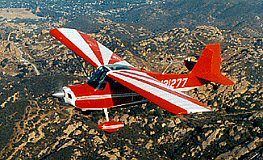 While in college I learned to fly and then took an aerobatics course in a Citabria with Cliff Sterrenberg. My flying encouraged Georgia to learn and we determined to buy an airplane together. When our discussions got serious my father joined us making the ownership a true possibility. We bought a brand new 1973 Citabria 7ECA, an aerobatic two-seat aircraft like the one on the left, and Georgia and I picked it up at the factory in Osceola, Wisconsin. We kept the aircraft at various places at first, finally settling at Falcon Field in Mesa. My Mom, tired of family conversations that revolved exclusively around flying, finally decided she'd learn to fly too, and did, getting her license at the age of fifty. The photograph below is of the four of us at an airshow at Williams Air Force Base. The base newspaper thought our story was interesting and did an article about us, using this photo. I was in my long hair hippy phase.
While in college I learned to fly and then took an aerobatics course in a Citabria with Cliff Sterrenberg. My flying encouraged Georgia to learn and we determined to buy an airplane together. When our discussions got serious my father joined us making the ownership a true possibility. We bought a brand new 1973 Citabria 7ECA, an aerobatic two-seat aircraft like the one on the left, and Georgia and I picked it up at the factory in Osceola, Wisconsin. We kept the aircraft at various places at first, finally settling at Falcon Field in Mesa. My Mom, tired of family conversations that revolved exclusively around flying, finally decided she'd learn to fly too, and did, getting her license at the age of fifty. The photograph below is of the four of us at an airshow at Williams Air Force Base. The base newspaper thought our story was interesting and did an article about us, using this photo. I was in my long hair hippy phase.
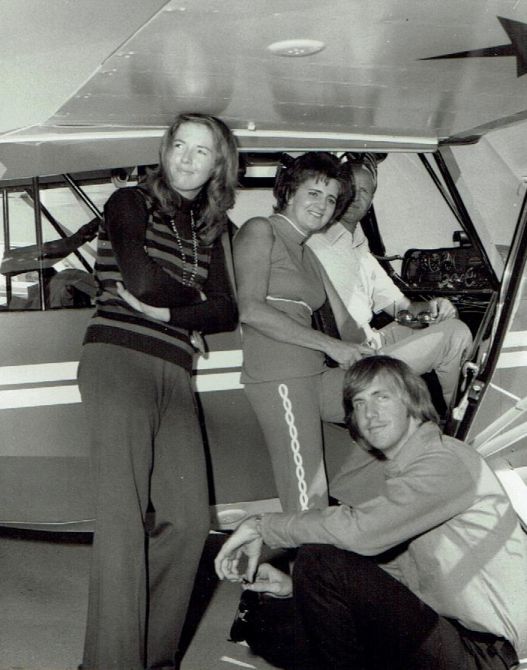
 When I left to join the Navy, Georgia and Dad bought me out. Later Dad bought out Georgia and she purchased a Smith Mini-Plane, N1G, a tiny single-seat biplane, to the right [the woman pictured is not my sister, however. This woman was the wife of the original builder circa 1968].
When I left to join the Navy, Georgia and Dad bought me out. Later Dad bought out Georgia and she purchased a Smith Mini-Plane, N1G, a tiny single-seat biplane, to the right [the woman pictured is not my sister, however. This woman was the wife of the original builder circa 1968].
"This Smith Mini Plane N1G was started in mid 1961 and was first flown on November 12, 1967 at Chino, California. It was built by Norm Ginn who operated a small company named Aircraft Spruce Co. selling spruce lumber in the early 1960's. In 1965, Norm sold the company name to Flo and Bob Irwin who began to build the business into what is today Aircraft Spruce & Specialty Company. Thus, N1G is the first homebuilt using materials from "Aircraft Spruce". Norm sold N1G in 1970, and today it is with its seventh owner in Texas. "Mom and Dad sold the Citabria later and bought a 1961 A33 Beechcraft Debonair, N1111Z. I was to get many hours flying this aircraft on my returns home. Below is a picture of the plane, with my Mother boarding it as pilot while I wait to step up as navigator. We were about to take-off on an air race, the annual Kachina Doll air rally. My Mother took part in this race a number of times, a few times with me as co-pilot, but also with my Father and Sister at other times. Sadly, while at a stop overnight in Sedona, Arizona, the airplane was caught in a hailstorm. While my Dad was able to fly it home, the cost to repair it was prohibitive and the insurance company totaled it.
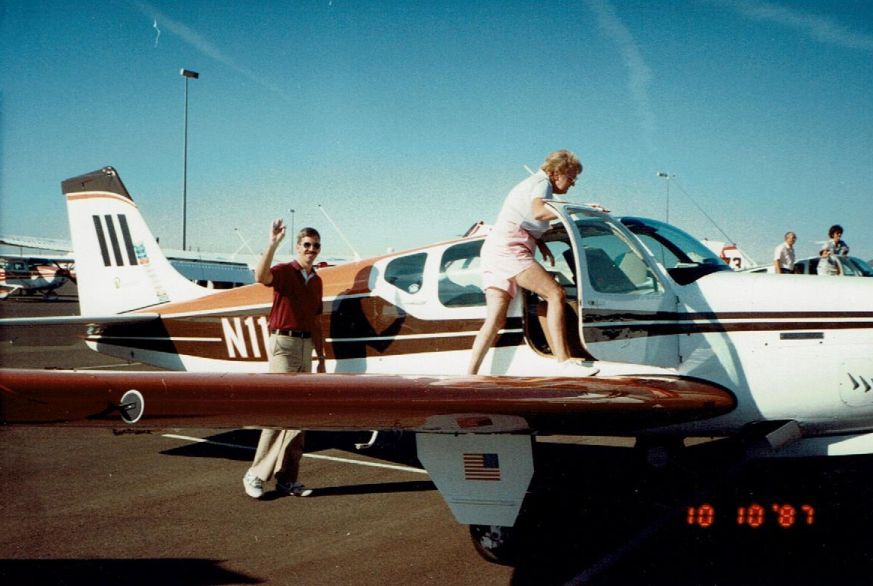
| N1111Z, the "Debby"
Sadly, the Debby was to sustain further damage. On 14 January 1996 the current owner was executing a go-around from runway 27 in Houston, Texas. At about 200 feet AGL, the engine failed. The pilot attempted a restart but was unsuccessful. The aircraft came to a stop about 1/4 mile beyond the departure end of the runway after rolling through a rough field. Inspection of the aircraft revealed no usable fuel in the left fuel tank, and the right fuel tank was full. The fuel selector was found in the right tank position. The National Transportation Safety Board determined the probable cause(s) of this accident was a loss of engine power for undetermined reasons. I've also found that the aircraft had an accident previous to my Dad owning it. On 23 July 1967 in Versailles, Missouri, while operating out of a farm strip, the pilot aborted take-off and was not able to stop the aircraft before it collided with a fence and the trees beyond. The accident was attributed to insufficient runway for the prevailing conditions. While the temperature was only 80 degrees, the grass on the field was 4 to 5 inches tall, significantly slowing acceleration. Damage was described as substantial. Today the aircraft, rebuilt and repainted, is located at Montgomery Field, San Diego from which I fly. |
My Mom and Dad used the insurance money from the Debbie to buy a 1970 V35B Beechcraft Bonanza, N4002A, a truly beautiful airplane. In the mean time, to have a simpler, cheaper airplane for local hops, my Dad joined several of his friends to buy an Aeronca Champ. Years later the group traded this airplane in on their current aircraft, a Citabria GCBC.
In the final years of their lives both my Grandma Hissem and Grandma Offerman lived with my parents in Tempe. I was gone, deployed with the Navy, when Grandma Hissem died and I missed her funeral, but I was home on leave when Grandma Offerman passed away. The family flew back to Iowa for the funeral in the Debonair, the last leg into Davenport under a quickly lowering sky and growing snow storm. I flew this leg and was happy that my folks were familiar enough with the countryside south of Davenport to be able to direct the flight based on the roads we could see underneath us.
After my Dad and Mom retired they moved to a smaller house located on the Camelot Golf course in Mesa, Arizona to be closer to the airport, as well as the golf course. Dad had a perfect retirement. Every morning he would get up early and head to the airport, or "to work" as he sometimes called it. He might make an early flight, or just work on the airplane. With the hangar open, it was a sign to the other aviators to come calling, and after a little conversation, everyone headed over to the cafe for coffee and perhaps a little breakfast. Afterwards they'd decamp to someone's hangar to help a buddy with a maintenance problem or to the administration building where they could get another cup of coffee and watch the aircraft takeoff and land, critiquing the performance. Some day's they'd get several aircraft and go out for lunch. Other times they'd stay local, but still go out in a convoy. Meanwhile my Mom played golf and took positions of authority in the local league. She also joined the 99's, writing their newsletter and in general being a ball of fire.
My Mom developed heart trouble and died, suddenly, on 15 October 2001. Her death was a terrible blow to my father. My Dad died on 3 May 2006. When he collapsed he was at the airport, surrounded by his friends. It was the way he would have wanted it to happen. Darrell and Jeanne's children are,
(27) Georgia Jean Hissem (1948)
(27) Steven Dean Hissem (1952)
Georgia was born in Iowa and, like me, went to a variety of schools throughout her young life. This included a stint at the Howard County Junior College in the year before Dad retired. At that point she entered Arizona State University and earned a Bachelors degree in Microbiology. She held a variety of positions early on, but settled into work in a local hospital on the western side of Phoenix.
She continues to live in the Phoenix are on a small ranch on the western end of the valley, underneath the White Tank mountains. Georgia married Charles Timothy Mulhern (1956). Chuck was born on 15 December 1956. They had two children.
(28) Kerry Jean-Marie Mulhern, who graduated from Arizona State University. She married Austin J. Farris on 8 April 2011.
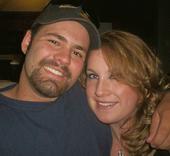 They had a daughter, Addison, and son, JD [Joshua Dean].
They had a daughter, Addison, and son, JD [Joshua Dean].

| The Mulhern Family
See Mulhern. |
| Historical Timeline: The 1970's
An era of retrenchment following the defeat in Vietnam. Politics were dominated by President Nixon and the Watergate controversy. - 1970 America began to withdraw troops from Vietnam. Bombing of North Vietnam continued.- 1973 Paris Peace Accords end the Vietnam War and Henry Kissinger won the Nobel Peace Prize. - 1976 North Vietnam invaded the south and quickly conquered our old ally. American did nothing and Henry did not return his peace prize. - 1979 Iranian protesters seized the U.S. Embassy and hold its staff hostage. A nadir in American self-confidence and prestige. |
| Historical Timeline: The 1980's
The era of Ronald Reagon and his slogan of "Its Morning in America." A huge increase in Defense spending and a policy of aggressive confrontation with the Soviets, called an "Evil Empire" by Reagon. - 1980 Soviets invaded Afghanistan.- 1981 IBM launched their personal computer establishing a new standard and significantly accelerated the home PC market. - 1983 The Compact Disc created. - 1989 The Berlin Wall fell as citizens of Berlin reject communism. |
I was born on 29 March 1952 at Luke Air Force Base, just west of Phoenix, Arizona. At the time my parents lived in the suburb of Glendale. My first memories are of living in Iowa near by Grandma Hissem, while my father was overseas with the Air Force, in Taiwan. After his return we moved to Bryan Air Force Base, near College Station, Texas. Assignments to Greenville AFB, Mississippi, and Williams AFB, Arizona, followed. My father then went overseas again, to Iceland, while the family stayed in Chandler, Arizona. On his return we moved to Webb AFB, Texas, from which Dad retired. We then moved back to Arizona, settling in Tempe, where my sister and I attended Arizona State University.
I earned a Bachelor of Science Degree in Sociology from Arizona State University (ASU) in 1973 and a Masters of Science in Systems Management from the University of Southern California (USC) in 1987, where Anita and I met, and a Certificate in Program Management from the Defense Systems Management College at Fort Belvoir, Virginia.
I married Anita Lee Montague in San Diego on 18 February 1987. Anita is the daughter of Lloyd Lee Montague, originally of Bishop, California. Lloyd is a retired Navy Captain, having served as a fighter pilot, flying the F-4U Corsair, F-6F Hellcat, AD-1 Skyraider and FJ Fury aircraft, and, later, as an Intelligence Officer. See the Wells and Montague pages for my interpretation of Anita's family background.
While working on an earlier Masters degree at ASU, that I never finished, I decided to chuck it all and join the Navy. Below is a photo from the day I signed up - nice hair huh?
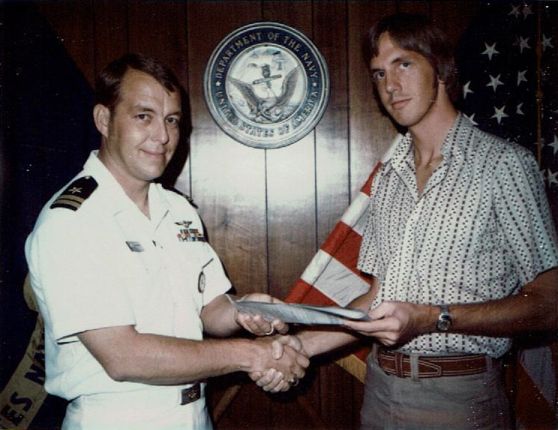
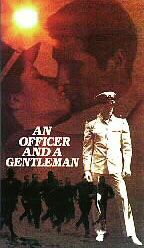 abandoned site in Washington state when the U.S. Navy refused to cooperate with the filming. While there is a lot of silliness in that movie, it is essentially correct in the behavior of the drill instructor, the climate of the school and the attitudes of the cadets, not to mention that of the local girls. I was in battalion three, class 28-75 [OOH-RAH!] and my drill instructor was Staff Sergeant Conners. Below is a photo of Battalion One. Our buidling looked the same, but on the next street over. By the way, they looked nicer on the outside than they did on the inside. I have a million stories about this period (literally!), but I won't bore you with those.
abandoned site in Washington state when the U.S. Navy refused to cooperate with the filming. While there is a lot of silliness in that movie, it is essentially correct in the behavior of the drill instructor, the climate of the school and the attitudes of the cadets, not to mention that of the local girls. I was in battalion three, class 28-75 [OOH-RAH!] and my drill instructor was Staff Sergeant Conners. Below is a photo of Battalion One. Our buidling looked the same, but on the next street over. By the way, they looked nicer on the outside than they did on the inside. I have a million stories about this period (literally!), but I won't bore you with those.
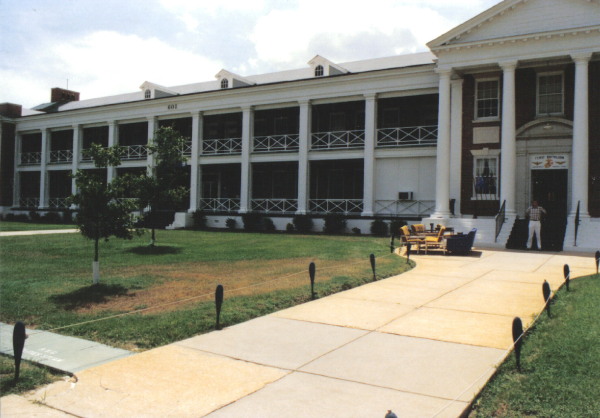
In February 1976 I was commissioned an Ensign in the United States Navy Reserve.
 Training continued after commissioning when I entered VT-10, the basic navigation school, followed by VT-86, the advanced navigation & radar school. My training was a combination of classroom, desktop trainers, simulators and flights in the T-2 and T-39 aircraft. It was in VT-86 that I was trained as a Radar Intercept Officer (RIO), that is, a backseater in Navy fighter aircraft. I earned my Naval Flight Officer 'wings' early in 1977. I remember how proud I was, but when, not long after, I was visiting with my Offerman relatives in Iowa, I was put in my place. I told my uncle Herman, a farmer, about my achievement. He paused, looked at me intently for a long moment, then said, "so, you don't farm?" I was that deflated balloon.
Training continued after commissioning when I entered VT-10, the basic navigation school, followed by VT-86, the advanced navigation & radar school. My training was a combination of classroom, desktop trainers, simulators and flights in the T-2 and T-39 aircraft. It was in VT-86 that I was trained as a Radar Intercept Officer (RIO), that is, a backseater in Navy fighter aircraft. I earned my Naval Flight Officer 'wings' early in 1977. I remember how proud I was, but when, not long after, I was visiting with my Offerman relatives in Iowa, I was put in my place. I told my uncle Herman, a farmer, about my achievement. He paused, looked at me intently for a long moment, then said, "so, you don't farm?" I was that deflated balloon.
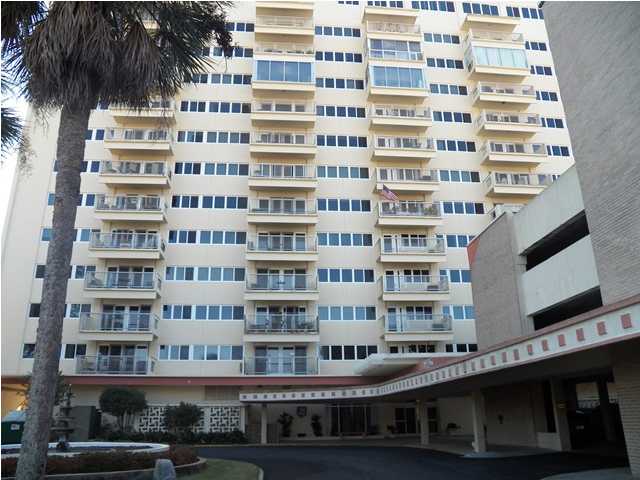 After commissioning I had moved into the Bachelor Officers' Quarters (BOQ) on base for a short time. There I lived the last vestiges of an old system : a "closed" Mess that provided great chow, a room maintained by an obsequious staff, and just a hint of, dare I say it, a privileged, almost colonial past. Then it all went away. I moved out into town to an apartment with my buddy, Scott Graves, who had commissioned in the class before me. We lived in a high-rise on Pensacola Bay, at the Bayshore Apartments, pictured at the right. This is now a condominium. We lived the high life for awhile, waiting for our training start date, with lots of pool and beach time, quaffing down quite a few Pina Colada's in the process. We chased the ladies of Pensacola, and Scott caught one.
After commissioning I had moved into the Bachelor Officers' Quarters (BOQ) on base for a short time. There I lived the last vestiges of an old system : a "closed" Mess that provided great chow, a room maintained by an obsequious staff, and just a hint of, dare I say it, a privileged, almost colonial past. Then it all went away. I moved out into town to an apartment with my buddy, Scott Graves, who had commissioned in the class before me. We lived in a high-rise on Pensacola Bay, at the Bayshore Apartments, pictured at the right. This is now a condominium. We lived the high life for awhile, waiting for our training start date, with lots of pool and beach time, quaffing down quite a few Pina Colada's in the process. We chased the ladies of Pensacola, and Scott caught one.
Once our training began things began to move pretty quickly. I'll admit that I found VT-86 a tough school and I had some difficulty translating the 2 dimensional presentation of our primitive and very weak radar into a spatial picture of the intercept problem.
I then received orders to VF-121, the training squadron, or Replacement Air Group (RAG), for the F-4J Phantom fighter aircraft. The squadron was located at Naval Air Station (NAS) Miramar in San Diego, California. This was my first visit to the city in which I would eventually retire. The F-4 was the first "grey" airplane I got to fly in; that is, it was a combat jet, not a training command airplane, which were painted white. It was also huge. My first pre-flight was daunting.
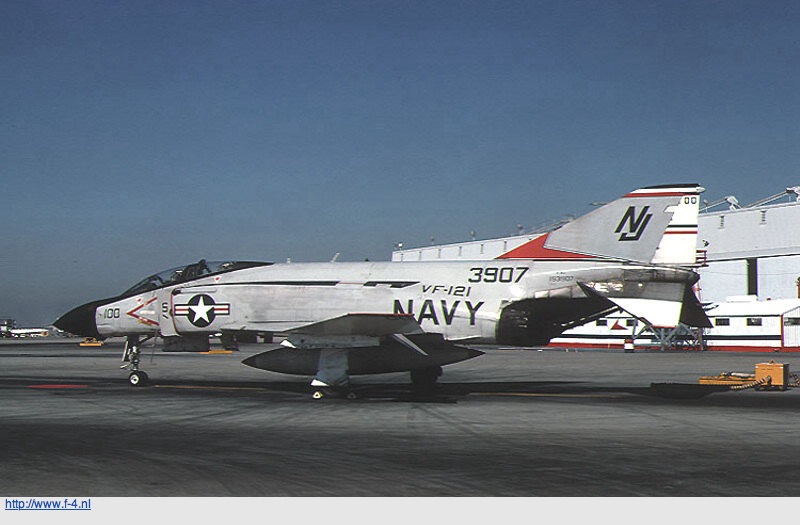

After a quick six months I finished training at the RAG and, to my shock, was ordered to VF-161, the Rock Rivers, onboard the USS MIDWAY in Yokosuka, Japan. Two excellent web sites for this ship are at CV41 and USS MIDWAY. Interestingly, that ship, now decommissioned, is docked in San Diego as a tourist attraction. My youngest son had his Eagle ceremony onboard. Below is a photo of the MIDWAY at it's pier on Yokosuka Bay. Most of the destroyers in this picture are of the Japanese Navy.
While the ship and airwing were very good, and worked better together then any I served with later in my career, I can't say I loved this tour. Yokosuka was a cold and dreary place, very industrial; I was a bachelor, forced to live onboard the ship for the entire 2 1/2 years I was there, with little night life and few date-able women outside the few Department of Defense school teachers, who had to fight off the men.
Below is a photo of the "Honch," the entertainment sector outside the front gate. I can honestly say I only went there when I was on duty with the Shore Patrol.

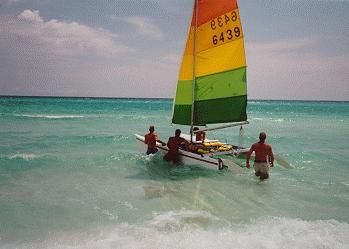 After that tour I received orders, in 1980, to become an instructor at VF-171, the East Coast F-4 RAG at NAS Oceana, Virginia. While living in the "party town" of Virginia Beach, I bought a Hobie 16 sailboat, like the one pictured to the left. A friend and I sailed it in the Atlantic for many years. The night life here was a better fit for a bachelor and, as a military town, geared to a young naval aviator.
After that tour I received orders, in 1980, to become an instructor at VF-171, the East Coast F-4 RAG at NAS Oceana, Virginia. While living in the "party town" of Virginia Beach, I bought a Hobie 16 sailboat, like the one pictured to the left. A friend and I sailed it in the Atlantic for many years. The night life here was a better fit for a bachelor and, as a military town, geared to a young naval aviator.
After many years out of general aviation, I bought a Stolp Starduster II, a two-place, open-cockpit biplane. My father found it for me at Falcon Field, in Mesa, Arizona. That's it below, in a photo taken at Deer Valley airport, about two years before I bought the plane. I flew it back to the east coast (that's a long story best told over a beer) and based it at Portsmouth, Virginia.

While I enjoyed being an instructor, when a position came open, I volunteered to go back to sea duty early and received orders to VF-21 in San Diego. I flew the Starduster from Virginia to San Diego while a British officer I knew from the squadron on exchange duty and his wife drove my car west on a vacation, sightseeing throughout the country. At the time VF-21 was flying the old F-4N, an updated version of the F-4B aircraft used during the Vietnam War. We deployed onboard the USS CORAL SEA, CV-43, and made an around-the-world cruise in 1984. The lowpoint came early in the cruise when cracks were found in the wings of our aircraft. The aircraft had to be flown off to a depot repair facility in the Philippines to be patched. It wasn't all bad because I was the officer-in-charge of the detachment. The highlight of the cruise was our passage through the Suez Canal into the Med, with a stop in Cannes, France. I never knew how good the LANT fleet sailors had it on liberty!
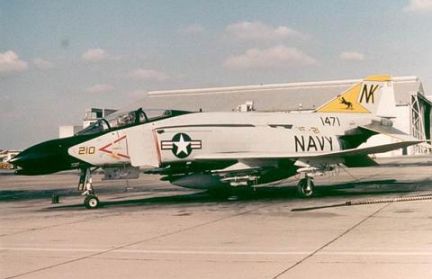
After an around-the-world cruise on the old USS CORAL SEA, the squadron transitioned to the F-14A Tomcat fighter. Following training at VF-124 at NAS Miramar, Roger Boenighausen, the Commanding Officer, and I went to Long Island to pick up one of the fighters fresh off the production line at Grumman and flew it back to San Diego.

In 1985 I was selected, along with pilot John Conkey, to go to the Navy Fighter Weapons School, TOPGUN. While "An Officer and a Gentleman" did accurately mirror  much of what went on at AOCS, the movie "Topgun" was wildly inaccurate in almost every detail. One of the few true things about it was that there was a Kelly McGillis-type character who analyzed combat engagements and crunched numbers. She did not, however, have such a central role. There was no top-crew award, the very idea of which was anti-thetical to the squadron's mission, and we didn't take steamy showers together after our flights. There was one good thing to come out of the movie, though. When someone asks what a RIO is, the answer is now simple: "Its Goose! The funny guy in the backseat who died when he ejected."
much of what went on at AOCS, the movie "Topgun" was wildly inaccurate in almost every detail. One of the few true things about it was that there was a Kelly McGillis-type character who analyzed combat engagements and crunched numbers. She did not, however, have such a central role. There was no top-crew award, the very idea of which was anti-thetical to the squadron's mission, and we didn't take steamy showers together after our flights. There was one good thing to come out of the movie, though. When someone asks what a RIO is, the answer is now simple: "Its Goose! The funny guy in the backseat who died when he ejected."
In 1985 the squadron deployed on the USS CONSTELLATION. During that cruise, and the work-ups leading to it, I was in charge of training and the creation of new Maritime Air Superiority tactics utilizing the F-14 and new F/A-18 aircraft. For those efforts I was selected the Pacific Fleet Naval Flight Officer of the Year in 1985. In a career you receive many awards, earned and unearned. Of this one, and the medal that went with it, I am quite proud.
 While on deployment, off the Kamchatka penisula, I and my pilot, Pete Romaneski, got a chance to tangle with Soviet Combat Air Patrol aircraft, some really pretty MIG-23's, who were guarding their airspace. They were fairly aggressive, the number two man trying to maneuver to our six [which we prevented], but when our wingman showed up they turned quite tame.
While on deployment, off the Kamchatka penisula, I and my pilot, Pete Romaneski, got a chance to tangle with Soviet Combat Air Patrol aircraft, some really pretty MIG-23's, who were guarding their airspace. They were fairly aggressive, the number two man trying to maneuver to our six [which we prevented], but when our wingman showed up they turned quite tame.
Heading back to shore duty in 1985 I was assigned to VF-126, the Bandits, an adversary squadron at Miramar. They flew F-5's and A-4's, and later F-16N's, and played the 'bad-guys' to the RAG and Fleet Squadrons. Utilizing Soviet tactics they helped Navy squadrons hone their skills against the most realistic opposition available. I was able to get quite a bit of stick time in the squadron's TA-4J's, like the one below. These were also used in the adversary mission, though of course they had less oomph that a single seat A-4F. I got to be pretty good at ACM (Air Combat Manuevering), or dogfighting, and took the opportunity to  make my own Atoll kill's (including on Squatty, an old squadron mate from VF-21). The squadron also flew the T-2, teaching pilots how to recognize and recover from spins. Randy Cunningham, the Navy's only Ace in the Vietnam War, was the commanding officer of the squadron (yes, he went to Congress and embarassed himself, winding up in jail). I was the Maintenance Officer of the squadron.
make my own Atoll kill's (including on Squatty, an old squadron mate from VF-21). The squadron also flew the T-2, teaching pilots how to recognize and recover from spins. Randy Cunningham, the Navy's only Ace in the Vietnam War, was the commanding officer of the squadron (yes, he went to Congress and embarassed himself, winding up in jail). I was the Maintenance Officer of the squadron.
While at VF-126 I took the opportunity to go back to school, earning a Masters degree from the University of Southern California. It was during one of these early classes that I met my wife-to-be, Anita Lee Montague. We were married on 18 February 1987. In 1989 my son Jeffrey was born. Anita is the daughter of Lloyd Lee Montague and Virginia Bassett.
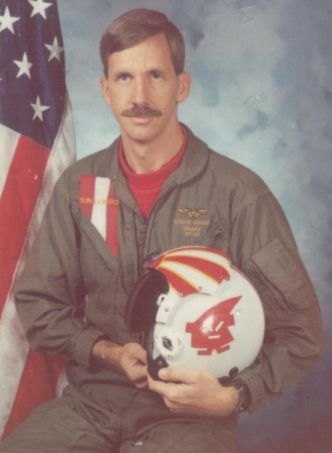 I was originally ordered to VF-194 after my tour in VF-126, but when that squadron was abolished I was rather suddenly sent to VF-111, the Sundowners. They deployed on the USS CARL VINSON in 1989. Around this time I sold the Starduster; as a father of two young boys I didn't have the time to fly it anymore.
I was originally ordered to VF-194 after my tour in VF-126, but when that squadron was abolished I was rather suddenly sent to VF-111, the Sundowners. They deployed on the USS CARL VINSON in 1989. Around this time I sold the Starduster; as a father of two young boys I didn't have the time to fly it anymore.
 In 1990 I was sent to the Pentagon where I was assigned to the Office of the Assistant Secretary of the Navy for Research, Development and Acquisition. I became an action officer for Air-to-Ground ordnance, Unmanned Aerial Vehicles, and the Harpoon and Tomahawk missiles. At the end of my tour I was sent to the Program Manager's course at the Defense Systems Management School at Fort Belvoir, Virginia. My son Timothy was born at the hospital at Fort Belvoir in 1990.
In 1990 I was sent to the Pentagon where I was assigned to the Office of the Assistant Secretary of the Navy for Research, Development and Acquisition. I became an action officer for Air-to-Ground ordnance, Unmanned Aerial Vehicles, and the Harpoon and Tomahawk missiles. At the end of my tour I was sent to the Program Manager's course at the Defense Systems Management School at Fort Belvoir, Virginia. My son Timothy was born at the hospital at Fort Belvoir in 1990.
I returned to San Diego in 1993 to be the Weapons Department Head onboard the USS KITTY HAWK, based at NAS North Island. After returning from a deployment in 1995 I transferred to my final Navy tour, as Executive Officer at the Fleet Air Control & Surveillance Facility (FACSFAC) San Diego, also located at NAS North Island.
In March 1999 I retired from the Navy [I still can't believe I'm not in the Navy anymore] as a Commander after almost 24 years of service. I had over 3000 flight hours and 800 carrier arrestments. In all that time, however, I never got any 'green ink' in my flight log. In the log book black ink is used for day flights, red for night flights, while green is reserved for combat missions.
| Squadron Patches
Every squadron in the Navy, and in the world for that matter, has a squadron insignia and a patch normally worn by its personnel. The following are those I wore and still have on my flight jacket. By the way, every one of these squadrons has been disestablished (it wasn't my fault). 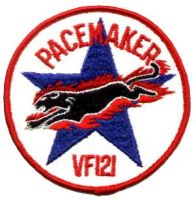 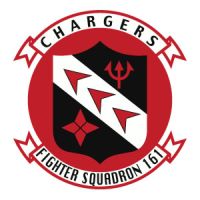 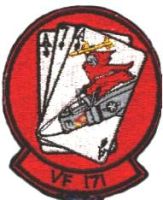 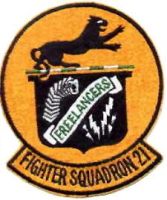 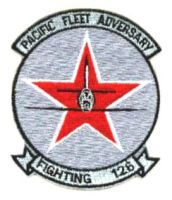 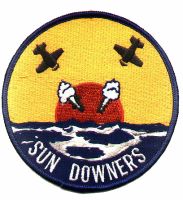 Pilots and NFO's in the Navy also all have nicknames. For pilots this is their radio call sign. My nickname was 'Snake,' though while in VT-86 it was 'Achmed.' During the time when I was in training in that squadron the Shah of Iran was still in power and he sent his pilots and NFO's to the Navy to train to fly his F-14's. Before the instructors at VT-86 had seen me they saw my name and assumed my last name, looking middle-Eastern, must mean I was an Iranian student and initially assigned me to one of their classes, which were separate. The mistake was discovered quickly, but not before my friends found out about it and dubbed me 'Achmed Mohammed Hissem.' |
I now work for the Anteon corporation (then OSEC, Apogen, QinetiQ, and now Booz-Allen-Hamilton) as contract support to Shipboard Installations at the Space & Naval Warfare Systems Command (SPAWAR), in San Diego, below.

Anita and I live in the north county, in the suburb of Rancho Bernardo, just south of Lake Hodges.
In 2006 I couldn't stand renting Cessna's from the local club anymore and bought a 1/2 share in a Mooney 201, below, based at Montgomery Field, in San Diego. She's a beauty to fly, fast and solid, yet surprisingly docile in the landing pattern. I also recently picked up an Instrument license to more fully utilize the Mooney's capabilities - I went to the Sheble school in Kingman, Arizona, but that's another story to share over a beer. I've since discovered that the Mooney is an excellent instrument platform, and extremely stable on final.

| Historical Timeline: The 1990's
An era of ever increasing prosperity. The last decade of the Twentieth Century was dominated by the fall of the Soviet Union and the rejection of communism around the globe, with the exceptions of Cuba and North Korea. The Age of Information came to maturity. American politics in the last half of the decade were dominated by petty sex scandals. - 1990 Iraq invaded Kuwait. America created a world-wide coalition to drive out the Iraqi's in "Operation Desert Storm."- 1991 the Soviet Union officially ceased to exist as the nation split into a number of smaller countries. - 1992 the World Wide Web began to impact the way we use computers. |
| Historical Timeline: The Twenty-First Century
America's position as the world's sole super-power uncontested. Terrorism, the warfare of the weak, took center stage as the Arab-Muslin world sought to redress their grievances. - 2001 The twin towers of the World Trade Center were destroyed in a terrorist attack. Afghani Taliban government attacked after refusing to extradite Osama bin Laden and the Al-Quede terrorist network.- 2003 Iraqi regime of Saddam Hussein deposed in Desert Storm reprise. |
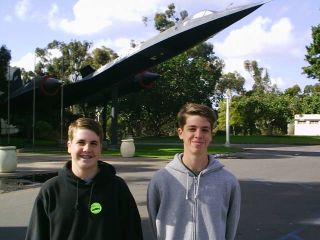
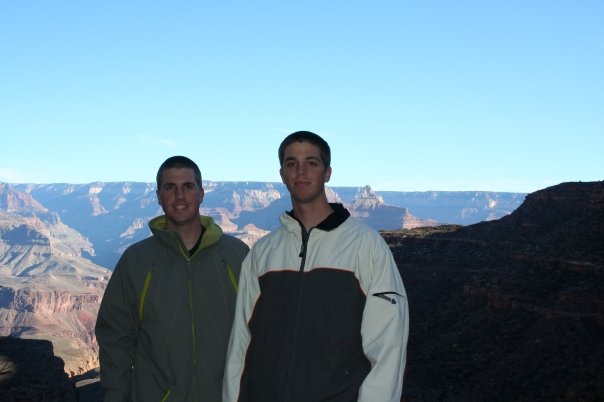
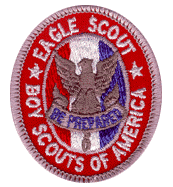 (15) Raphe Hesome (c1550)
(16) William Hesome (c1577)
(17) George Hesom (c1600)
(18) John Heesom (1650)
(19) Unknown Heesom (c1687)
(20) Thomas Hesom/Hissom/Heysham (c1720)
(21) David Heysham/Hissam (1762)
(22) Jesse Hissam (1795)
(23) Abner Hissam (1830)
(24) Arthur W. Hissem (1866)
(25) Leo Worth Hissem (1891)
(26) Darrell Dean Hissem (1924)
(27) Steven Dean Hissem (1952)
(15) Raphe Hesome (c1550)
(16) William Hesome (c1577)
(17) George Hesom (c1600)
(18) John Heesom (1650)
(19) Unknown Heesom (c1687)
(20) Thomas Hesom/Hissom/Heysham (c1720)
(21) David Heysham/Hissam (1762)
(22) Jesse Hissam (1795)
(23) Abner Hissam (1830)
(24) Arthur W. Hissem (1866)
(25) Leo Worth Hissem (1891)
(26) Darrell Dean Hissem (1924)
(27) Steven Dean Hissem (1952)
Jeff was born on 7 February 1989 at Sharp Hospital in San Diego, California and named for his maternal grandfather, Lloyd Montague.
In 1990 we moved to Springfield, Virginia while I worked at the Pentagon. In 1993 we moved back to San Diego, California where Jeff grew up, attending Westwood Elementary, and Rancho Bernardo Middle School and High School.
Jeff was a Boy Scout in Troop 685, attaining the rank of Eagle Scout. He was twice Senior Patrol Leader of his troop, a member of the Order of the Arrow, scouting's honor society, and chief of his local chapter. As an adult, he was an Assistant Scout Master for Troop 685.
Jeff attended San Diego State University, majoring in Computer Engineering.
Jeff is in the Air Force and stationed at Shriever Air Force Base in Colorado Srings where he specializes in computer techology.
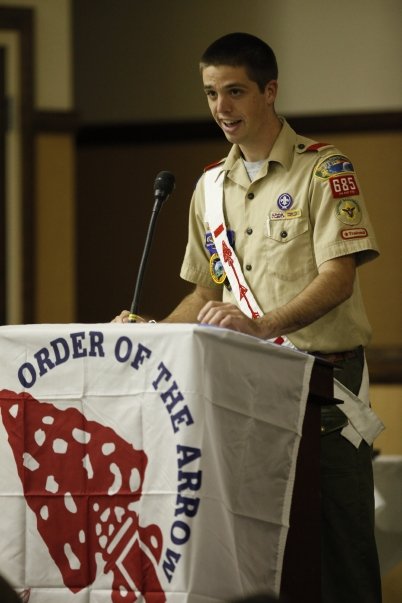

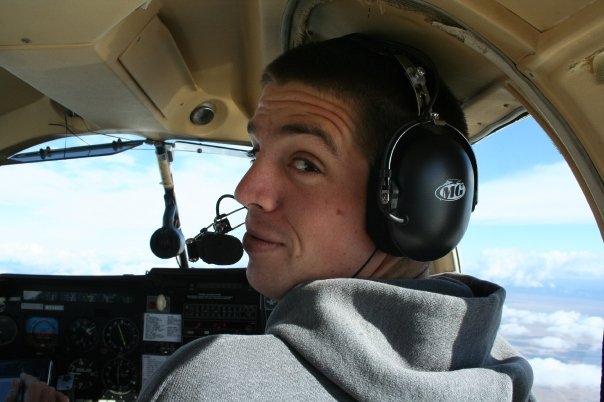
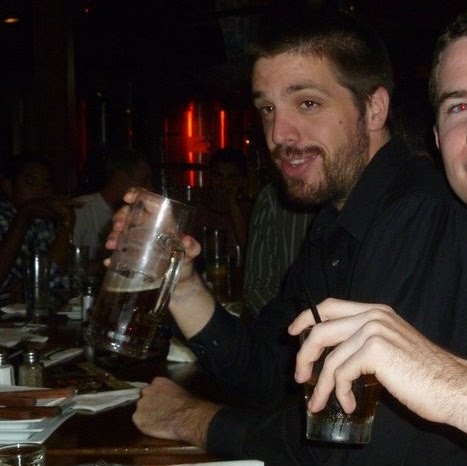
Jeff is now a Master Sergeant (E-7). After a tour at Fairchild AFB in Spokane, Washington he was assigned an overseas tour for NATO in metropolitan London, England. He recently earned a degree in Cybersecurity and Information Assurance from Western Governors University.
In 2024 he married Stephanie Sawyer.
(28) Timothy Darrell Hissem (1990)  Tim was born on 11 April 1990 at Fort Belvoir, Virginia, just south of Washington D.C, and named for his paternal grandfather, Darrell Hissem.
Tim was born on 11 April 1990 at Fort Belvoir, Virginia, just south of Washington D.C, and named for his paternal grandfather, Darrell Hissem.
In 1993 we moved back to San Diego, California where Tim grew up, attending Westwood Elementary, and Rancho Bernardo Middle School and High School.
 Tim was a Boy Scout in Troop 685, attaining the rank of Eagle Scout. He was a member of the Order of the Arrow, scouting's honor society, where he was Chief of the Tiwahe Lodge of San Diego and Imperial counties, and, as an adult, an Assistant Scout Master for Troop 685. His Eagle project was the construction of a trail and drainage "lens" on Lake Hodges, below, just north of our home in Rancho Bernardo.
Tim was a Boy Scout in Troop 685, attaining the rank of Eagle Scout. He was a member of the Order of the Arrow, scouting's honor society, where he was Chief of the Tiwahe Lodge of San Diego and Imperial counties, and, as an adult, an Assistant Scout Master for Troop 685. His Eagle project was the construction of a trail and drainage "lens" on Lake Hodges, below, just north of our home in Rancho Bernardo.

Tim graduated from the University of California at Riverside, with a bachelors degree in Geo Science Education. He was a member of the Army ROTC and was commissioned a 2nd Lieutenant upon his graduation from university. As you can tell from the photo below, taken on an ROTC field exercise, Tim is the youngest.
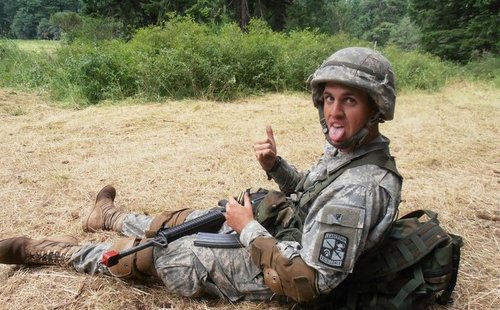
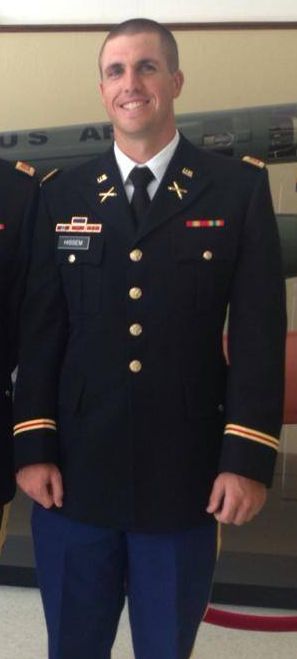
 Tim is now a 1st Lieutenant in the Artillery. He is currently stationed at Fort Polk, in Leesville, Louisiana. Oddly, he's in the 10th Mountain Division, though I know of no mountais in Louisiana.
Tim is now a 1st Lieutenant in the Artillery. He is currently stationed at Fort Polk, in Leesville, Louisiana. Oddly, he's in the 10th Mountain Division, though I know of no mountais in Louisiana.
At the tail end of 2014 Tim went through Ranger training, completing the course, and earning the Ranger tab, right, in January 2015. Tim expects to deploy to Afghanistan in December.
On 2 July 2015 Tim and Alyssa Alvarado married in Leesville, Louisiana. Tim has just been selected for Captain and is currently the Executive Officer for Battery C, 5th Battalion, 25th Field Artillery Regiment, 3rd Brigade Combat Team, 10th Mountain Division (Light Infantry), Fort Polk, Louisiana. That's a mouthful . . .
Circa 2021, Tim is stationed at Schofield Barracks. He and Alyssa live in Ewa Beach.
Tim and Alyssa subsequently divorced.
He was promoted to Major in 2024 and is now at Fort Lewis in Tacoma, Washington. He is waiting for orders to a school at Fort Belvoir, Virginia that will usher him into a new field, Force Management. That's the term the Army uses for designing what the future Army should look like. He has follow-on orders to the Fifth Corps at Fort Knox, Kentucky.

Herbert Lozelle Hissem, the son of Leo Worth Hissem and Lena May Six, was born on 4 October 1929 in Iowa, presumably in Milton. In the 1930 census of Milton, Jackson township, Van Buren county, Iowa as Herbert R. [sic] Hissem, 6/12. In the 1940 census of Milton, Jackson township, Van Buren county, Iowa as Lozelle Hissem, 10. He had by this time had six years of education. He was living with his grandmother, Lucy [Orr] Six, a 75 year old widow. He had also been living with her in 1935. I remember my father saying that his sister, Alice, lived with their Six grandparents at some point, apparently because there wasn't room in the Hissem house. However, Lozelle was also listed in the same census as living with his parents, Leo and Lena, and brothers, Gerald [sic] and Darrell. Here it claims that Lozelle had just five years of education.
Herbert L. Hissem graduated from Milton High School in 1947.
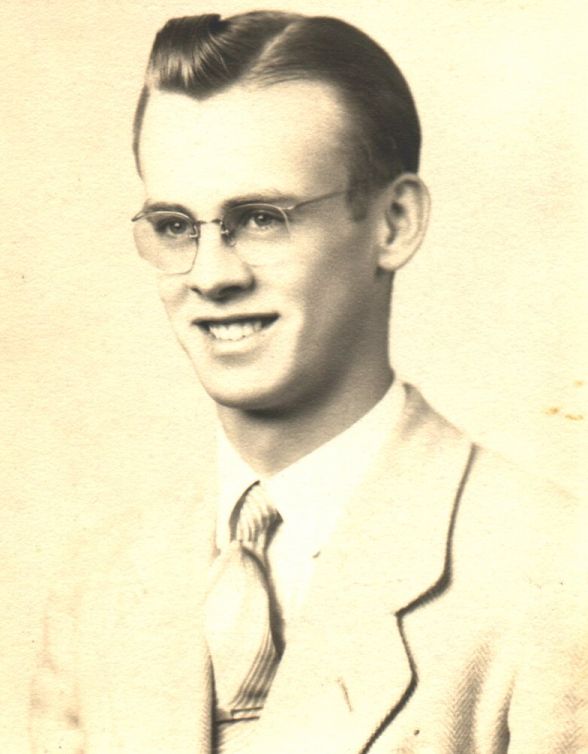
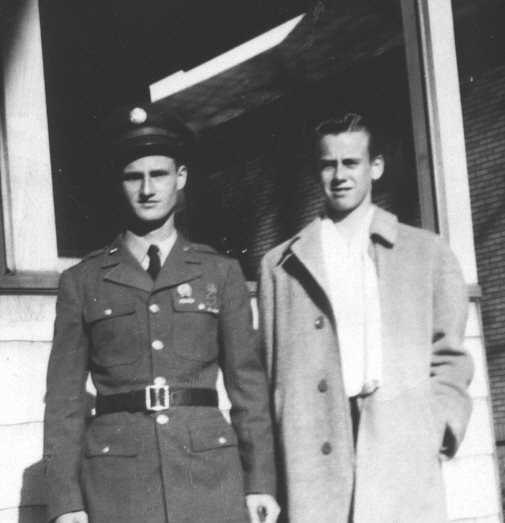 Originally known as Herb, "Lozie" (the Depression made the name Herbert [Hoover] unpopular) served in the US Army Air Force following WW II after having been recruited by his older brother, Darrell. I believe the photograph at the right, of my father, Darrell, and Lozelle, was taken at about this time.
Originally known as Herb, "Lozie" (the Depression made the name Herbert [Hoover] unpopular) served in the US Army Air Force following WW II after having been recruited by his older brother, Darrell. I believe the photograph at the right, of my father, Darrell, and Lozelle, was taken at about this time.
Herbert Lozelle Hissem married Laura Joan Vincent on 9 November 1950 in Guadalupe, Texas - from "Texas County Marriage Records, 1837-1965"
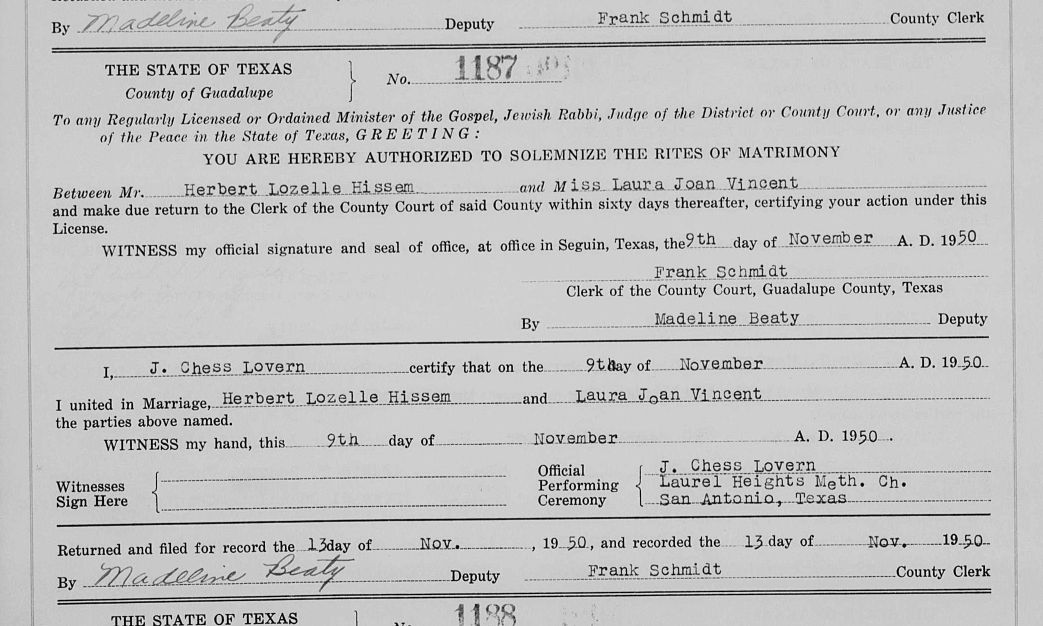
Guadalupe county is just east of San Antonio. Randolph Air Force Base is located there, while Lackland Air Force Base is to the west, on the other side of San Antonio.
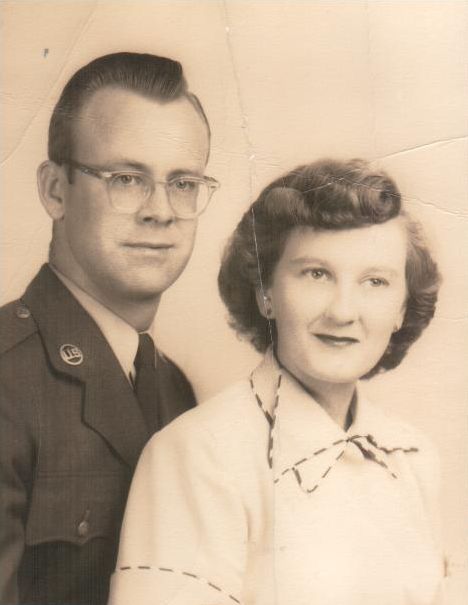
I believe Laura was the daughter of Earl Louis [or Lewis Earl] Vincent, who was born on 6 Febraury 1892 in Plainville, Illinois, and Laura [Schneider?]. They lived in Fort Madison, Lee county, Iowa [where Lozelle was later buried]. Laura Jo was born circa 1933 per the 1940 census. Her siblings were Earl, Harold and Billie. Laura appears to be in the 1948 Fort Madison High School yearbook.
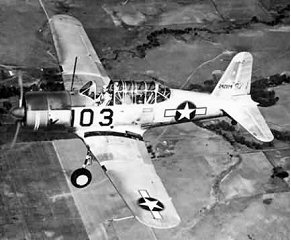 Like his older brother, Darrell, Lozelle loved flying and was a licensed pilot. At one time he owned a war surplus Consolidated Vultee trainer, like the one at left. Below is a photo of Lozelle, Laura and Keating.
Like his older brother, Darrell, Lozelle loved flying and was a licensed pilot. At one time he owned a war surplus Consolidated Vultee trainer, like the one at left. Below is a photo of Lozelle, Laura and Keating.
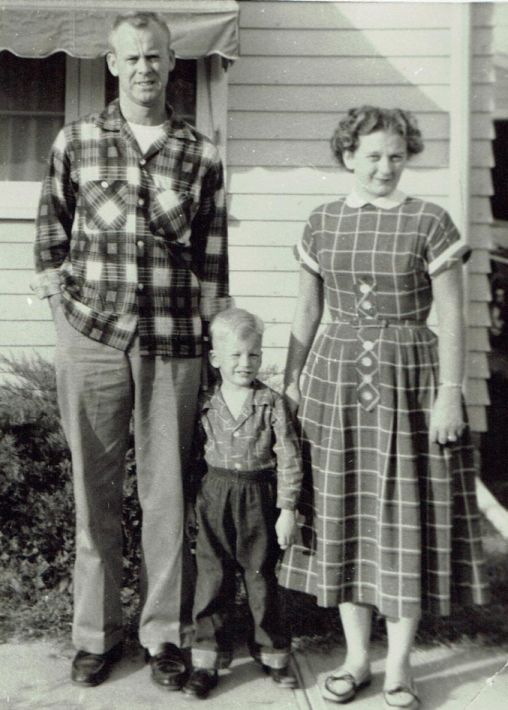
Lozelle's cousin, Richard Six, remembers him last as an Air Policeman at Lackland Air Force Base.
In 1957 Lozelle was diagnosed with cancer and discharged from the Air Force. Despite no longer being in the military he would have received treatment for any disability or illness contracted while in the service. Lozelle died of cancer on 7 September 1957, aged 27, at Fort Madison, Lee county, Iowa. Fort Madison, named for an early 19th century fortification, was where Laura's parents lived. Lozelle's obituary,
"H. L. Hissem Dies at 27
Herbert Lozelle Hissem, 27, 808 Twenty-ninth street, died Saturday at 8 p.m. in Sacred Heart hospital. He had been ill for several months.
Born Oct. 4, 1929, at Milton, he was married to Laura Joan Vincent on Nov. 9, 1950, at San Antonio, Texas. He had lived in Fort Madison since last March when he was discharged from the Air Force with the rank of technical sergeant. During his nine years military service, he was stationed in Texas and Korea. The deceased belonged to the Santa Fe Methodist church and the Izaak Walton League.
Surviving are his widow; one son, Keating, at home; his mother, Mrs. Lena Hissem, Davenport; two brothers, Darrell, Bryan, Texas, and Garrell, Fort Hood, Texas; one sister, Mrs. C. I. (Alice) Rogers, Des Moines." - from the "Fort Madison Democrat" of 5 September 1957
Lozie was buried in the Oakland cemetery, Fort Madison, Lee county, Iowa. His son was Keating.
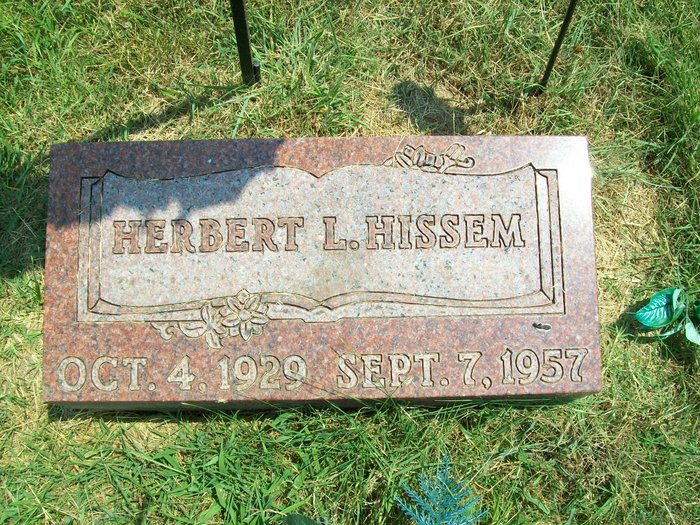
Laura subsequently married Roger Cooper.
 (15) Raphe Hesome (c1550)
(16) William Hesome (c1577)
(17) George Hesom (c1600)
(18) John Heesom (1650)
(19) Unknown Heesom (c1687)
(20) Thomas Hesom/Hissom/Heysham (c1720)
(21) David Heysham/Hissam (1762)
(22) Jesse Hissam (1795)
(23) Abner Hissam (1830)
(24) Arthur W. Hissem (1866)
(25) Leo Worth Hissem (1891)
(26) Herbert Lozell Hissem (1929)
(15) Raphe Hesome (c1550)
(16) William Hesome (c1577)
(17) George Hesom (c1600)
(18) John Heesom (1650)
(19) Unknown Heesom (c1687)
(20) Thomas Hesom/Hissom/Heysham (c1720)
(21) David Heysham/Hissam (1762)
(22) Jesse Hissam (1795)
(23) Abner Hissam (1830)
(24) Arthur W. Hissem (1866)
(25) Leo Worth Hissem (1891)
(26) Herbert Lozell Hissem (1929)
Keating Lin Hissem, the son of Herbert Lozelle Hissam and Laura Joan Vincent, was born on 22 September 1952 in San Antonio, Bear county, Texas. I believe that was at Lackland Air Force Base. I remember Keating from the 1950's when we'd meet at the Orphanage where Grandma Hissem worked. He, I and Shawn Rogers, Aunt Alice's son, would "hang," as they say today. I remember little of what we did, but near my grandmother's cottage was a low fence made of round steel tubing. We competed to see who could walk along the top of the fence the longest. I never saw Keating again after Uncle Lozelle died.
Keating attended High School in Fort Madison, Iowa. Keating in a 1970 school year book photograph, age 16, is pictured to the right.
Keating married Janet Lynn Dains. Janet was born on 16 June 1957. Today they live in Montrose, Iowa. This is a small town on the Mississippi river in Lee county, population: 957.
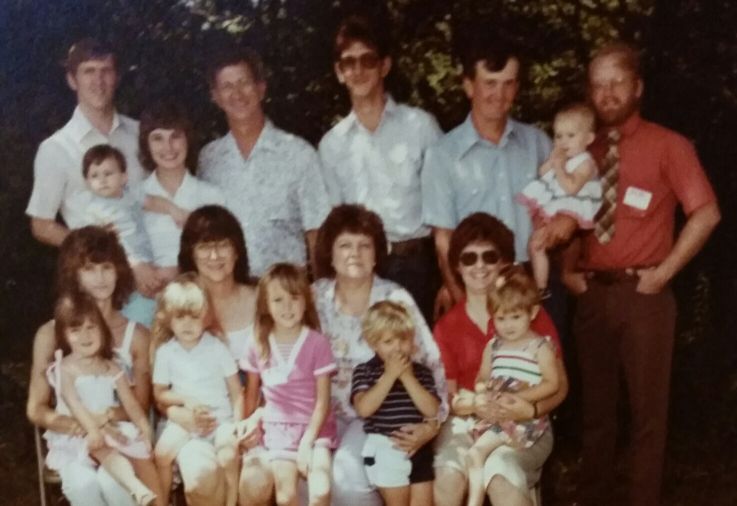
His children are,
(28) Heather L. Hissem (1977)
(28) Jeremy Lozelle Hissem (1980)
(28) Kelsey Rae Hissem (1981)
Heather L. Hissem was born on 31 July 1977. Heather attended Culver-Stockton College and is now a teacher at Clark County R-1 Schools in Kahoka Missouri. She married Matt Fuger and lives in Argyle, Iowa. Argyle is a small town midway between Fort Madison and Keokuk, near the Missouri border. Heather has a daughter, Lilly. Heather wrote in November 2006:
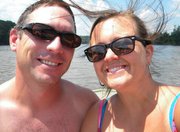
"Hello Family,". . . I just wanted to let you know that I teach at Clark County R-1 Schools in Kahoka Missouri. I sing semi-professionally at weddings, church, and corporate events. I have a daughter Lily Noel Fuger born December 5, 1998. My husband is Matthew Scott Fuger. We now have a son named Keating Matthew Fuger after my dad Keating Lin Hissem. He was born on September 27, 2004. We are a very close knit family that enjoys yearly camping trips together. We still live in rural Argyle. My husband owns a construction company. Lily, myself, and my dad sing (I direct and sing) in a yearly show called the DEC Hands in Donnellson Ia. We raise money through ticket sales and contributions to help those in need in the community.
Kelsey Rae Hissem is living in DesMoines and is a manager of a T-Mobile store.
Jeremy Lozelle Hissem married Kelli Lynn Cecil and they had a daugher Kinsey Lynn Hissem on August 20, 2005. Kelli is a dental hygienist and Jeremy still teaches at Lone Tree and coaches baseball and wrestling and is pursuing a Masters in Education Administration.
Dad (Keating Lin Hissem) works at Griffin Wheel in Keokuk IA as an Lubrication Specialist. He has worked there for 30 years in April. He enjoys fishing, playing his guitars and singing as well as playing with his grandkids. Janet Lynn (his wife) babysits Keating Fuger and enjoys time spent with family as well.
. . . My son (Keating Matthew Fuger) looks almost identical to my grandfather (Herbert Lozelle Hissem) and the picture on this site was uncanny. Thanks for your work preserving our history!
Heather Fuger"
Heather's Facebook page says she works at Central Lee Community Schools, where she attended high school as a child. She got her undergraduate degree at Culver-Stockton College in Elementary Education and studied Educational Administration at William Woods University. She lives in Argyle, Iowa.
 (28) Jeremy Lozelle Hissem (1980)
(28) Jeremy Lozelle Hissem (1980)Jeremy L. Hissem was born on 1 September 1980. Of Montrose, Iowa. He went to Central Lee High School and then attended and graduated from Culver-Stockton college in Canton, Missouri as an Elementary Education major. A Member of the Psi Chi National Honor Society in Psychology. He played college baseball where he appears to have played left/right field. He also appears to be musical, being an amateur singer.
Jeremy taught for a year at Clark County High School in Kahoka, Missouri and is now a mathematics teacher and a coach of the wrestling team at the Lone Tree Middle School in Iowa.
A biography for a school website: "Mr. Hissem is a 2003 graduate of Culver Stockton College in Canton, Missouri. He will be graduating in December 2007 from Drake University with his Master's Degree in Educational Leadership. This is his fourth year here at Lone Tree and his fifth year teaching. Currently he teaches Algebra I, Pre-Algebra, 7th Grade Math and Consumer Math. He is also junior high and high school wrestling coach and the head baseball coach. He and his wife, Kelli, live in Lone Tree with their beautiful two-year old daughter, Kinsey and are expecting their second child in June."
Kinsey Lynn Hissem (2006)Kaylin Hissem (2009)
(28) Kelsey Rae Hissem (1981)
 Kelsey Rae Hissem was born on 1 September 1981. Of Montrose, Iowa. She attended Culver-Stockton college. A singer, like Jeremy, she was a lyric-soprano in the Opera Workshop. In 2003 she was the Manager of the Family Video store in Fort Dodge, Iowa, and later a financial advisor at Wells Fargo, in Mount Pleasant, Iowa.
Kelsey Rae Hissem was born on 1 September 1981. Of Montrose, Iowa. She attended Culver-Stockton college. A singer, like Jeremy, she was a lyric-soprano in the Opera Workshop. In 2003 she was the Manager of the Family Video store in Fort Dodge, Iowa, and later a financial advisor at Wells Fargo, in Mount Pleasant, Iowa.
| Culver-Stockton College
Located on a bluff overlooking Canton, Missouri, on the Mississippi river, this is a private, residential, four-year liberal arts college affiliated with the Christian Church (Disciples of Christ). |
Kelsey Rae Hissem, 29, the daughter of Keating and Janet Hissem of Montrose, and Benjamin Dorren Summers, 26, the son of Doug and Becky Summers of Hamilton, Illinois, were married on 13 August 2011 in Fort Madison. Both were of Des Moines, Iowa. Kelsey is a broker at TIAA-CREF in Ames, Iowa.
(25) Gladys Opal Hissem (1902)Gladys Hissem, the daughter of A. W. Hissem and Tilla Haney, was born on 21 October 1902 in Union township, Davis county, Iowa.
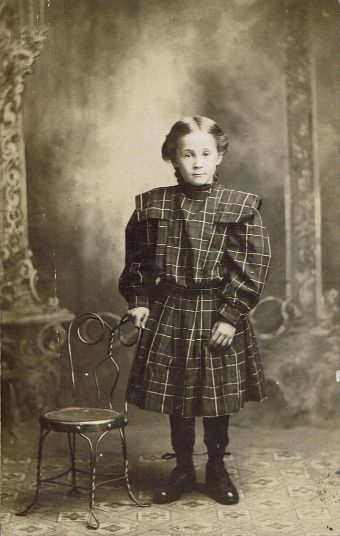 In the 1905 state census of Troy post office, Union township, Davis county, Iowa as Gladys Hissem, 2, of Iowa. In the 1910 census of Union township as Gladdis O. Hissem, 7, living with her parents, Arthur W. and Tillie E. Hissem, and brother, Leo W. In the 1915 state census of Douds Leando, Village township, Van Buren county as Gladys Hissem, 12. She had 5 years of schooling at that time. In the 1920 census of Village township, Van Buren county as Gladys Hissem, 17, still living at home with Arther [sic] and Tillie Hissem, and her brother, Leo.
In the 1905 state census of Troy post office, Union township, Davis county, Iowa as Gladys Hissem, 2, of Iowa. In the 1910 census of Union township as Gladdis O. Hissem, 7, living with her parents, Arthur W. and Tillie E. Hissem, and brother, Leo W. In the 1915 state census of Douds Leando, Village township, Van Buren county as Gladys Hissem, 12. She had 5 years of schooling at that time. In the 1920 census of Village township, Van Buren county as Gladys Hissem, 17, still living at home with Arther [sic] and Tillie Hissem, and her brother, Leo.
Gladys Opal Hissem, 21, the daughter of Arthur W. Hissem and Tillie E. Haney, married Leslie J. Boekhoff, 21, the son of Harry L. Boekhoff and Alberta Watkins, on 26 December 1923 in Ottumwa, Wapello county, Iowa. Leslie was born on 24 May 1902 to Harry [Harris] Albert Boekhoff and Alberta Watkins. Initially living in Harrison county, Iowa, by 1915 he and his parents were living in Van Buren county, Iowa. Leslie, the eldest, had four siblings, Vivian P., Leo S., Belle and Irma L.
In the 1925 state census of Village township, Van Buren county as Leslie, 22, and Gladys Boekhoff, 22. Leslie had 8 years of schooling and Gladys 12. It looks like her parents, Arthur, 59, and Tillie, 56, were living with them.
In the 1930 census of Chequest township, Van Buren county, Iowa as Gladys Boekleff, 27. Living with her were her husband, Leslie J., a 27 year old farmer, her daughter, Edna M. [Marylou], 5, and her father, Arthur W. Hissem, a 64 year old widower.
Gladys Opal Boekhoff was listed in the Old Age Pension Tax List of 1934, residing in Vill [Village township]. Leslie J. Boekhoff, the son of Harry Boekhoff and Bertha Watkins, was on the same list.
| Old Age Assistance Commission
An Extraordinary Session of the 45th Iowa General Assembly passed a law in March 1934 to create an Old Age Assistance Commission to oversee the care of the State's needy aged. Old Age Assistance was to be provided to indigent applicants who were over sixty-five years of age and who did not have any responsible relative capable of caring for them. To create a fund, a head tax of $1.00 the first year and $2.00 annually thereafter was to be collected from all persons over twenty-one years old. The law provided that each assessor, at the time of listing property for assessment, was to prepare a list and return it to the county auditor with the names of those subject to the new tax. The law was repealed in 1937. The assessor did not determine who was eligible for benefits. This was done by filing an application with the county Old Age Assistance boards. The lists, therefore, contain the names of a great many persons over the age of sixty-five, some of whom later received benefits under the law. |
In the 1940 census of Village township, Van Buren county, Iowa as Lesley J. Bochoff [sic], a 37 year old farmer, and Gladys O. Bochoff, 37. Living with them was their daughter, Maryln E. Bochoff, 15.
Leslie died on 3 August 1947.
3 September 1947I don't see this internment listed for the Mt. Moriah cemetery of Van Buren county, Iowa."Funeral services for Leslie J. Boekhoff, 45, were held at the Pedrick Funeral home in Douds on Wednesday, Sept. 3, with the Rev. J.C. Austin in charge. Special music was given by Jay Doud, R.V. Finney, R.W. Jacobson, and Forrest Hanshaw, with Mrs. Harold Harryman as pianist.
Interment was in the Mt. Moriah cemetery. Pallbearers were Curtis Williamson, Dale Holcomb, Claude Findley, Kenneth Lagle, Dave Laughlin, and Weldon Kunzman.
Leslie J. Boekhoff, eldest son of Harry and Alberta Boekhoff, was born in Harrison County, Iowa, May 24, 1902, and departed this life August 31, 1947, at Ottumwa, at the age of 45 years, 3 months and 7 days.
He moved to Keosauqua, Iowa when a small boy where he grew into manhood, moving to the Douds vicinity 25 years ago. On December 26, 1923, he was united in marriage to Gladys Opal Hissem and to this union was born one daughter, Edna Marylou.
He leaves to mourn his passing, his wife and daughter, his father, Harry Boekhoff of Ottumwa; one brother, Leo Boekhoff of Ottumwa; two sisters, Mrs. Vivian Rhoadus of Ottumwa and Mrs. Belle Miller of Milton; and several nieces and nephews; and a host of other relatives and friends.
He was preceded in death by his mother and two sisters, Edma Marie Boekhoff and Mrs. Irma Brooks." - from the Van Buren Co. Genealogical Society Obituary Book C, Page 355, Keosauqua Public Library, Keosauqua, IA
After Leslie's death Gladys married Everett Marsh. Gladys Opal Hissem Marsh died on 31 May 1989 in Sioux Falls, Minnehaha county, South Dakota. She was buried in the Mount Moriah cemetery in Douds, Van Buren county, Iowa. Her obituary,
"Gladys Marsh
DOUDS - Gladys O. Marsh, 86, died May 31, 1989, at Mom and Dad's Nursing Home in Sioux Falls, S.D.
She was born Oct. 21, 1902, in Davis County to Arthur and Tillie Haney Hissem. She grew up in Davis County and graduated from Douds High School. She married Leslie Boekhoff on Dec. 26, 1923; they farmed near Douds. He died in 1947. She married Everett Marsh; they farmed near Eldon. He died in 1977, after which she moved to Sioux Falls to live with her daughter.
She is survived by a daughter, Marylan McClellan of Sioux Falls; two granddaughters; three great-grandchildren; and a great-great-granddaughter.
The service will be 1 p.m. Friday at Pedrick Funeral Home in Douds. Burial will be in Mount Moriah Cemetery north of Douds."
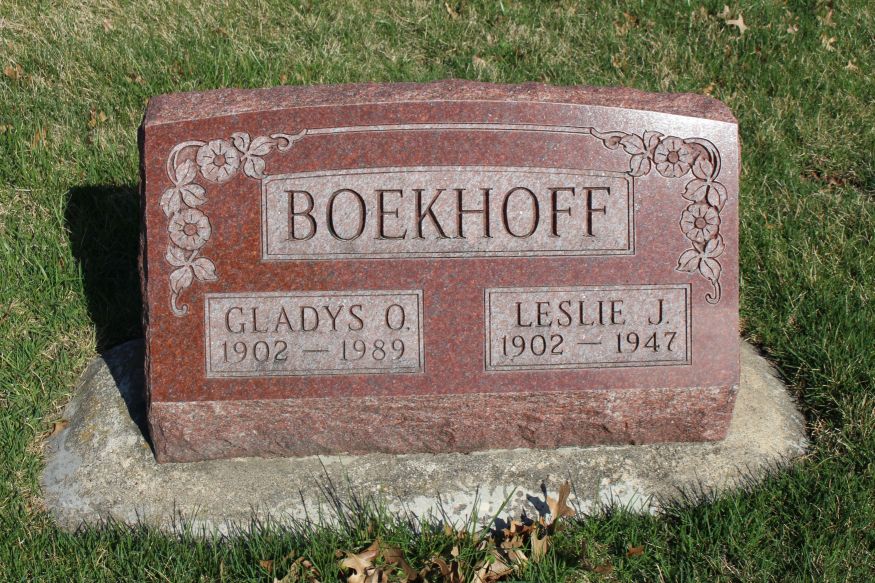
Gladys and Leslie's child was,
(26) Edna Marylan Boekhoff (1925)Edna Marylou [sic] Boekhoff, the daughter of Leslie Boekhoff and Gladys Hissem, was born on 18 February 1925 in Iowa. She married Coy Clinton McClellan, the son of Otha A. McClellan and Veda Fern Cain, on February 26, 1948. Coy was born on 22 December 1925 in Lucas, Iowa.
"[Edna] Born 1925-00-00 in Leando (USA) to Leslie J. Boekhoff and Gladis O. Hissem. Died 2005-03-25, buried in Las Vegas (NE) (USA). Home in 1930: Chequest, Van Buren, IowaCoy died in 2018.
[Obituary] The Ottumwa Courier (Mar/30/2005): A resident of Ottumwa before moving to Sioux Falls, S.D. in 1973 and then to Las Vegas, Nev. in 1989, she was an employee of John Morrell and Company for 38 years. She was a member of O.B. Nelson Unit #3 of the American Legion Auxiliary. Survivors include her husband; daughter, Candice Eakins of Silvis, Ill.; stepdaughter, Linda Sue Preston of Des Moines; three grandchildren; and three great-grandchildren. She was preceded in death by her parents; and stepfather, Everett Marsh. Funeral services will be 10 a.m. Thursday at Reece Funeral Home; the Rev. David Albert officiating. Burial will be in Memorial Lawn Cemetery. Visitation will begin after 1 p.m. Wednesay at the funeral home with the family present from 5-7 p.m. Memorials may be made to Solari Hospice Care, Las Vegas, Nev." - from The Boekhoff Family Tree website
"Coy C. McClellan, 92, of East Moline, IL, formerly of Ottumwa, died June 3, 2018 in Rock Island, IL. He was born December 22, 1925 in Osceola, IA to Otha and Veta Cain McClellan. He married Marylan Boekhoff on February 26, 1948. She preceded him in death March 25, 2005. He proudly and honorably served in the U.S. Navy during World War II. He retired from John Morrell & Co. after working for 39 years."Edna and Coy had two daughters, Candice Eakins of Coal Valley, Illinois and Linda Preston of Des Moines. (27) Candice McClellan (c1955)
I recently received the following,
"Hi, I am the daughter of Edna Marylan Boekoff McClellan. She was married to Coy Close noon McClellan. My married name is Eakins. I did not know your father but mom spoke of him many times. I knew his sister Alice Rogers very well. My grandmother was Gladys . . . Mom passed away in 2005 and I lost dad this year [2018]. We have done some genealogy searching also and now my daughter is getting interested. There are very few of us left that I know of. Thank you so much for responding. It is exciting to me to find relatives I did not know about. I am planning to keep your email and hopefully we can keep in touch. We live in iL. Thank you again.
Candy"